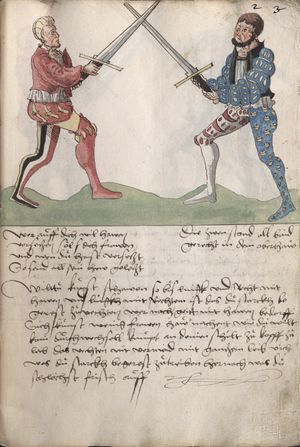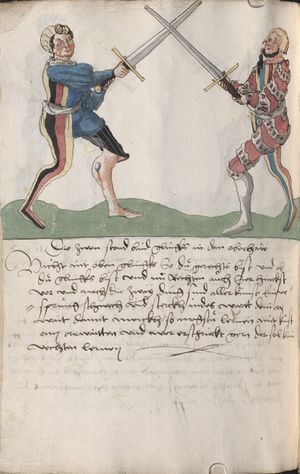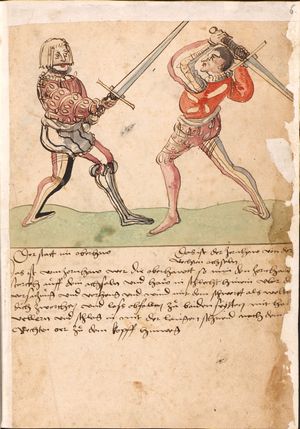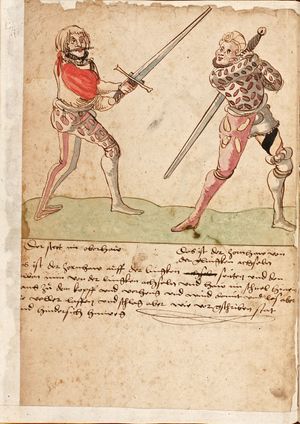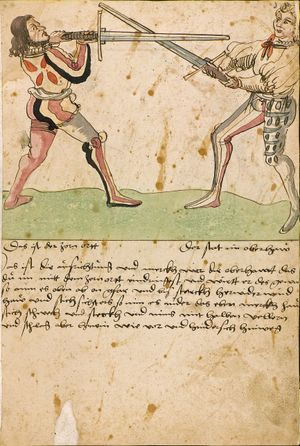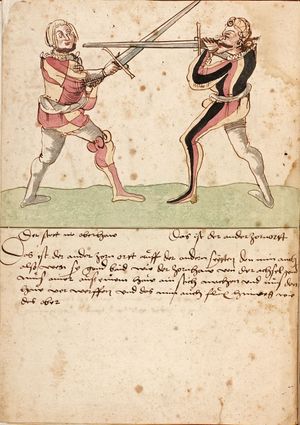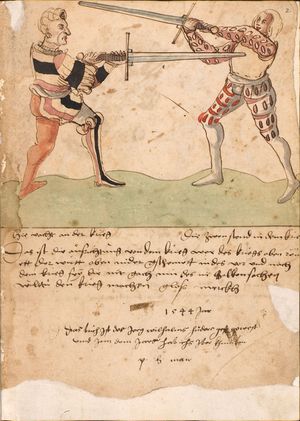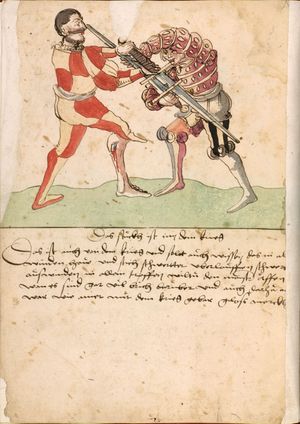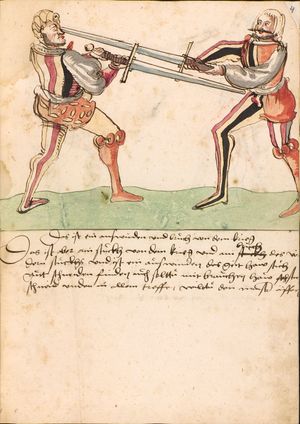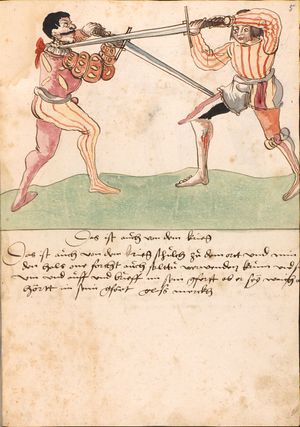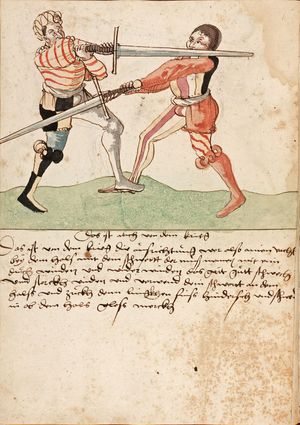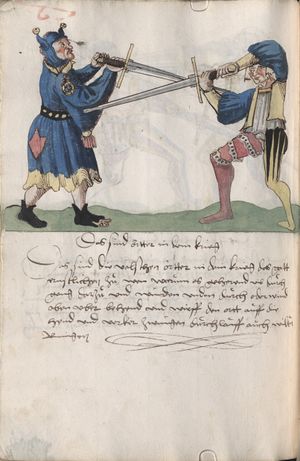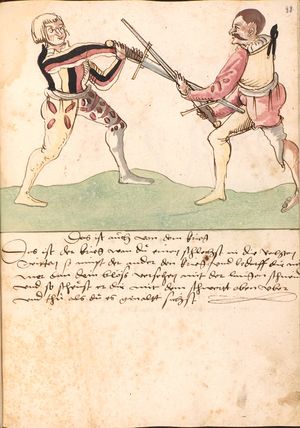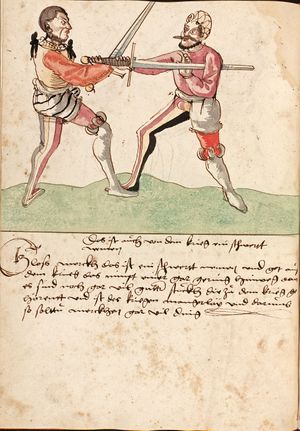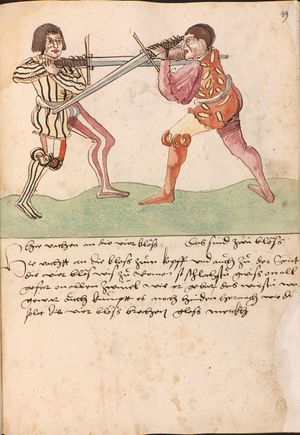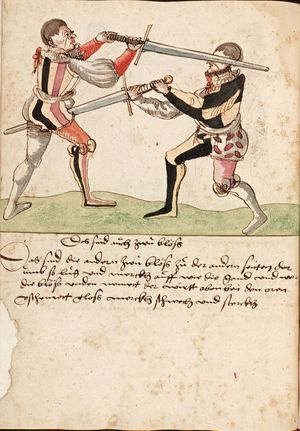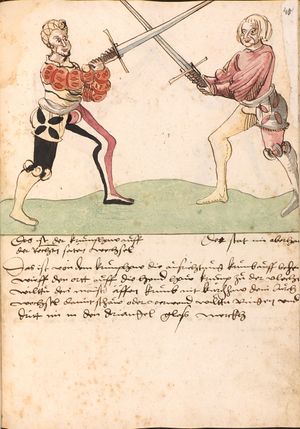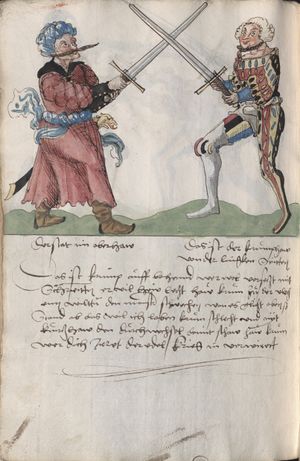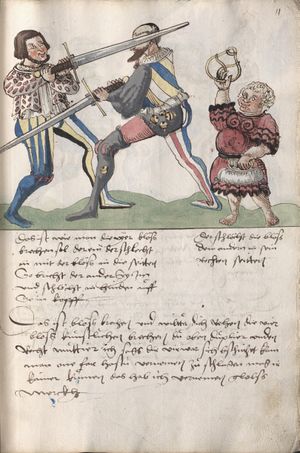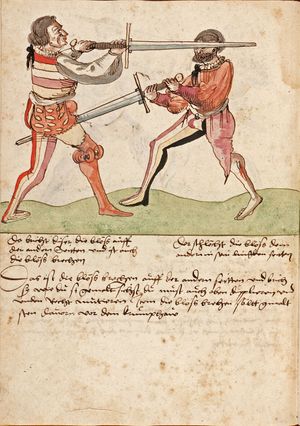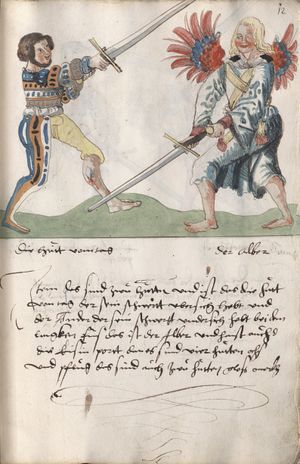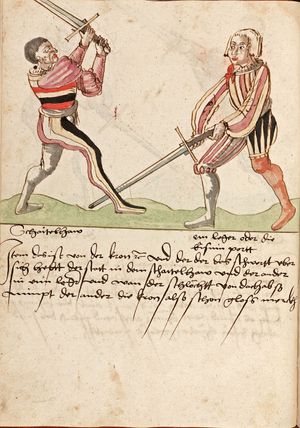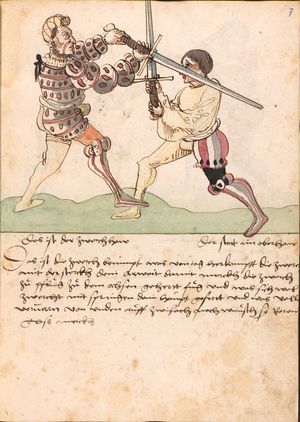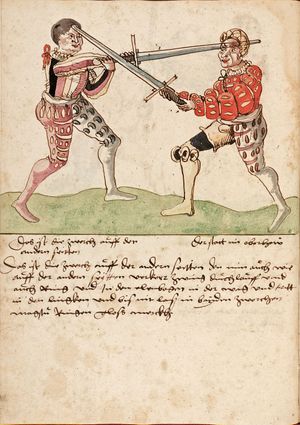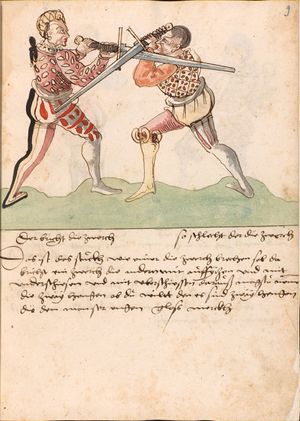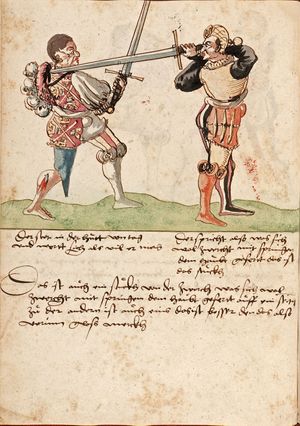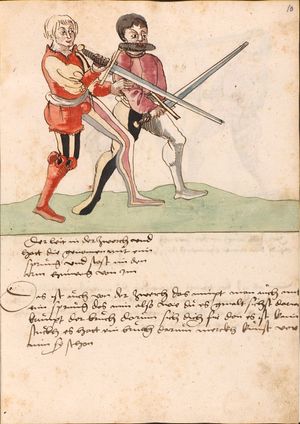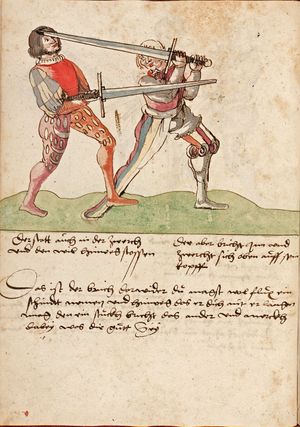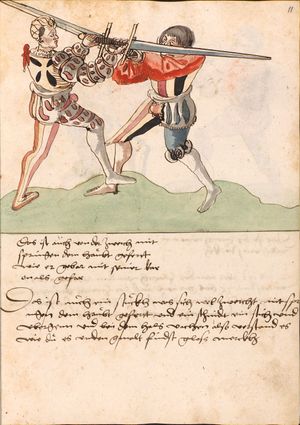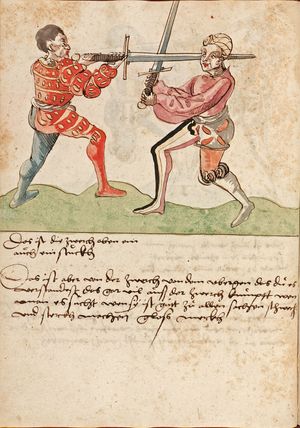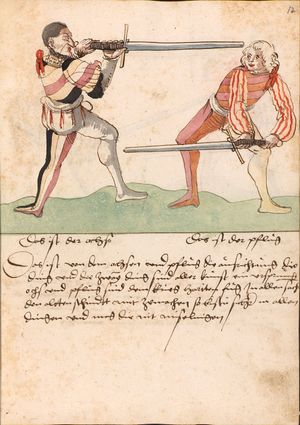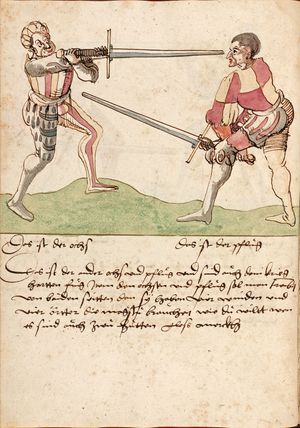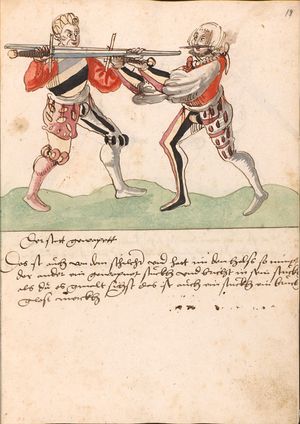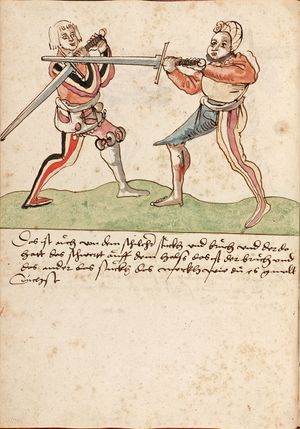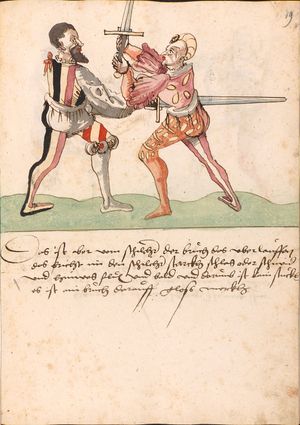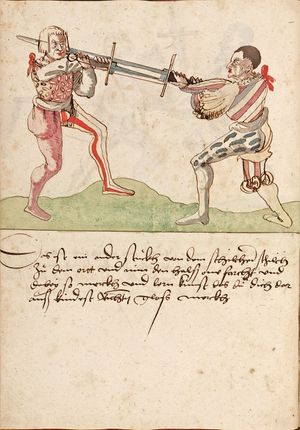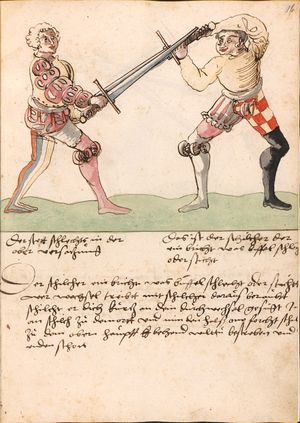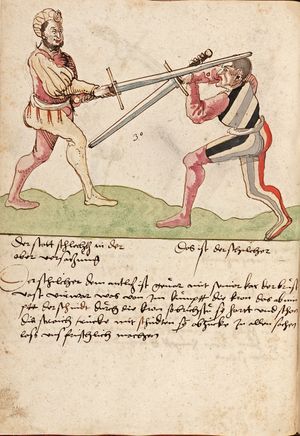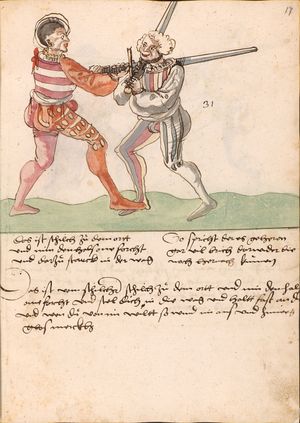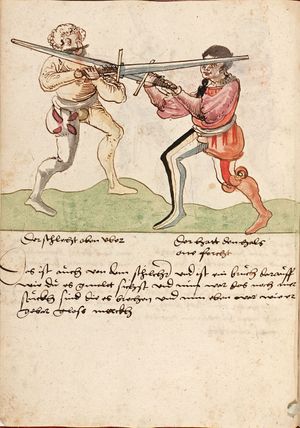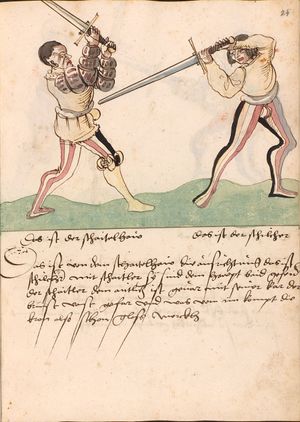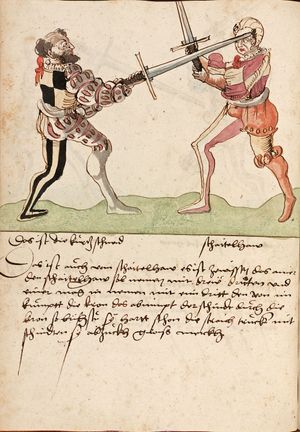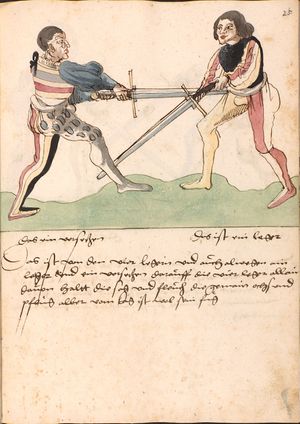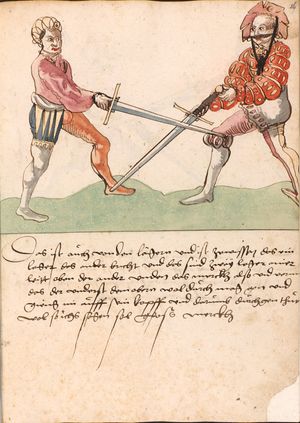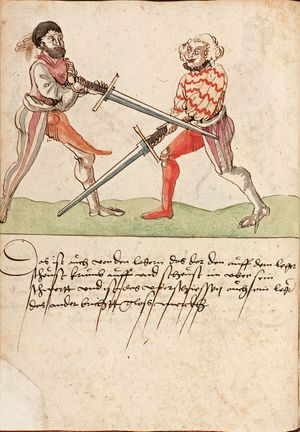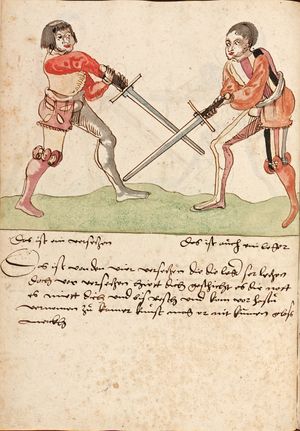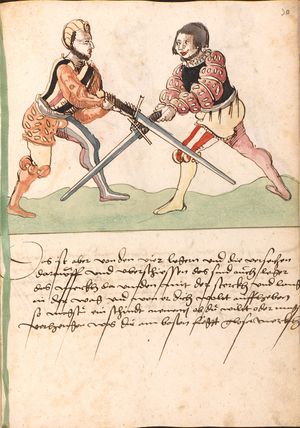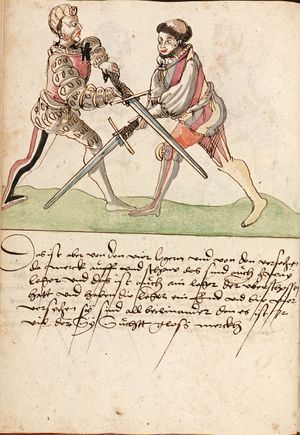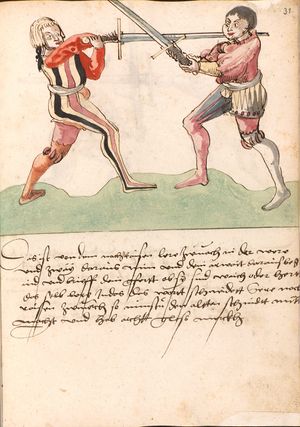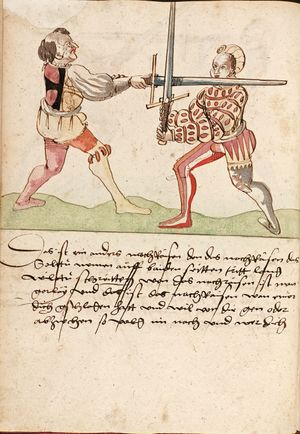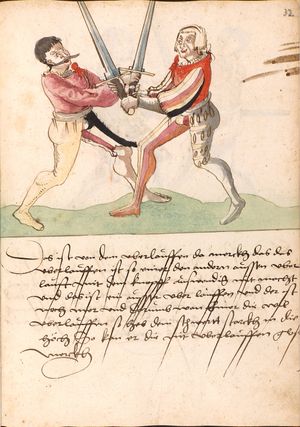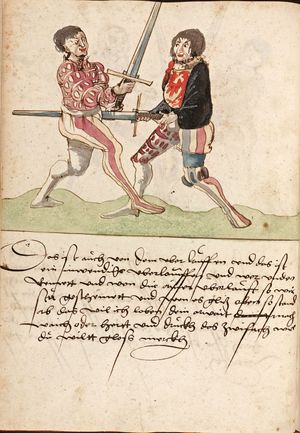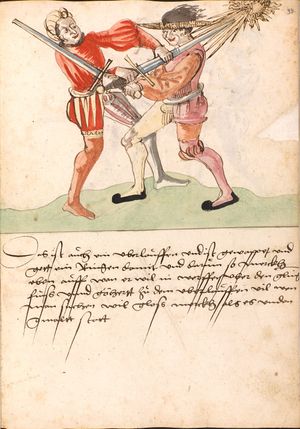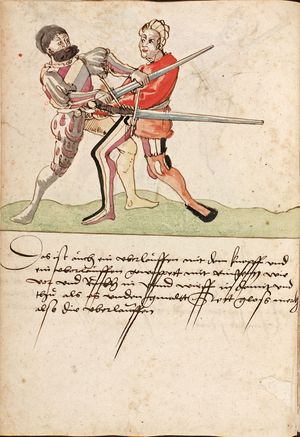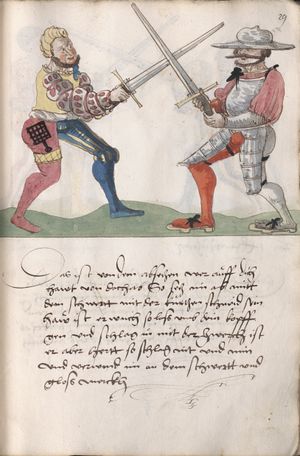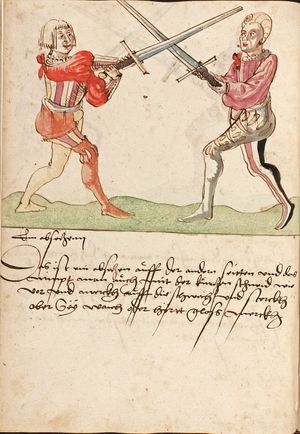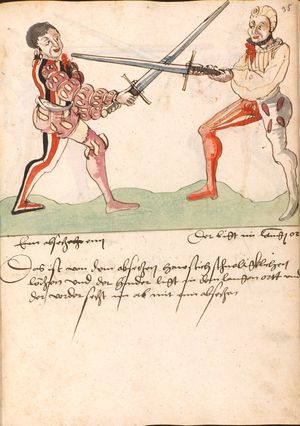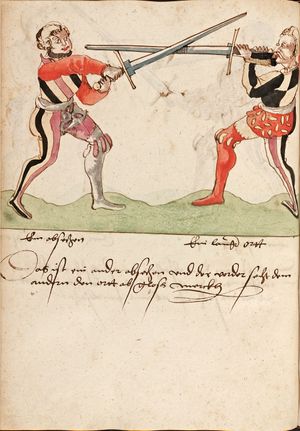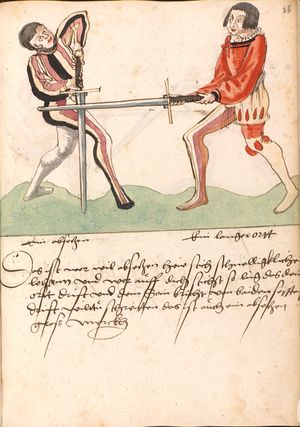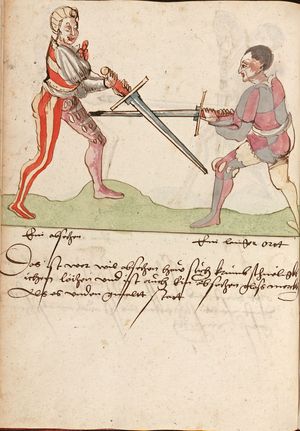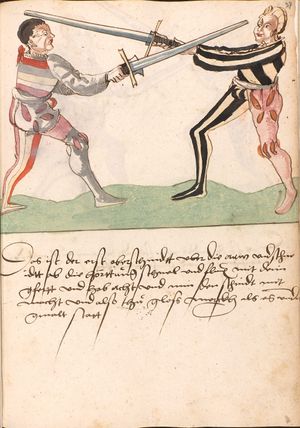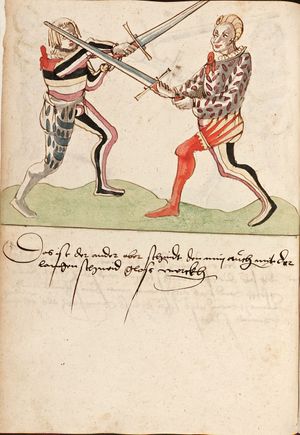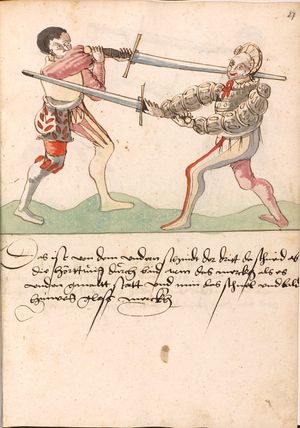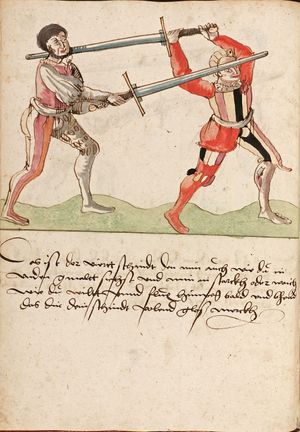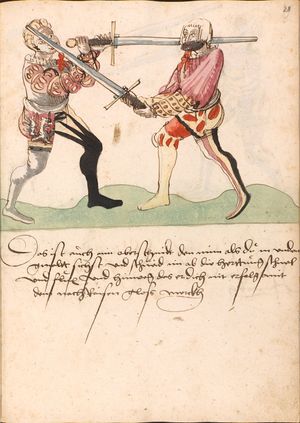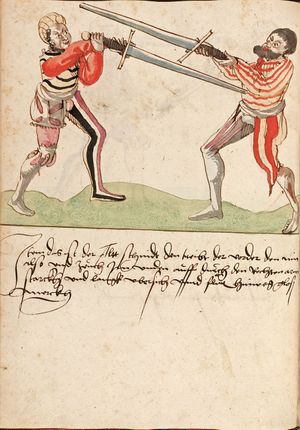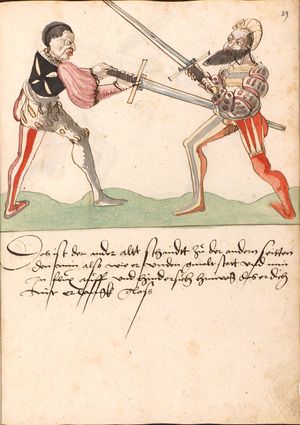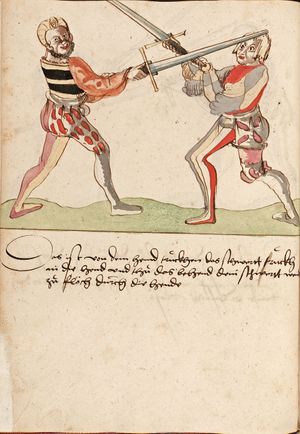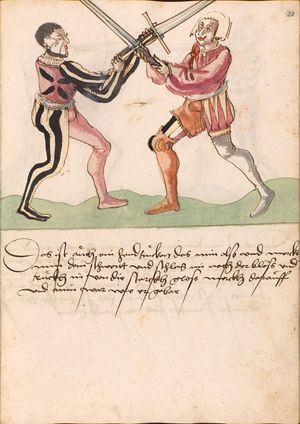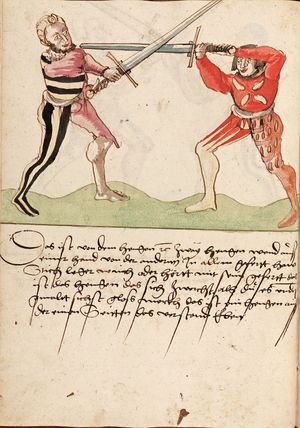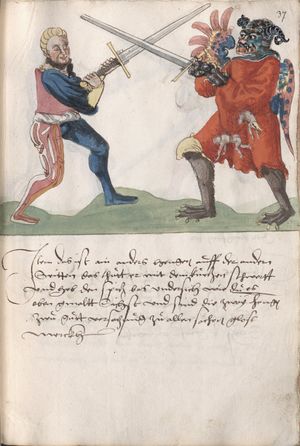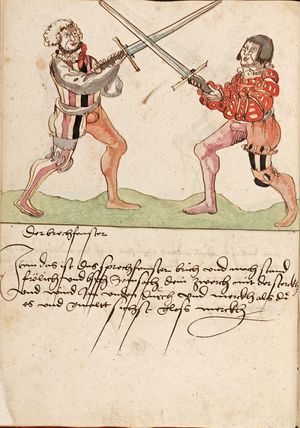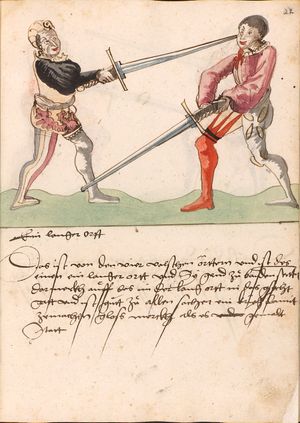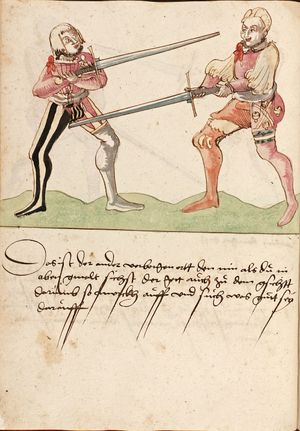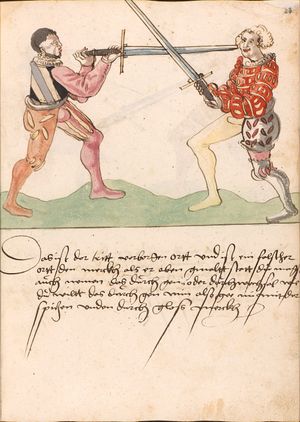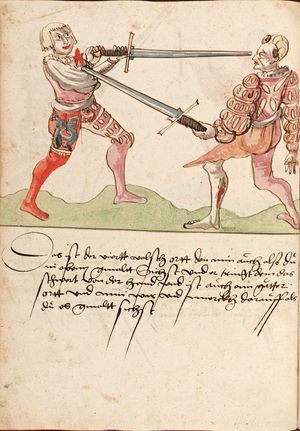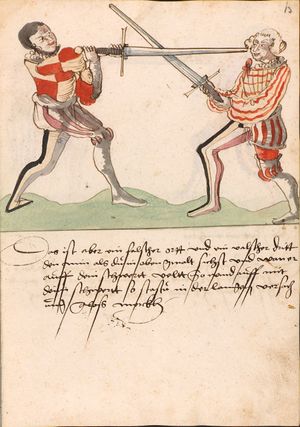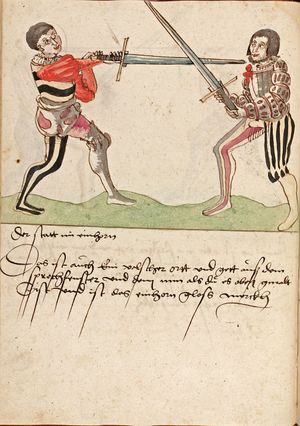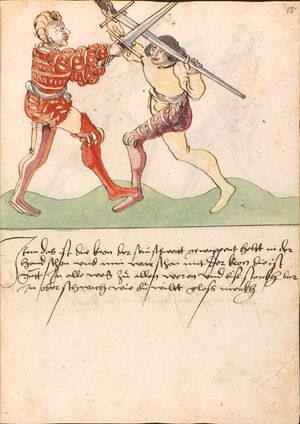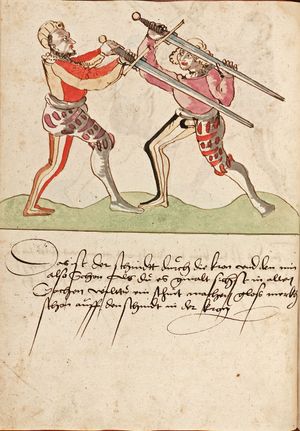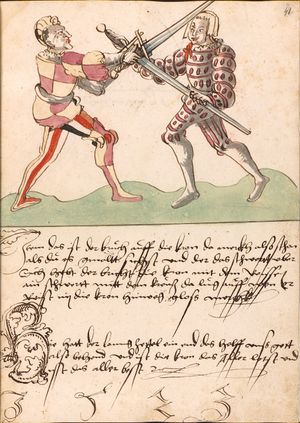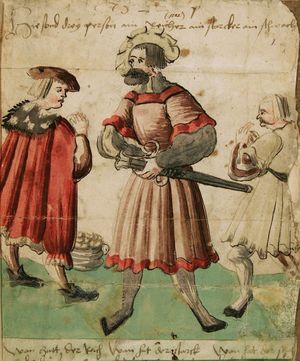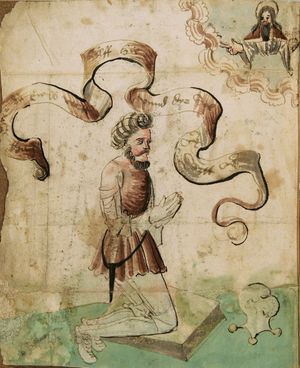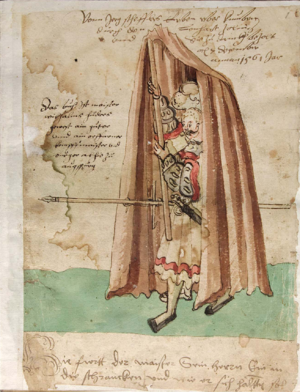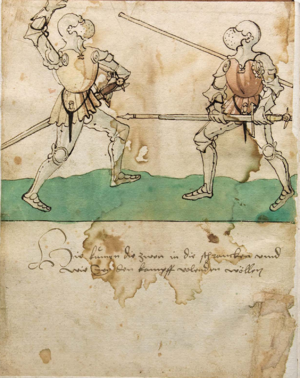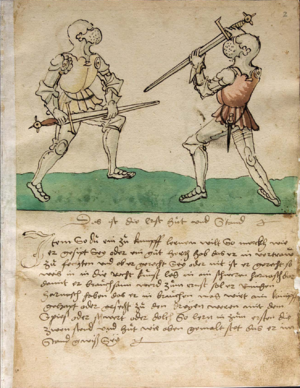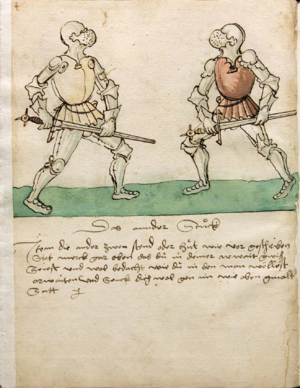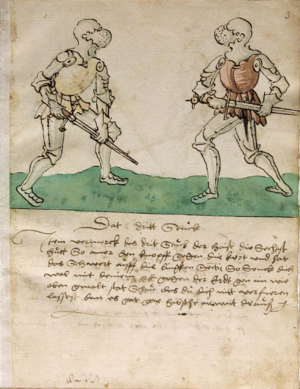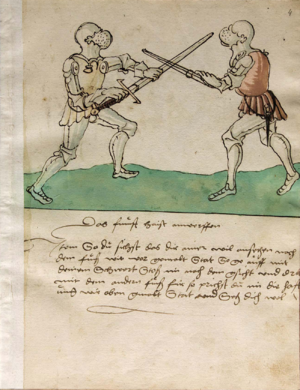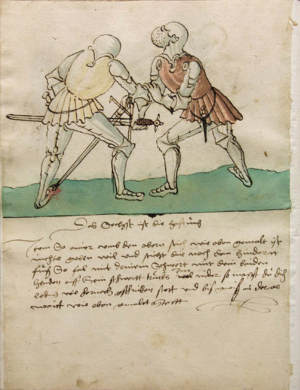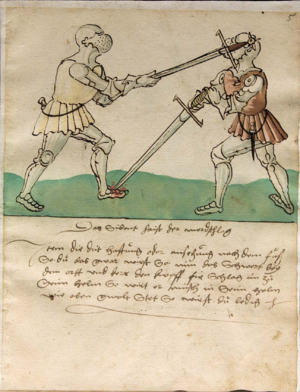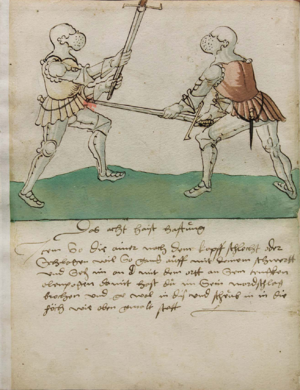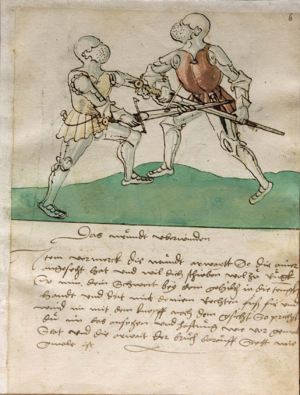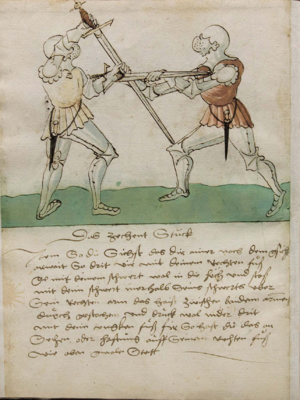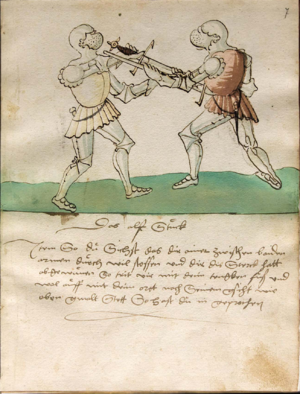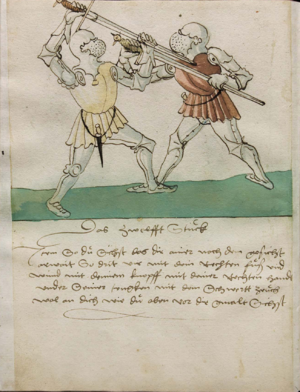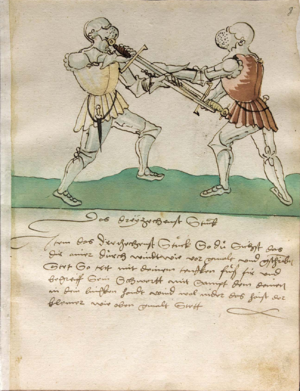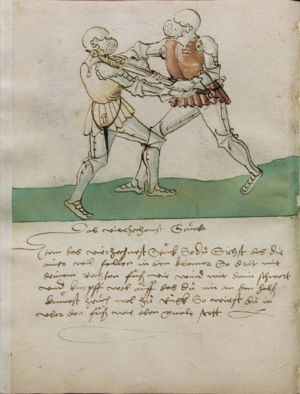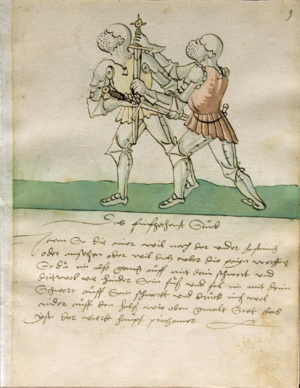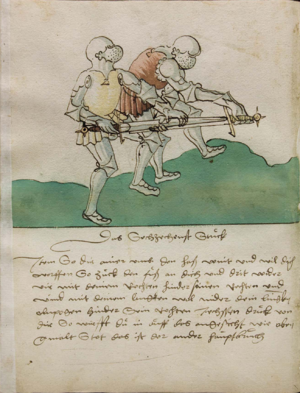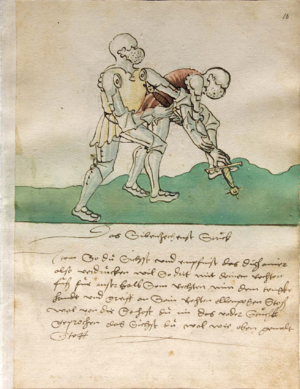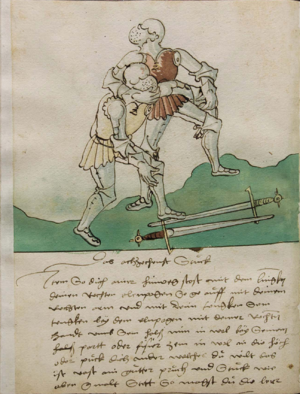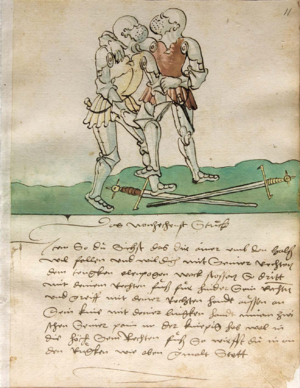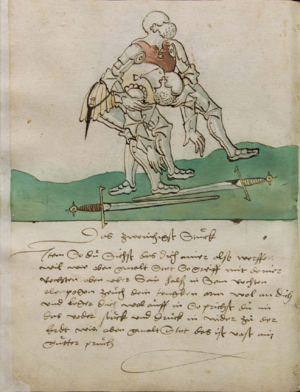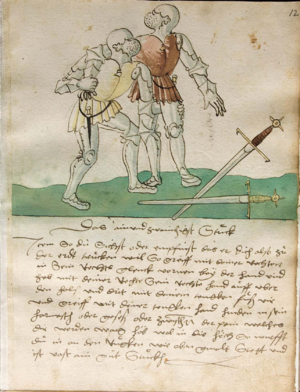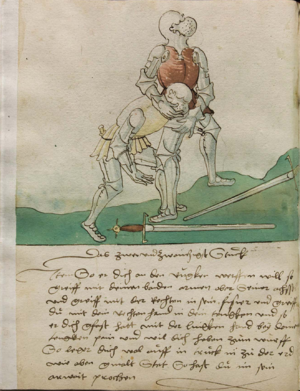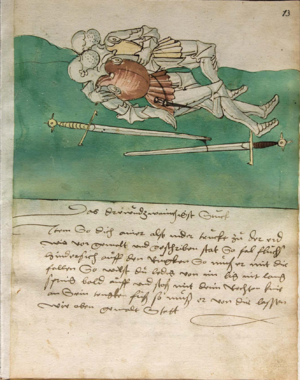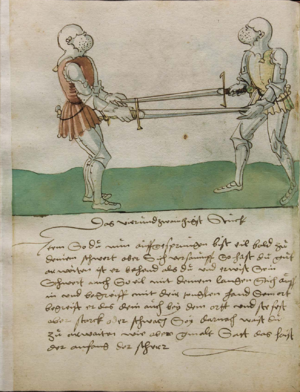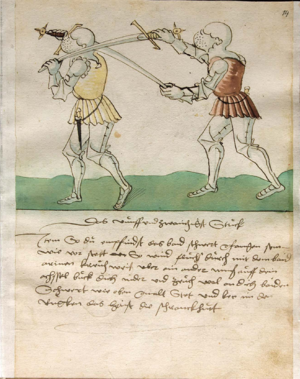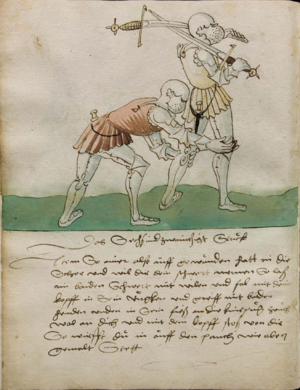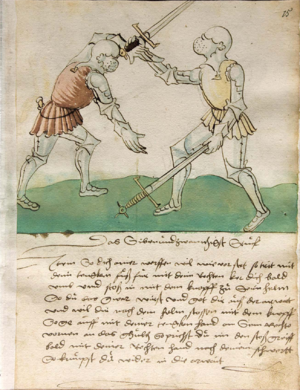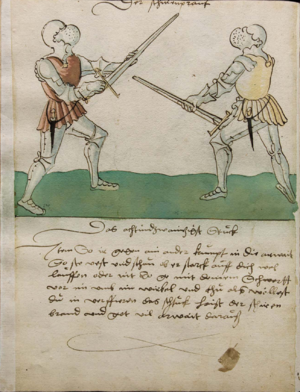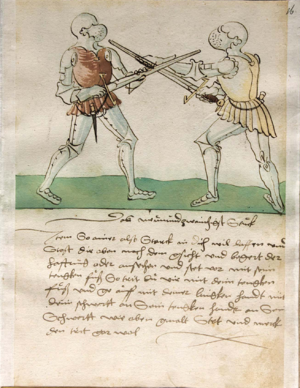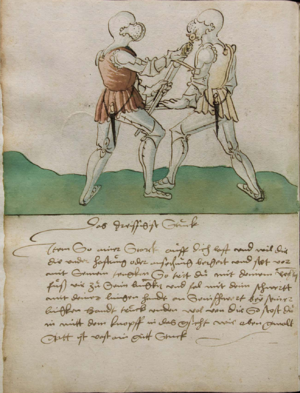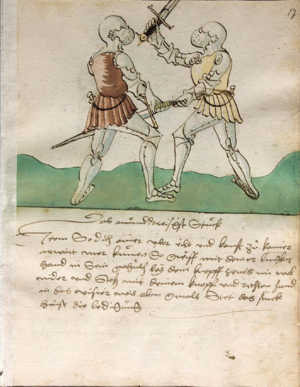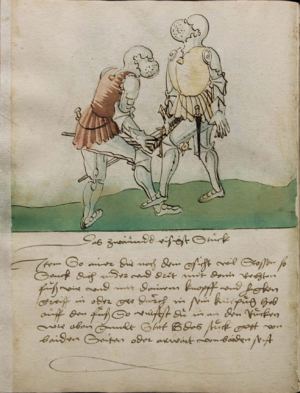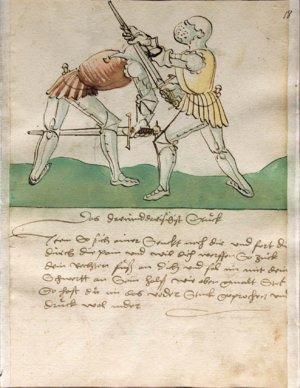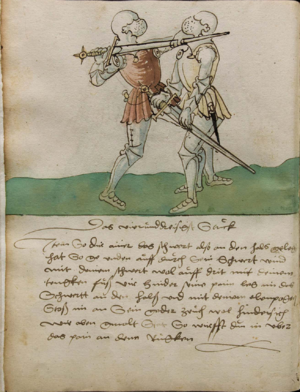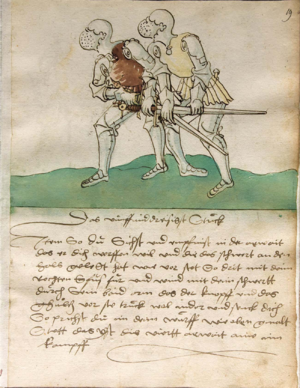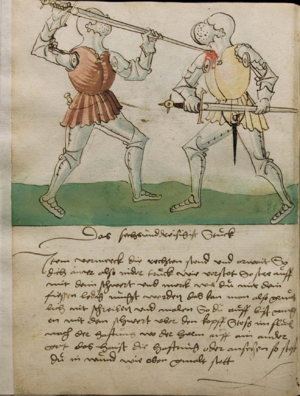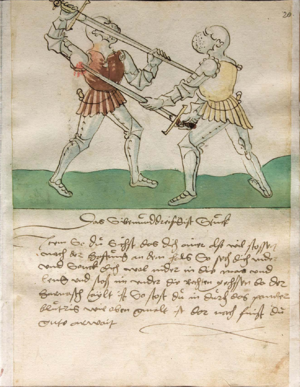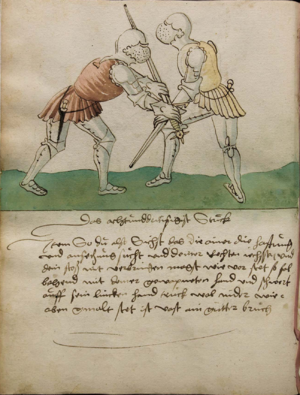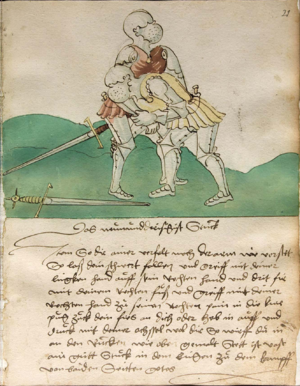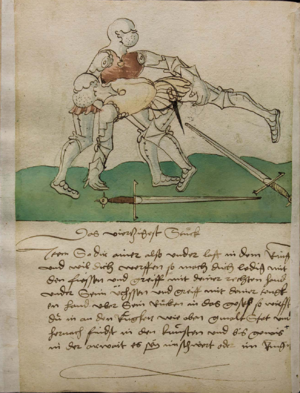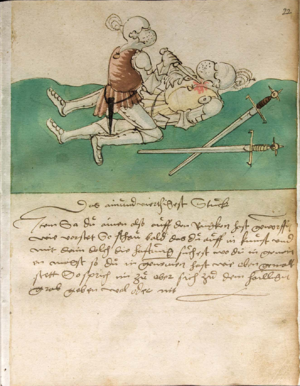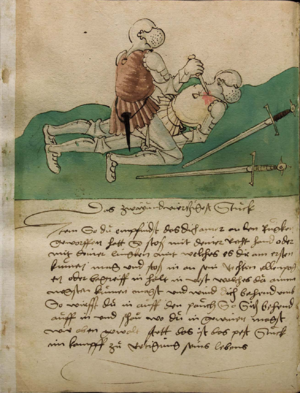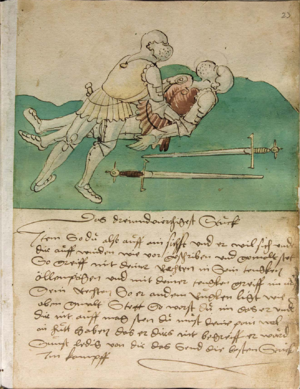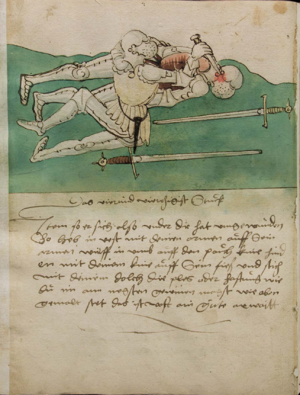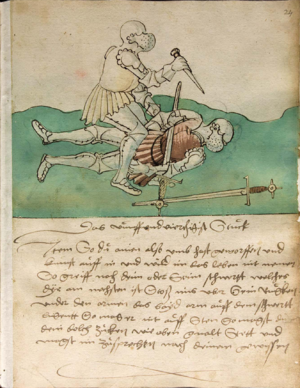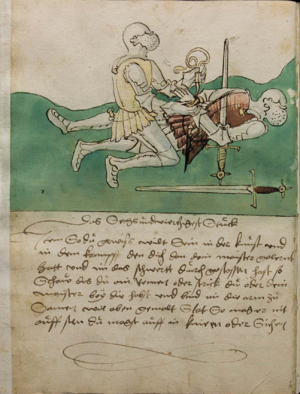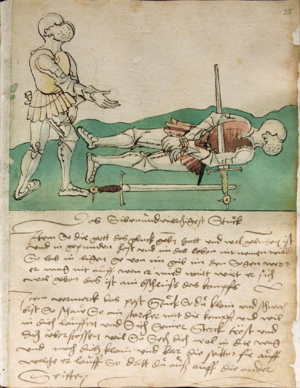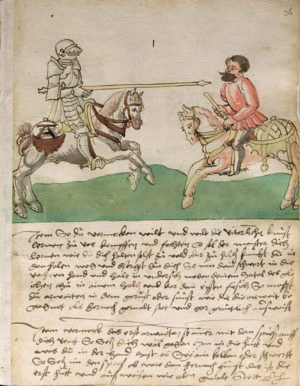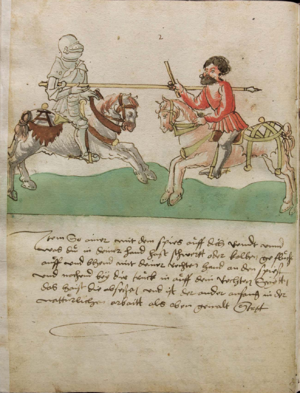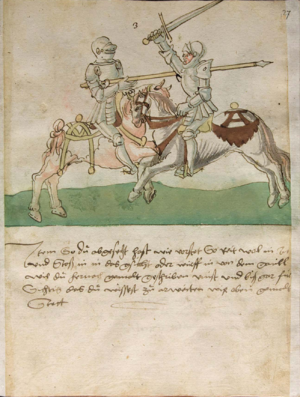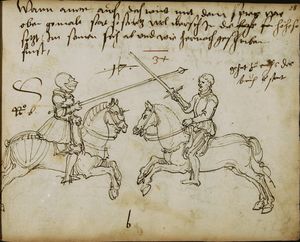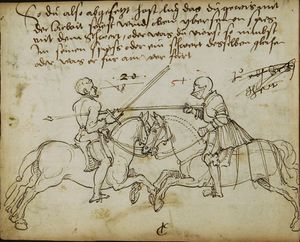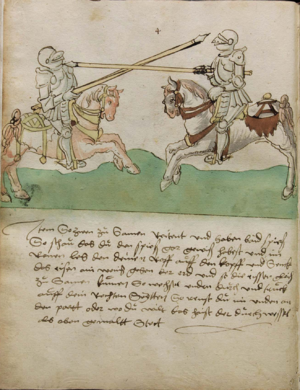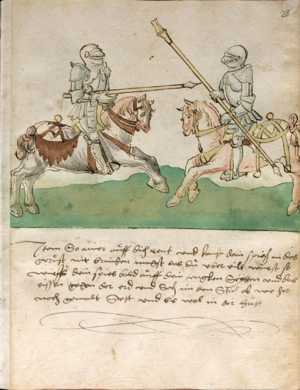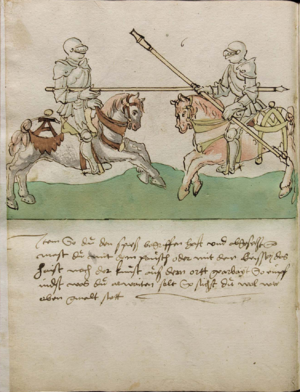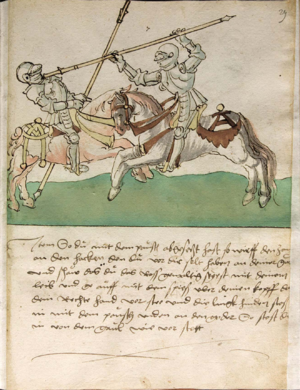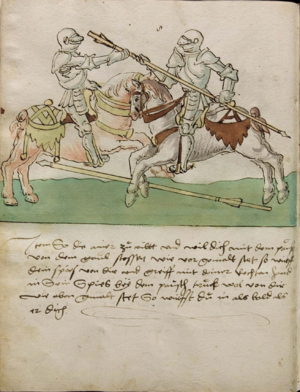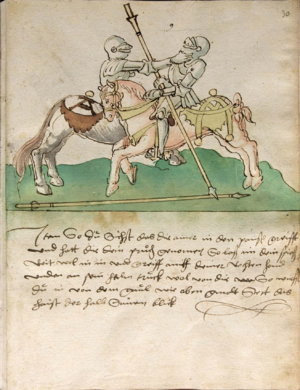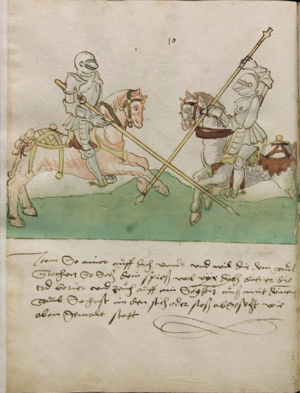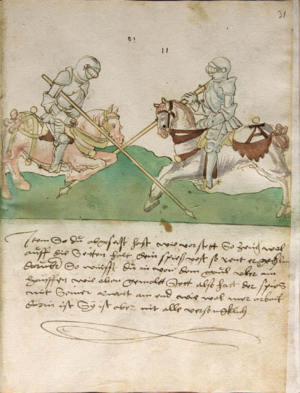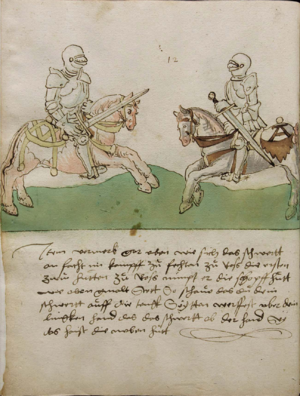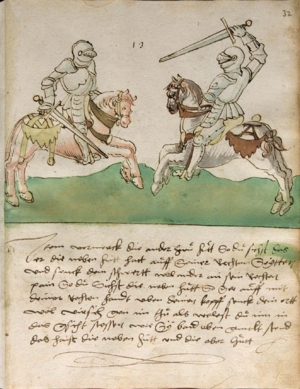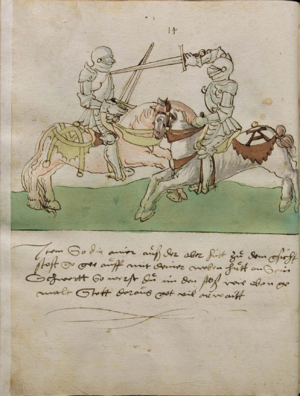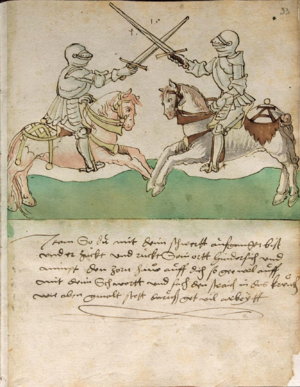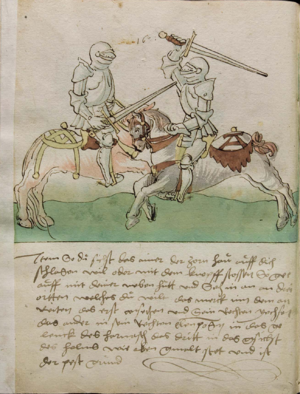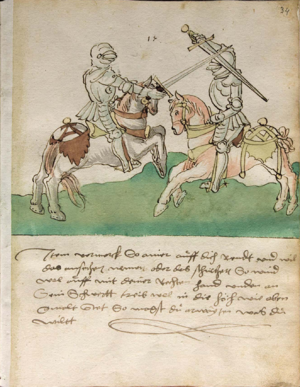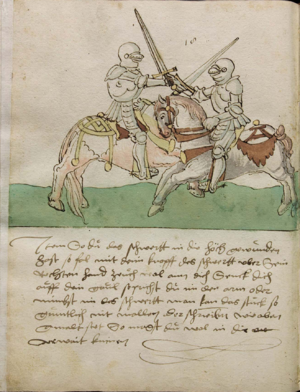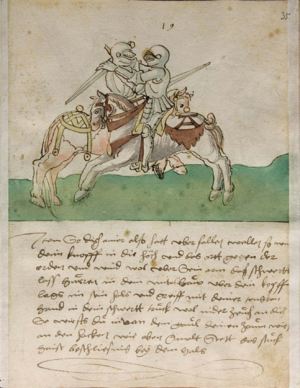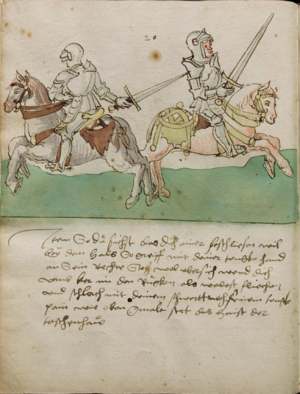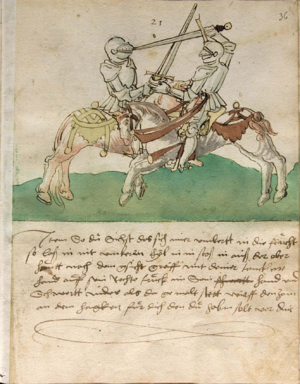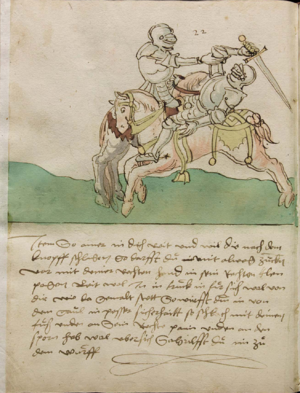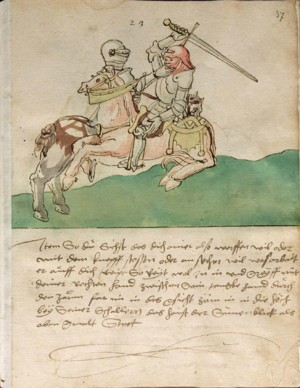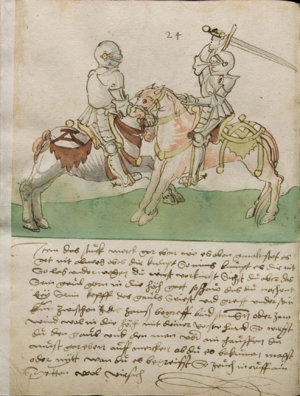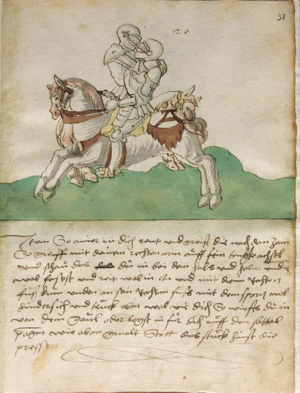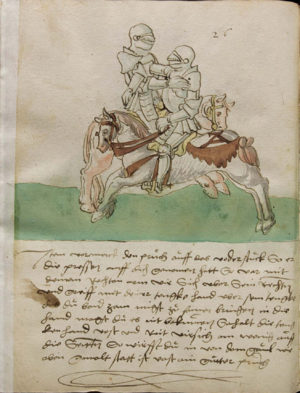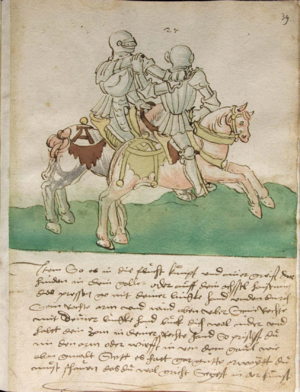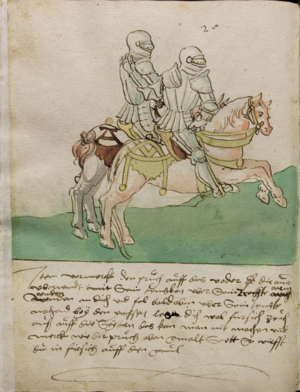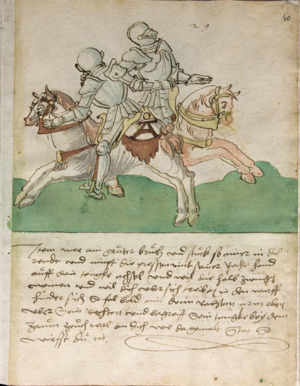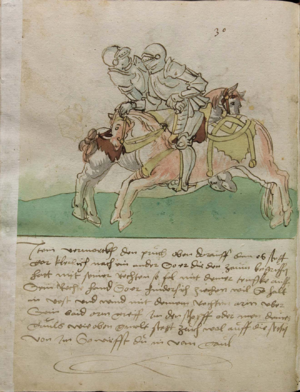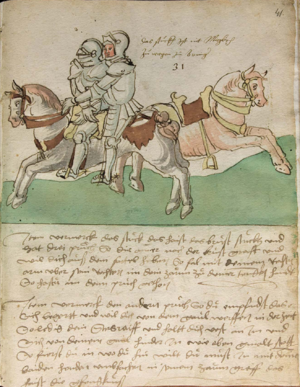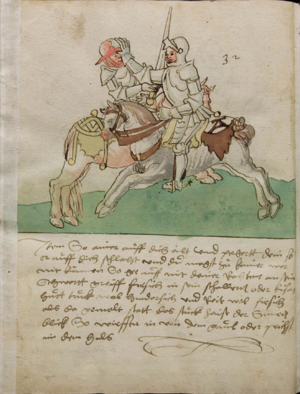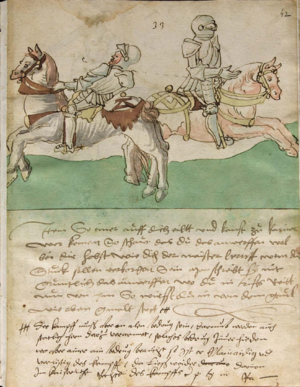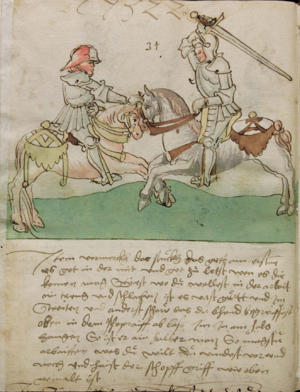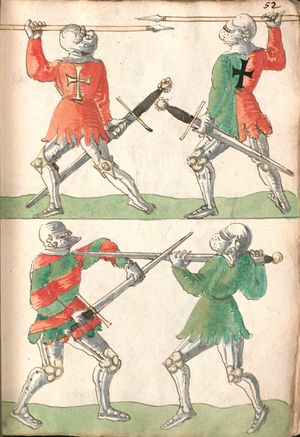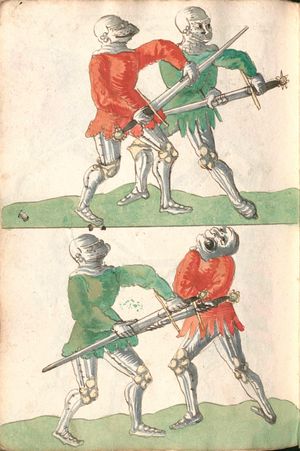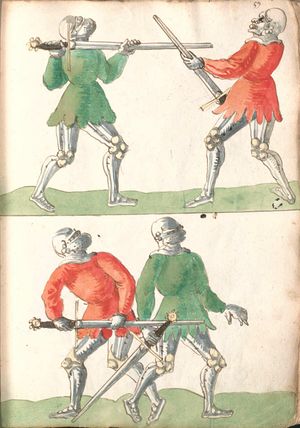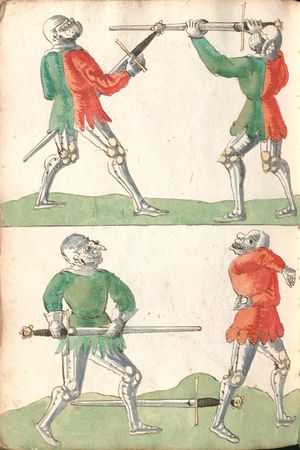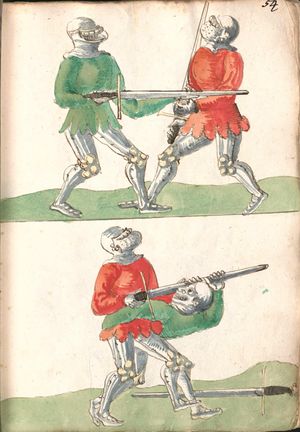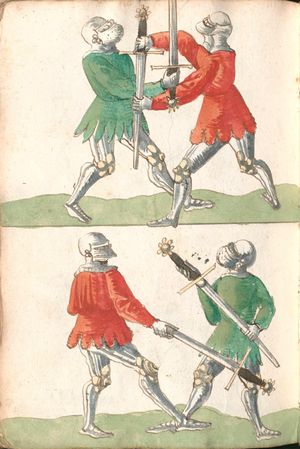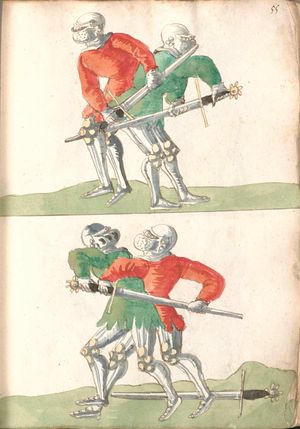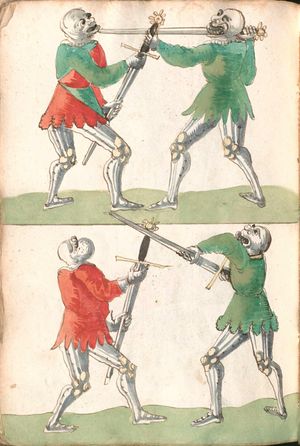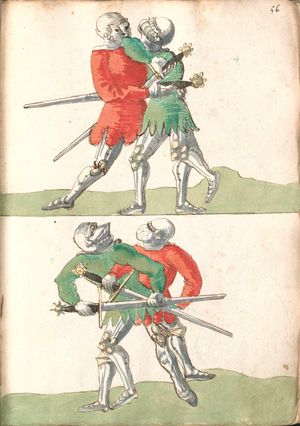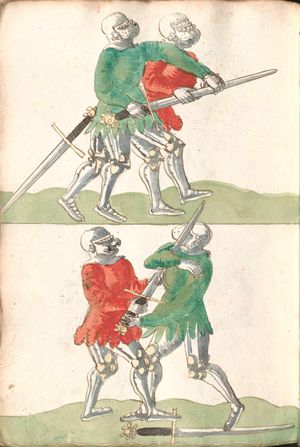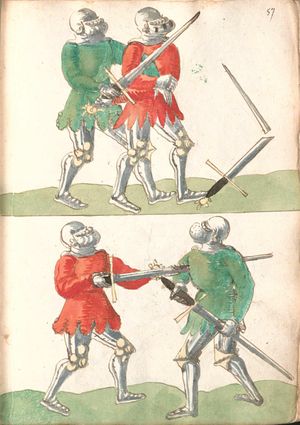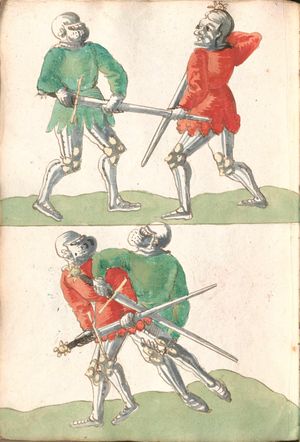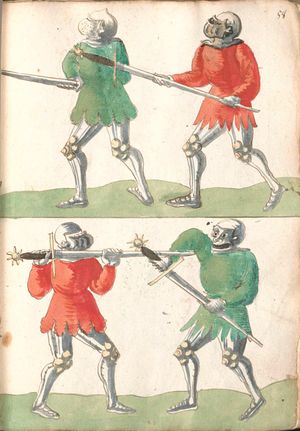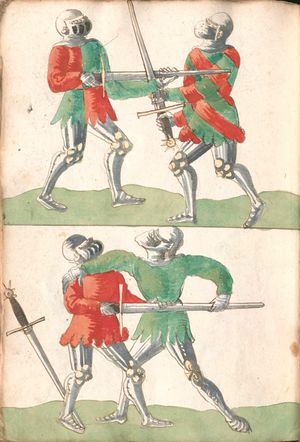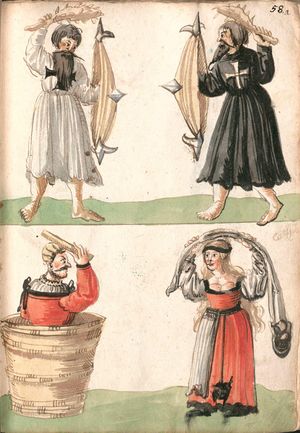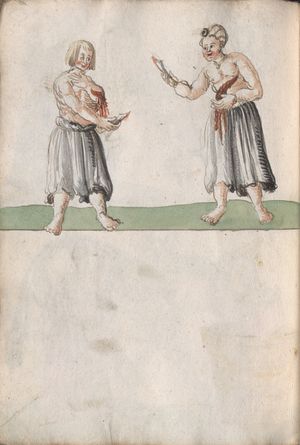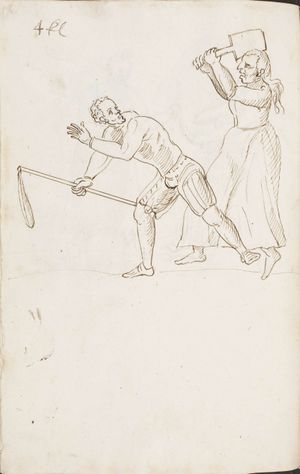|
|
You are not currently logged in. Are you accessing the unsecure (http) portal? Click here to switch to the secure portal. |
Difference between revisions of "Jörg Wilhalm"
| Line 414: | Line 414: | ||
<p>This is about the crooked hew, the direction:</p> | <p>This is about the crooked hew, the direction:</p> | ||
| − | + | {| class="zettel" | |
| − | < | + | |- |
| − | + | | <small>42</small> | |
| + | | Crook on nimbly,<br/>throw the point upon the hands. | ||
| + | |- | ||
| + | | <small>44</small> | ||
| + | | Hew crooked to the flats<br/>if you want to weaken the masters. | ||
| + | |- | ||
| + | | <small>46</small> | ||
| + | | Don’t hew crooked, hew short,<br/>with it show your change through, | ||
| + | |} | ||
<p>or use if you want to wrestle, and step to him in the triangle. Gloss note.</p> | <p>or use if you want to wrestle, and step to him in the triangle. Gloss note.</p> | ||
| {{paget|Page:Cod.I.6.2º.2|40r|jpg}} | | {{paget|Page:Cod.I.6.2º.2|40r|jpg}} | ||
| Line 431: | Line 439: | ||
<p>That is, crook on nimbly.</p> | <p>That is, crook on nimbly.</p> | ||
| − | + | {| class="zettel" | |
| − | < | + | |- |
| + | | <small>43</small> | ||
| + | | Whoever parries well<br/>with striding, he destroys many hews. | ||
| + | |- | ||
| + | | <small>44</small> | ||
| + | | Hew crooked to the flats<br/>if you want to weaken the masters. | ||
| + | |- | ||
| + | | <small>45</small> | ||
| + | | When it sparks above,<br/>stand away, that I want to praise. | ||
| + | |- | ||
| + | | <small>46</small> | ||
| + | | Strike crooked and not short hew,<br/>with it show the change through. | ||
| + | |- | ||
| + | | <small>48</small> | ||
| + | | Hew crooked whoever errs you,<br/>the noble war confuses him. | ||
| + | |} | ||
| {{paget|Page:Cod.I.6.2º.2|40v|jpg}} | | {{paget|Page:Cod.I.6.2º.2|40v|jpg}} | ||
| {{paget|Page:Cgm 3711|10v|jpg}} | | {{paget|Page:Cgm 3711|10v|jpg}} | ||
| Line 447: | Line 470: | ||
<p>This is to break openings,</p> | <p>This is to break openings,</p> | ||
| − | < | + | {| class="zettel" |
| − | + | |- | |
| + | | <small>38</small> | ||
| + | | and you want to reckon yourself,<br/>artfully break the four openings, | ||
| + | |- | ||
| + | | <small>39</small> | ||
| + | | you double above,<br/>rightly mutate below. | ||
| + | |- | ||
| + | | <small>40</small> | ||
| + | | I say to you truthfully,<br/>no man protects himself without danger. | ||
| + | |- | ||
| + | | <small>41</small> | ||
| + | | If you have heard,<br/>he may come to hit nobody. | ||
| + | |} | ||
<p>That I have heard. Gloss note.</p> | <p>That I have heard. Gloss note.</p> | ||
| {{paget|Page:Cod.I.6.2º.2|08r|jpg}} | | {{paget|Page:Cod.I.6.2º.2|08r|jpg}} | ||
| Line 500: | Line 535: | ||
:He stands in the over hew | :He stands in the over hew | ||
| − | + | {| class="zettel" | |
| − | < | + | |- |
| − | + | | <small>49</small> | |
| + | | This is the thwart, it takes<br/>what comes from the day, | ||
| + | |- | ||
| + | | <small>50</small> | ||
| + | | then thwart with the strong,<br/>with it note your work. | ||
| + | |- | ||
| + | | <small>51</small> | ||
| + | | The thwart to plow,<br/>join hard to the ox, | ||
| + | |- | ||
| + | | <small>52</small> | ||
| + | | and who thwarts themselves well,<br/>with jumping threatens your head,</p> | ||
| + | |} | ||
<p>and whoever directs the failer on from below two times aims as he wishes. Gloss note.</p> | <p>and whoever directs the failer on from below two times aims as he wishes. Gloss note.</p> | ||
| {{paget|Page:Cod.I.6.2º.2|07r|jpg}} | | {{paget|Page:Cod.I.6.2º.2|07r|jpg}} | ||
| Line 540: | Line 586: | ||
| <p>[27] He stands in the guard from day and raises as much as he likes</p> | | <p>[27] He stands in the guard from day and raises as much as he likes</p> | ||
| − | :He speaks thusly: “Whatever thwarts itself well, moves to the head with jumping.” This is the play | + | :He speaks thusly: “Whatever thwarts itself well, moves to the head with jumping.”<ref>Verse 52</ref> This is the play |
<p>This is also a play from the thwart: Whatever thwarts itself well moves to the head with jumping from one side to the other, is also one that is better than that, therefore hear. Gloss note.</p> | <p>This is also a play from the thwart: Whatever thwarts itself well moves to the head with jumping from one side to the other, is also one that is better than that, therefore hear. Gloss note.</p> | ||
| Line 664: | Line 710: | ||
:This is the squinter which breaks in what a buffalo hits or stabs | :This is the squinter which breaks in what a buffalo hits or stabs | ||
| − | + | {| class="zettel" | |
| − | < | + | |- |
| + | | <small>58</small> | ||
| + | | The squinter breaks in<br/>what a buffalo hits or stabs. | ||
| + | |- | ||
| + | | <small>59</small> | ||
| + | | Whoever drives to change,<br/>is robbed of it with the squinter. | ||
| + | |- | ||
| + | | <small>60</small> | ||
| + | | If he squints at you short,<br/>to your change-through prevailed against him. | ||
| + | |- | ||
| + | | <small>61</small> | ||
| + | | Squint to the point<br/>and take the neck without apprehension, | ||
| + | |- | ||
| + | | <small>62</small> | ||
| + | | squint to the upper head nimbly<br/>if you want to strive and find beauty. | ||
| + | |} | ||
| {{paget|Page:Cod.I.6.2º.2|16r|jpg}} | | {{paget|Page:Cod.I.6.2º.2|16r|jpg}} | ||
| {{paget|Page:Cgm 3711|20r|jpg}} | | {{paget|Page:Cgm 3711|20r|jpg}} | ||
| Line 677: | Line 738: | ||
:This is the squinter | :This is the squinter | ||
| − | + | {| class="zettel" | |
| − | < | + | |- |
| − | + | | <small>63</small> | |
| + | | The squinter<br/>is a danger to the face. | ||
| + | |- | ||
| + | | <small>64</small> | ||
| + | | With its turn,<br/>the chest is quickly threatened. | ||
| + | |- | ||
| + | | <small>65</small> | ||
| + | | What comes from him,<br/>the crown takes away. | ||
| + | |- | ||
| + | | <small>66</small> | ||
| + | | The slice through the crown,<br/>thus you break hard and beautifully. | ||
| + | |- | ||
| + | | <small>67</small> | ||
| + | | Press the strike,<br/>withdraw with a slice. | ||
| + | |} | ||
<p>In all things, let us make crisply.</p> | <p>In all things, let us make crisply.</p> | ||
| {{paget|Page:Cod.I.6.2º.2|16v|jpg}} | | {{paget|Page:Cod.I.6.2º.2|16v|jpg}} | ||
| Line 746: | Line 821: | ||
<p>This is about the four positions, and also always a position and a parry from it.</p> | <p>This is about the four positions, and also always a position and a parry from it.</p> | ||
| − | + | {| class="zettel" | |
| − | < | + | |- |
| + | | <small>68</small> | ||
| + | | The four positions alone,<br/>hold from them, it says, and flee the common. | ||
| + | |- | ||
| + | | <small>69</small> | ||
| + | | Ox and plow, fool<br/>from the day is well his right. | ||
| + | |} | ||
| {{paget|Page:Cod.I.6.2º.2|25r|jpg}} | | {{paget|Page:Cod.I.6.2º.2|25r|jpg}} | ||
| {{paget|Page:Cgm 3711|23r|jpg}} | | {{paget|Page:Cgm 3711|23r|jpg}} | ||
| Line 777: | Line 858: | ||
:This is also a position | :This is also a position | ||
| − | + | {| class="zettel" | |
| − | < | + | |- |
| − | + | | <small>70</small> | |
| + | | This is about the four parries,<br/>which severely injure the positions, | ||
| + | |- | ||
| + | | <small>71</small> | ||
| + | | yet beware of parries,<br/>if it happens to you necessary, | ||
| + | |} | ||
<p>it hurts you, and be crisp and come before. If you have heard, he may come to no art. Gloss note.</p> | <p>it hurts you, and be crisp and come before. If you have heard, he may come to no art. Gloss note.</p> | ||
| {{paget|Page:Cod.I.6.2º.2|25v|jpg}} | | {{paget|Page:Cod.I.6.2º.2|25v|jpg}} | ||
| Line 807: | Line 893: | ||
|- | |- | ||
| [[File:Cod.I.6.2º.2 31r.jpg|300px|center]] | | [[File:Cod.I.6.2º.2 31r.jpg|300px|center]] | ||
| − | | <p>[50] This is about the pursuit.<br/>Learn twofold in the scale,< | + | | <p>[50] </p> |
| − | + | {| class="zettel" | |
| + | |- | ||
| + | | <small>75</small> | ||
| + | | This is about the pursuit.<br/>Learn twofold in the scale, | ||
| + | |- | ||
| + | | <small>76</small> | ||
| + | | and take two from it,<br/>and your work begins from it, | ||
| + | |- | ||
| + | | <small>77</small> | ||
| + | | and test your movements,<br/>whether they are soft or hard, | ||
| + | |- | ||
| + | | <small>78</small> | ||
| + | | learn the same.<br/>Indes, that word slices severely. | ||
| + | |- | ||
| + | | <small>79</small> | ||
| + | | Pursue twofold,<br/>thus you take the old slice with power | ||
| + | |} | ||
<p>and pay attention. Gloss note.</p> | <p>and pay attention. Gloss note.</p> | ||
| {{paget|Page:Cod.I.6.2º.2|31r|jpg}} | | {{paget|Page:Cod.I.6.2º.2|31r|jpg}} | ||
| Line 837: | Line 939: | ||
| [[File:Cod.I.6.2º.2 32v.jpg|300px|center]] | | [[File:Cod.I.6.2º.2 32v.jpg|300px|center]] | ||
| <p>[53] This is also about the run over, and that is an inward run over,</p> | | <p>[53] This is also about the run over, and that is an inward run over,</p> | ||
| − | + | {| class="zettel" | |
| − | < | + | |- |
| − | + | | <small>80</small> | |
| + | | and whoever aims below,<br/>and when one runs over you, then you will be shamed, | ||
| + | |- | ||
| + | | <small>81</small> | ||
| + | | and if it sparks above,<br/>then set it aside, that I will praise. | ||
| + | |- | ||
| + | | <small>82</small> | ||
| + | | Make your work<br/>soft or hard and press that twofold</p> | ||
| + | |} | ||
<p>as you wish. Gloss mark.</p> | <p>as you wish. Gloss mark.</p> | ||
| {{paget|Page:Cod.I.6.2º.2|32v|jpg}} | | {{paget|Page:Cod.I.6.2º.2|32v|jpg}} | ||
| Line 916: | Line 1,026: | ||
:A long point | :A long point | ||
| − | + | {| class="zettel" | |
| − | < | + | |- |
| − | + | | <small>83</small> | |
| + | | This is whoever wants to set-aside,<br/>hew, stab, quickly injure, | ||
| + | |- | ||
| + | | <small>84</small> | ||
| + | | and whoever wants to stab onto you,<br/>thus look that your point hits and his breaks, | ||
| + | |- | ||
| + | | <small>85</small> | ||
| + | | hits from both sides<br/>if you want to step. | ||
| + | |} | ||
<p>That is also as a set aside. Gloss note.</p> | <p>That is also as a set aside. Gloss note.</p> | ||
| {{paget|Page:Cod.I.6.2º.2|36r|jpg}} | | {{paget|Page:Cod.I.6.2º.2|36r|jpg}} | ||
Revision as of 05:01, 31 December 2021
| Jörg Wilhalm Hutter | |
|---|---|
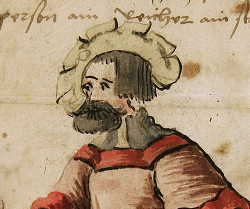 | |
| Born | 15th century |
| Died | 16th century |
| Occupation |
|
| Citizenship | Augsburg, Germany |
| Movement | Augsburg tradition |
| Influences | |
| Influenced | |
| Genres | Fencing manual |
| Language | Early New High German |
| Notable work(s) | Jörg Wilhalm Hutters kunst zu Augspurg |
| Archetype(s) |
|
| Manuscript(s) |
Cgm 3712 (1556)
|
| Concordance by | Michael Chidester |
| Signature | |
Jörg Wilhalm Hutter was a 16th century German fencing master. In addition to his fencing practice, his surname signifies that he was a hatter by trade, a fact that is confirmed in the tax records of Augsburg, Germany in 1501, 1504, and 1516.[citation needed]
Contents
Manuscripts
Four works are commonly attributed to Hutter: on unarmored long sword fencing in the tradition of Johannes Liechtenauer, on armored and mounted dueling that appear to be based on those of the early 15th century (relying on armor designs that were obsolete by the 1520s), and a series of 32 uncaptioned illustrations portraying scenes of judicial combat. However, it is unclear if Hutter authored all of these works or, like Lienhart Sollinger and Paulus Hector Mair after him, merely compiled existing works together and placed his name on them as an owner's mark. The development of the armored dueling treatises can be traced through a draftbook and rough early annotated copy, but the same is not true of the unarmored long sword fencing, which appears to be based on the MS Cl. 23842 from the 1480s-90s and is accompanied by an excerpt of Branch C of the pseudo-Peter von Danzig gloss which Gregor Erhart attributes to one Nicolaüs and dates to 1489.[1]
There are three extant manuscripts of Hutter's treatises created between 1522 and 1523, all now residing in Augsburg (along with most of the rest of Paulus Hector Mair's collection). The apparent oldest of Hutter's manuscripts, Cod.I.6.4º.5,[2] consists of numbered but uncaptioned illustrations of armored dueling on horse and on foot, and is dated to 1522. The same year saw the completion of the Cod.I.6.2º.3, which includes the same illustrations but adds written instructions to the plays; for this reason, Hils assumed the former was the draftbook used to develop the latter.[citation needed] In 1523, Hutter seems to have created an accompanying long sword treatise, preserved in the Cod.I.6.2º.2.
Some time soon after this, all three of Hutter's prior works, along a new series of 32 uncaptioned illustrations of dueling, were compiled into the Cgm 3711. This manuscript has some oddities not found in the others, including carnival costumes on some of the fighters and a pretzel salesman appearing in the illustration on folio 11r. It's currently unclear whether Hutter was involved in the creation of this manuscript or not, but it appears to be a presentation copy of the collected works and includes content unique to each of the three earlier manuscripts. Hutter's long sword treatise was also copied by sculptor Gregor Erhart into the MS E.1939.65.354 in 1533, though it's currently unclear which source he based it on.
Most copies of Hutter's treatises were eventually acquired by Freifechter and collector Lienhart Sollinger. Cgm 3711 was a source for his Cgm 3712 (1556) and Cod.Guelf.38.21 Aug.2º (1588), and the former also seems to have drawn heavily from MS E.1939.65.354. Sollinger, in turn, sold several of these works to Paulus Hector Mair: the Cod.I.6.2º.2 in 1544, the Cod.I.6.4º.5 in 1552, the MS E.1939.65.354 in 1560, and the Cod.I.6.2º.3 in 1561. Hutter's draftbook in particular was apparently used as the primary source for Mair's writings on armored dueling (preserved in three manuscripts in the 1540s and 50s); owing to its lack of text, Mair inserted his own descriptions of the plays—descriptions which diverge noticeably from Hutter's own explanations.
A final set of two copies of Hutter's work, including Cod.Guelf.1.6.3 Aug.2º and MS KK5247, were prepared by Jeremias Schemel von Augsburg at the end of the 16th century as part of a massive compilation of treatises on horsemanship which also included discussion of riding, dressage, jousting, and tournaments. These manuscripts contain Hutter's original text (unlike Mair's version), but the elaborate artwork includes details from multiple prior versions of Hutter's work, suggesting that Schemel's source manuscript may remain to be discovered. A third manuscript of Schemel's work also exists, copied from the MS KK5247 in 1838, but such a late work has little to contribute to any analysis of the tradition.
Treatise
In order to compress these tables and avoid empty columns, the Glasgow version of the long sword section and the draftbook for the short sword and mounted fencing sections appear in the same column (since they don't overlap). The three additional versions of the short sword and mounted fencing appear at the far side of those tables. The section containing uncaptioned plays only appears in three manuscripts, so the others are all omitted.
Illustrations |
Archetype (1523) |
Munich Version Ⅰ (1523) |
Glasgow Version (1533) |
Munich Version Ⅱ (1556) |
Wolfenbüttel Version Ⅰ (1588) | |||||||||||||||
|---|---|---|---|---|---|---|---|---|---|---|---|---|---|---|---|---|---|---|---|---|
[1] Young knight learn, to have love for god and honor women. Speak to women well and be valiant, so that one shall hear you and also be available thereto. Do not let yourself be deceived by one’s tricks, go with courage to he who does injustice to you, and set your sense to a sincere principle, and to this end learn valiant chivalry, yet practice pinching and jesting with joy. Throw the stones, shoving staves, fencing and wrestling, dancing and jumping, stabbing and jousting, with that should one seem to curry favor with women, yet fencing wants to have pinching and jesting. The heart which easily frightens there, no fencing shall he learn, why whoever loses the art from the sword, he goes hazy, and also makes large sweeps, those softly warped hearts, therefore one hears very many stories, that the hopeless often will be hit, and is a righteous sense that a truth with fencing will be reached and art has not learned. Of that complaint, I myself Jörg Wilhalm Hutter from Augspurg open and ridicule. |
[01r] Jungk Ritter lerne Gott lieb haben und frawen Erm Red frawen wol und bis manlich d[ie] man dan sol hiert dich auch vor liegen darzu las dich nit betrÿegen trag aines manes mutt [ge]gen dem der dir unrecht thutt und setz dein sin in ein herliche sa[ ]z und lern darzu manliche Ritterschaft doch Scha...pffen und sch...zen mit freuden yeben Die stain stösse stangen schieben vechten und Ringen d[u]nzen und springen stechen und turnieren darmÿt sol man schene frawn hofieren doch schnipffen und scherizen vechten wil haben das herze walchr dar schricket gere kain vechten sol er nit Lernen warum wer verlorn die kunst vom schwertt gatt der dumst und auch die grose straich machent die verzug[e]e herzen waich darum hörtt man gar vil sagen Das die verzagtenv oft werdent gschlagen und ist ein doretter Sin das ein War mitt vechten wil kumen hin und kunst nit glernet hatt des klag ich mich Jörg Wilhalm huttmachr von augspurg frie und spott |
|||||||||||||||||||
[2] Whoever wants to hew upon you,
|
[02r] Wer auff dich wil hawen,
Wilstu kunst schawen |
[015r] Wer auff dich will hauen,
Wiltu kunst schauwen so bis lingkhs und rechts mit hauwen, und lingks mit rechten ist, das du starcke begerst zu fechten. Wer nach gehen mit hauwen und auff sich kunst wenig frauwen, haue nachent wie du wilt, kein durchwechsel kompt an dein schilt. Zu kopff und leib das fechte nit ??? mit ganztem leib und was du starkh begerst zu treiben ?? umb du schlecht frisch auff. | ||||||||||||||||||
[3] The two both stand on the left in the over hew
|
[02v] Die zwen stand baid glingks in den oberhaw Vicht nit oben glingks so du gerechts bist |
[015v] Die 2 stehen beid gliurkhs in dem oberhauwen ficht nit oben glinkhs, so du rechts bist, und ob du glinckhs bist, und im rechte auch solt linckhst vor und nach die 2 ding seind aller kunst ein ursprung schwech und starckh, in das wart deiner arbaigt. Damit merckh so magstu lehrnen mit kunst arbaitri und wer erschrikht gern, soll kein fechte lehrnen. | ||||||||||||||||||
[4] He stands in the over hew
This is about the wrath hew. Whoever hews you from above, take the wrath hew strong on your shoulder and hew in straight, over the parry, and hang and wind with the sword as if you want to thwart, and allow to drop to both sides with half failers and hit him with the long edge to the right ear to the head away. |
[06r] Der statt im oberhaw
Das ist vom zornhaw wer dir oberhawet so nim den zornhaw starckh auff dein achseln vnd haw in schlecht hinein vber d[ie] versatzung vnd verheng vnd wind mit dem schwert als welte [?] dich zwerchen vnd lass obfallen zu baiden seÿtten mit hal[b] vellern vnd schlag in mit der langen schneid nach dem Rechten orr zu dem kopff hinweg |
[03r] Der stat in oberhaw
Das ist vom zornhaw. wer dir oberhawt, so nim den zornhaw starchk auff dein achseln und haw in schlecht hinein uber die versazung und vorheng und wind mit dem schwert als welttestu dich zwerchen und lass abfallen zu baiden seitten mit halben vollern und schlag in mit der langen schneid nach der rechten or zu dem koppf hinweg. |
[016r] Der stat ein oberhauwe
Das ist der zorn hauwe wer du oberhaut. so nim den zorn hau starckh auf dem achsel und hauwe im schlecht linein uber die gesatzung, und geheng und wind mit dem schwert als wollstu dich zwerch und lass abfallen zu baiden seitten mit halbern fellen, und schlag in mit der langen schneid nach dem rechte ohr zu dein kopff hinweckt. | |||||||||||||||||
[5] He stands in the over hew
This is the wrath hew on the left side, and take the same from the left shoulder and hew him quickly in long to the head and hang and wind with it, and again use the failers, and hit yet again as stands written before and behind. |
[06v] Der stett im oberhaw
[D]as ist der zornhaw auff der lingken achseln seitten vnd den [se]lben nim von der lingken achseln vnd haw im schnel hinein [l]ang zu dem kopff vnd verheng vnd wind damit vnd las aber [d]ie veller laffen vnd schlag aber wie vorgschriben stat [v]nd hindersich hinweg |
[03v] der stat in oberhaw
Das ist der zornhaw auff der lingken Seiten und den selben nim von der lingken achseln und haw in schwer hinein lang zu dem koppf und vorheng und wind damit und lass aber die veller lauffen und schlag aber wie vor geschriben stat und hindersich hinweg |
[016v] Der stat im oberhauw
Das ist der Zorn hauw auff der lingkten seiten und den selben nim von der lingkten achsel, und hauwe im linein lang zu dem kopff, und verheng und wind damit und las aber die veller lauffen, und schlag aber wie vor geschriben stat, und hindersich-weg. | |||||||||||||||||
[6] This is the wrath point
This is the direction, and note:
and take it with half failers, but hit in as before and behind. |
[03r] Das ist der zorn ortt
Das ist die ausrichtung vnd merckh wer dir oberhawet vnd nims mit halben vellern vnd schlag aber hinein wie vor vnd hindersich hinweg |
[04r] das ist der Zornortt
Das ist die ausrichtung und merckh wer dir oberhawet und wins[3] mit halben vellern und schlag aber hinein wie vor und hindersich hinweg. |
[017r] Das ist der Zorn ort
Das ist die aussrichtung, und merkh wer dir oben hauwet, dz im mit dem zorn ort furtringest und wirt er das geware, so nim es oben ohn gefahr, und bis starkh herwider wind, hauwe und stich, sicht ers so nim es wider das eben merckg, hauwe stich, schwech, und starcke und nemb mit halb veller und schlag oben linein, und vor und hindersich hinwecgkt. | |||||||||||||||||
[7] He stands in the over hew
This is the other wrath point on the other side, take it also thusly: If they indeed both wrath hew from the shoulder, and one must make a stab from a hew, and the hew must be thrown, and take that also quickly away like the above. |
[03v] Der stett im oberhaw
Das ist der ander zorn ortt auff der andern seÿtten den nim auch also wen sy gand baid wie der zornhaw von der achsel vn[d] mus ainer auss einem haw ain stich machen vnd mus den haw ver werffen vnd das nim auch flux hinweg wie das ober |
[04v] der stat im oberhaw
Das ist der ander zornortt auff der andern seitten den nim auch also wen sÿ gond baid wie der zornhaw von der achsel und mus einer auf einem haw ain stich machen und muss den haw verwerffen und das nim auch flu[chs] hinweg wÿe das ober |
[017v] Der stat ein obehauwe
Das ist der ander zorn ort, auff der ander seitten den nim auch also, wan sei gend baid wie der zorn hauwe von der achsel, und muss einer aus ein hauwe ein stich machen und aus den verwerffen, und dz nim auch fluchs hinweckg wie dz ober. | |||||||||||||||||
[8] Here, fences to the war
This is the direction about the war:
Gloss note. |
[05r] hie vacht an der krieg
Das ist die ausrichtung vonn dem krieg wer des kriegs oben remet gloss merckh |
[018r] Hie fecht an der krieg
Das ist die ausrichtung von dem krieg, wer des kriegs oben renet, der wirt oben nider gescheuet??, Indes vor und nach, dem krieg sei dir nit gach, nim das allen fechten wiltu den krieg machen glossmerkh. | ||||||||||||||||||
[9] This play is in the war This is also about the war, and should also know that
because there are very many breaks about them and also to them, realize how one bares with the war. Gloss note. |
[02v] Das stuckh ist inn dem krieg Das ist auch von dem krieg vnd soltt auch wissen das in al[len] winden wan es sind gar vil brich daruber vnd auch darzu a[?] war wie ainer mit dem krieg gebar gloss merckh |
[05v] das stuckh ist in dem krieg das ist auch von dem krieg und solt auch wissen das in allen winden wan es sind gar vil buch daruber und auch darzu nim war wie einer mit dem krieg gebar gloss merkckh. |
[018v] Das stukh ist in dem krieg Das ist auch von dem krieg, und solt auch wissen dz in allen winden, hauwen, stich schwerter, uberlauffen, schwert auswinden in allen treffen, wiltu der maister oesen wan es seind gan vil bruch daruber und auch darin nim war mit einer mit dem krieg geben glosswerkh. | |||||||||||||||||
[10] This is an outer winding and break from the war This is another play from the war and a break of the previous play, and is an outer winding that goes: hew or stab, find slices well.
|
[04r] Das ist ein auswinden vnd bruch von dem krieg Das ist aber ain stuckh von dem krieg vnd ain stuckhbruch des vo[r]dern stuckhs vnd ist ein auswinden das geit haw stich gut schneiden finden auch solttu mit |
[06r] das ist ein aus winden und bruch von dem krieg das ist aber ein stuckh von dem krieg und ein bruch des vordren stuckh und ist ein auswinden das geit haw stich gut schneiden finden auch soltu mit |
[019r] Das ist ain auswinden und bruch von dem krieg Das ist aber ein stukh von dem krieg und ain bruch des vor den stukh und ist ain auswinden, das geit hauwe stich gutt schneiden finden auch soltu mit brauchen hauwe, stich, schneid und in alle treffen wiltu den maister esen | |||||||||||||||||
[11] This is also about the war This is also about the war:
You shall also turn crooked and search to and on and test his techniques, whether he is soft or hard in his technique. Gloss note. |
[05r] Das ist auch von dem krieg Das ist auch von dem krieg schulch zu dem ortt auch solttu verwenden krum vnd [?] vm vnd auff vnd brieff im seim gefertt ob er seÿ waich o[der] hörtt im sein gförtt gloss merckh |
[06v] das ist auch von dem krieg Das ist auch von dem krieg schulch zu dem ortt auch solttu vor wenden krum und sich vmb und auff und brieff ein sein gefertt ob er seÿ waich oder hërt in sein gefertt gloss merckh |
[019v] Das ist auch von dem krieg Das ist auch dem krieg schileher zu dem ort. und nim den hals one fercht auch soltu verwenden krumb und stich umb und auf und brief in sein gfang ob er sei waich oder hart in sein gfert gloswerkh. | |||||||||||||||||
[12] This is also about the war This is about the war. The direction: Whoever rightly fights one with the sword near the neck, he must turn with a winding through and wind again. That goes well weak and strong below and turn your sword at the neck and jerk the left foot behind you and slice him or the neck. Gloss note. |
[05v] Das ist auch von dem krieg Das ist von dem krieg die ausrichtung wer also ainen vacht beÿ dem hals mit dem schwertt der muß nemen mit ein durch winden vnd wider winden das geit gutt schwech vnd sterckh vinden vnd verwend dein schwert an dem halss vnd zuckh denn lingkhen fuss hindersich vnd schneid in ob dem hals gloss merckh |
[07r] Das ist auch von dem krieg das ist auch von dem krieg die ausrichtung wer also ainen vacht beÿ dem hals mit dem schwertt der mus nemen[5] mit ein durch winder und under winden das geit gutt schwech und sterchk unden und verwend dein schwertt an dem halss und zuckh den lingken fuss hindersich und schneid in ob dem halss gloss merckh |
[020r] Das is auch von krieg Das ist auch von dem krieg die ausrichtung wer also ain recht bei dem hals mit dem schwert der muss nemen mit ein durchwinden und wider winden, dz gait gutt schwech und starkh unden un verwend dein schwert an dem hals und zukh den lingkhen fuss hindersich und scheid in ob den hals gloswerkh. | |||||||||||||||||
[13] Those are points in the war Those are the false points in the war. They go forth earnestly, because why they pertain to many passages, in addition, windings below through or wind nimbly above to the top and throw the point onto the hands and invert forcing run through also if you want to wrestle. |
[04v] Das sind örtter in dem krieg Das sind die valschen örtter in dem krieg das gat ernstlich zu wen warum es gehörend vil durch geng darzu vnd winden vnden durch oder wind oben vber behend vnd wirff den ortt auff die hend vnd verker zwingen durchlauff auch willtu Ringen |
[07v] Das sind örtter in dem krieg Das sind die valschen örtter in dein krieg das gatt ernstlichen zu wen warum es geherend vil durch geng darzu und winden unden durch oder wind oben uber behend und wirff den ort auff die hend und verker zwingen durch lauff auch wiltu Ringen |
[020v] Dar seind ortter in dem krieg Das seind die falschen örtter in dem krieg dz gat ernstlich? zu wer warumb es gehörend vil durch gang? darzu und winden unden oder oben uber behendt, und wirff den orth auf die hend und verker zwingen durch lauff auch wiltu ringen. | |||||||||||||||||
[14] This is also about the war This is the war when you strike someone to the right side, then the other takes the war and needs no more from you than to parry your opening with the long edge and thus he shoots to you with the sword above over, and do as you see it pictured. |
[38r] Das ist auch von dem krieg Das ist der krieg wan du einen schlechst in die Rechten Seitten so nimpt der ander den krieg vnd bedarff dir nit mer dan dein blöss versetzen mit der langen schneid vnd so scheust er dir mit dem schwertt oben vber vnd thu als du es gmaltt sichst |
[08r] Das ist auch von dem krieg Das ist der krieg wan du einen schlechst in die rechten seiten so nimpt der ander den krieg und bedarff dir nit mer dan dein blöss versetzen mit der langen schneid und so scheust er die mit dem schwertt oben uber und thu als du es gemalt sichst |
[Missing folio] |
[103r] Das ist auch vonn dem krieg Das ist der krieg wan du eim schlechst in die rechten seiten so nimbt der krieg und bedarff dir nit mer dan dein blos versetzen mit der langen schneidt und so du scheust er die mit dem schwert und oben uber und thue als du es gemalt sichst |
[021r] Das is auch von dem krieg Das ist auch der krieg wann du ain schlecht in die rechte seitten so nimpt der ander den krieg, und bedauff dir nit mer, dann die blos versetzen mit der langen schneid, und so schaüfft er dir mit dem schwert oben uber? und thue als du oben gemalt sichst. | |||||||||||||||
[15] This is also about the war, a sword taking Gloss note: This is a sword taking and goes from the war, which one takes very slightly away, so that there are yet very many good plays which pertain to the war, and is many things of the war, and therefore you should note very many things. |
[38v] Das ist auch von dem krieg ein schwertt nemen Gloss merckh das ist ein schwertt nemen vnd get au[s] dem krieg das nimpt einer gar gering hinweg dan es sind noch gar vil guttr~ stuckh die zu dem krieg gehörentt vnd ist des kriegen mangerleÿ vnd darumb so solttu merckhen gar vil ding |
[08v] Das ist auch von dem krieg ein schwertnemen Gloss merckh das ist ein schwertnemen und get auss dem krieg das nimpt einer gar gering hinweg das es sind noch gar vil gutter stuckh die zu dem krieg gehörentt und ist des kriegen mangerleÿ und darum so soltu merckhen gar vil ding |
[021v] Das ist auch vom krieg ein schwert nemen Glosmerck dz ist ain schwert nemen, und geht aus dem krieg, dz nimpt ainer gar gering hinwerkh, dz es seind nach gar vil gutt stukh die zu dem krieg gehauwen, und ist das kriegs manicherlai, und darumb so soltu merkhen gar vil ding. | |||||||||||||||||
[16] Here, fencing to the four openings
Here fence to the openings to the head and also to the side.
Also, it comes after at the end hereafter how you shall break the four openings. Gloss note. |
[39r] Hie vachen an die vier blöss
Hie vachtt an die bloss zum kopff vnd auch zu der Seitt die vier blöss wis das wirstu wir [?] gewar auch kumptt es nach hinden hernach wie du soltt die vier blöss brechen gloss merckh |
[09r] hie vachen an die vier blöss
Hie vacht an die blöss zum kopff und auch zu der Seiten die vier blöss wiss das wirstu wol gewar auch kumpt es noch hinden hernach wie du solst die vier blöss brechen gloss merckh |
[022r] Hie facht an die 4 bloss
Hie facht an die blos zum kopff, und auch zu der seitten die 4 bloss wus zu nemen so schlechstu gerns an alle gefar, an allen zweiffel wie er gebar dz wirstu auch wol gewar auch kumpt es nach hinden hernach, wie du solt die 4 blos brechen glosmerckh. | |||||||||||||||||
[17] Those are also two openings Those are the other two openings to the other side, therefore deceive and note on as the whole, and whoever takes the openings below, they will be shamed above near the ears. Gloss note weak and strong. |
[39v] Das sind auch zwu blöss Das sind die andern zwu blöss zu der andern seitten darumb so lug vnd merckh auff wie die gand vnd we[r] die blöß vnden nemett der wirtt oben bei den oren gschemett gloss merckh schwech vnd sterckh |
[09v] Das sind auch zwei blöss Das sind die andern zwei blöss zu der andern seitn darum so lug und merckh auff wie die gand und wer die blöss unden nemet der wirtt oben beÿ den orn geschemet gloss merckh Schwach und starckh |
[022v] Das seind auch 2 blos. Das seind die ande 2 blos, zu der andern seitten, darumb so lug auf wie die gend, und wer die blos unden nemet der wirt oben bei den ohren geschemst? glosmerckh schwech und sterkh. | |||||||||||||||||
[18] This is the crooked hew on the right side change
This is about the crooked hew, the direction:
or use if you want to wrestle, and step to him in the triangle. Gloss note. |
[40r] Das ist der krumphaw auff der Rechtñ seiten wechsel
Das ist von dem krumphaw die ausrichtung krumb auff behen[d] oder verwend wilttu Ringen vnd dritt im in den driangel gloss merckh |
[10r] Das ist der krumphaw auff der rechtn Seyten wechsell
Das ist von dem krumphaw die ausrichtung krum auff behend oder verwend wilstu ringen und drit im in den driangel gloss merckh |
[023r] Das ist der krum hauw auff der rechten seitten wechsel
Das ist von dem krumen hauw die ausrichtung krum auf behend wirff den ort auff die hend, hauw krum zu der flech, wiltu den maister schwechen krum nit kurtz hauw dein durchsechsel damit schwech oder hart verwendt wiltu eingehn, und tritt im in den triangel glosmerckh. | |||||||||||||||||
[19] He stands in the over hew
That is, crook on nimbly.
|
[40v] Der statt im oberhaw
Das ist krump auff behennd wer wol versetzt |
[10v] Der stat im oberhaw
Das ist krump auff behend wer vol versezt |
[023v] Das stat im oberhauw
Das ist krum auf behend wer wol versetz mit schreitten er vil heu letzt hauw krum zu der flechen, wiltu den maister schwechen, wan es glitz oben, so stand ab dz will ich loben krum schlecht und mit kurtz hauw den durch wechsel damit schlach? krum wer dich irret der edel krieg in verwirret. | |||||||||||||||||
[20] This is how one shall break in the four openings: He hits him with opening to the side, thus the other breaks it to him and hits him behind onto his head
This is to break openings,
That I have heard. Gloss note. |
[08r] Das ist wie man die vier blöss brechen sol der ein der schlecht in mit blöss in die seitten so bricht der ander sÿ Im vnd schlöcht in hinden auff sein kopff
Das ist blöss brechen vnd wiltu dich Rechen das hab ich vernomen gloss merckh |
[11r] Das ist wie man die vÿer blöss brechen sol der ein der schlecht in mit der blöss in die seitten So bricht der ander Sy Im und schlecht in hinden auff Sein kopff
Das ist blöss brechen und wilstu dich Rechen das hab ich vernomen gloss merckh |
[024r] Das ist wie man die 4 blos brechen soll der ein schlecht in mit der blos in die seitten, so bricht der ander sei im, und schlecht in hinden auf sein kopf.
Das ist blos brechen, und wiltu dich rechen die 4 blos künstlich brechen du oben doppilier unden recht mutier, ich sag dir fürwar sich? beschitzen kan, wan on gfar hastu vernomen? zu schlagen mag ir kainer kummen dz hab ich vernomen? glosmerckh. | |||||||||||||||||
[21] There this breaks the opening on the other side, and is also to break the openings
This is the opening breaking on the other side, and break it as you see pictured. You must also double above, and mutate correctly below. Item: The opening breaking shall stand pictured in front before the crooked hew. |
[08v] Da bricht diser die blöss auff der andern Seitten vnd ist auch die blöss brechen
Das ist die blöss brechen auff der andern seitten vnd brich sÿ wie du si gemalt sichst du must auch oben dupplieren vnd vnden Recht mutieren Item die blöss brechen söltt gmalt sten dauorn vor dem krumphaw |
[11v] Da bricht diser die blöss auff der andern seitten und ist auch die blöss brechen
Das ist die blöss brechen auff der andern seitten und brich sÿ wie du Si gmaltt sichst du must auch oben dupplieren und unden Recht muttie renn Item die blöss brechen soltt gmalt sten dar[uo]n vor dem krumphaw |
[024v] Da bricht diser die blos auf der andern seitten, und ist auch die blos brechen
Das ist die blos brechen, auf der andern seitten, und brich sei wie du gemalt sichst du must auch oben dupplieren, und unden recht mutieren, Item die blos brechen solt gemalt stehn darvon vor der krumhauw. | |||||||||||||||||
[22] The guard from the day
Note: These are two guards, and this is the guard from the day. He has his sword raised upwards, and the other has his sword raised downwards beside the left foot. This is the fool and is also called the iron gate. Then there are four guards. Ox and plow, those are also two guards. Gloss note. |
[14r] Die hutt vom tag
Item das sind zwu hutten vnd ist das die hutt von tag de[?] der sein schwertt vbersich hebtt vnd der andr~ der Sein schwertt vndersich hebt beÿ dem lingken fuss das ist der alber vnd haist auch die Eisnin por[tt] dan es Sind vier huttñ ochs vnd pflug das sind auch zwu hutten gloss merckh |
[12r] Die hutt vom tag
Item das sind zwu huttn und ist das die hutt von tag der sein schwertt ubersich hebt und der Ander der sein schwertt undersich hebt bei dem lingken fus das ist der Alber und haist auch die Eisin portt dan es sind vier hutten ochs und pflug das sind auch Zwu hutten gloss merkh |
||||||||||||||||||
[23] Skull hew
Item: This is about the crown, etc. and then he raises the sword upwards. He stands in the skull hew, and the other in a position, and when he hits away from the roof, thus the other takes the crown all right. Gloss note. |
[14v] Schaitelhaw
Item das ist von der kron etc vnd der der das schwertt vbersich hebtt der statt in dem schaitelhaw vnd der ander in ein legr~ vnd wan der schlöchtt von dach ab so nimpt der ander die kron also schon gloss merckh |
[12v] Schaitelhaw
Item das ist von der kron [ ] und der der das schwertt ubersich hebt der statt in dem schaitelhaw und der ander in ein leger und wan der schlecht von dach ab so nimpt der ander die kron also schon gloss merckh |
||||||||||||||||||
[24] This is the thwart hew
and whoever directs the failer on from below two times aims as he wishes. Gloss note. |
[07r] Das ist der zwerchhaw
Das ist die zwerch benimpt vnd was velle[r] verurrn von vnden auff zwifach nach wunsch sÿ Reren gloss merckh |
[13r] Das ist der Zwerchhaw
Das ist die Zwerch benimpt und was veler veruarn von enden auff [ ] zwiuach nach wunsth Sÿ Rere[ ]tt gloss merckh |
||||||||||||||||||
[25] This is the thwart on the other side
This is the thwart on the other side, take it also as on the other side: invert, force, run through, and also wrestle, and in the elbows in the scale and step to the left, and don’t be lazy. You may wrestle in both thwarts. Gloss note. |
[07v] Das ist die zwerch auff der andern seitten
Das ist die zwerch auff der andern seitten den nim auch wie auff der andern seÿtten verkerr zwing durchlauff vnd auch Ring vnd In dem elenbogen in der wag vnd tritt in den lingken vnd bis nit laß in baÿden zwerchen magstu Ringen gloss merckh |
[13v] Das ist die Zwerch auff der amderm seitten
Das ist die zwerch auff der andern seitten den nim auch wie auff der ander Seittn verker zwing durchlauff und auch Ring und in dem Elenpogen in der wag und drit an den lingken und bis nit lass[6] in baiden Zwerchen magstu Ringen gloss merckh |
||||||||||||||||||
[26] He breaks the thwart
This is the play of how one shall break the thwart: One thwart breaks there, the other with placing upon and with shooting under and with shooting over. You may take the two hangings from it if you want, then they are two hangings, which is very strict for the man. Gloss note. |
[09r] Der bricht die zwerch
Das ist das stuckh wie einer die zwerch brechen sol da bricht ein zwerch die andern mit aufsÿtzen vnd mit vnderschliesen vnd mit vberschliessen darauß magstu neme[?] die zwaÿ hengen ob du wiltt den es sind zway hengen die den man ser engen gloss merckh |
[14r] Der bricht die Zwerch
Das ist das stuckh wie einer die Zwerch brechen sol da bricht ein Zwerch die andern mit auff sitzen und mit underschiessen und mitt uberschiessen darauss magstu nemen die zway hengen ob du wiltt dan es sind zway hengen die den man ser Engen gloss merkh |
[026r] Der bricht die zwerch
Das ist dz stukh wie ainer die zwerch brechen soll, da bricht ain zwerch die ander mit aufsetzen, und mit under schissen und uberschiessen, daraus magstu nemen die zwai hengen, die der man ser engen glosmerckh. | |||||||||||||||||
[27] He stands in the guard from day and raises as much as he likes
This is also a play from the thwart: Whatever thwarts itself well moves to the head with jumping from one side to the other, is also one that is better than that, therefore hear. Gloss note. |
[09v] Der stet in der hutt von tag vnd wertt sich als vil er mag
Das ist auch ein stuckh von der zwerch was sich wol zwercht mit springen dem haubt gefert auff ein seitñ zu der andern ist auch eins das ist besser den das also vernim gloss merckh |
[14v] Der stett in der hutt von tag und wertt sich als vil er mag
Das ist auch ein stuckh von der Zwerch was sich wol zwercht mit springen dem haubt gefertt auff ein seitten zu der andern ist auch eins das ist besser den das also vernim gloss merkh |
[026v] Der stat in der huet vom tag endwerlisch??? als vil er mag.
Das ist auch ain zwerch von der zwerch was sich wol zwercht mit springen dem haupt gefert auf ein seitten zu der andern seitten ist auch ring dz ist besser dann dz vernim? glosmerkh. | |||||||||||||||||
[28] He lies in the thwart and has taken it with a jump, and shoves his arm away from him This is also about the thwart: One takes that also with a jump, take that as you see it pictured, thereafter comes the break, therefore it itself is then not a play for you, it has a break. Therefore note art, hear it beautifully. |
[10r] Der leit in der zwerch vnd hatt die genomen mit ein sprung vnd stost im den arm hinweg von Im Das ist auch von der zwerch das nimpt man auch mit ein sprung das nim also wie du es gmalt sichst darna[ch] kumpt der bruch darum sich dich fur dan es ist kain stuckh es hatt ein bruch darum merckh kunst vernim sÿ |
[15r] Der leit in der zwerch und hatt die genomen mit ein sprung und Stost im den arm hinweg von Im Das ist auch von der Zwerch das nimpt man auch mit ein sprung das nim also wie du es gmalt sichst darnach kumpt der bruch dar um sich dich vir dan es ist kain stuckh es hatt ein bruch darum merkh kumst vor nim Sy schon. |
[025r] Der leit? in der zwerch und hatt dir genemen mit ein sprung, und stosst in den arm hinwegkh von im. Das ist auch von der zwerch dz nimpt man auch mit einem sprung, das nim also wie du es gemalt sichst, dar nach kumpt der bruch, darumb sich dich für dann es ist kain stukh es hatt ain bruch merkh kompts wan sei schon.? | |||||||||||||||||
[29] He also stands in the thwart, and he wants to shove away
This is the break against it: You may well quickly take a slice, and away from there so that he may not reach you, then one play breaks the other, and note as well what is good for you. |
[10v] Der statt auch in der zwerch vnd den wil hinweg stossen
Das ist der bruch darwider du magst wol flux ein schnidt nemen vnd hinweg das er dich nit er langen mag den ein stuckh bricht das ander vnd merckh dabeÿ was dir gutt Seÿ |
[15v] Der statt auch in der zwerch und der wil hinweg stossen
Das ist der bruch darwider du magst wol fluchs ein schnit nemen und hinweg das er dich nit erlangen mag den ein stuckh bricht das ander und merckh dabei was dir gut Sey |
[025v] Der stat auch in der zwerch und den will hinwegkh stossen.
Das ist der bruch darwider du magst wol flug ein schnit nemen, und hinwegkh das er dich nit erlangen mag dem ain stukh bricht dz ander, und merckh darbei wie dir gutt sei. | |||||||||||||||||
[30] That is also driven from the thwart with jumping to the head, how he bares with his turn without fear This is also a play: whatever well thwarts itself driving with jumping to the head, and a slice, a stab and ignore and fence at the neck, therefore understand it as you see pictured above. Gloss note. |
[11r] Das ist auch von der zwerch mit springen dem haubt gefertt wie er gebar mit seiner kar on als gefar Das ist auch ein stuckh was sich wol zwercht mit spr[i]ngen dem haubt gefertt vnd ein schnidt ein stich vnd vbergenn vnd bei dem hals vachen also verstand es wie du es vnden gmalt findst gloss merckh |
[16r] Das ist auch von zwerch mit Springen dem haubt gefertt wie er gebarr mit seiner korr on als gefar Das ist auch ein stuckh was sich wol zwercht mit springen dem haupt gefertt und ein schnidt Ein stich und ubergen und bey dem hals vachen Also verstand es wie du es oben gmalt sichst gloss merckh |
||||||||||||||||||
[31] This is the thwart in above, also a play This is yet again about the thwart from the above, so that you then understand it, that very many come from the thwart, if one searches for it, because it is good to make to all things weak and strong. Gloss note. |
[11v] Das ist die zwerch oben ein auch ein stuckh Das ist aber von der zwerch von dem vbergen das du es verstandest das gar vil auß der zwerch kumptt wen man es sucht wan sÿ ist gutt zu allen sachen schwech vnd sterckh machen gloss merckh |
[16v] Das ist der zwerch oben ein auch ein stuckh Das ist aber von der zwerch von dem uber gon das du es verstandest das gar vil auf der zwerch kumpt wen man es sucht wen Sy ist gutt zu allen sachen schwech und sterckh machen gloss merckh |
||||||||||||||||||
[32] This is the ox
This is about the ox and plow, the direction: The thing and the second thing are an origin of all art. Ox and pflug are justifiably hard in the war, in all things, with which to make the old slice. Thus you are secure in all things and it may not fail you. |
[12r] Das ist der ochss
Das ist von dem ochsen vnd pflug die ausrichtung die ding vnd die zwaÿ ding sind aller kunst ein vrsprunng ochs vnd pflug sind dem krieg hartten fug In allen sach[ñ] den altten schnidtt mit zemachen so bistu sichr~ in allen dingen vnd mag dir nit mislingen |
[17r] Das ist der ochse
Das ist von dem ochsen und pflug die aufricht ung die ding und die zwei ding sind aller kunst ein ursprung ochs und pflug sind den krieg hartn fug In allen sachen den alttn schnidt mit zu machen so bistu sicher in allen dingen und was der nit mislingen |
||||||||||||||||||
[33] This is the ox
This is the other ox and plow and are also justifiably hard in the war. Item: One shall drive the ox and plow from both sides, then they have four windings and four points which you may use as you wish, because they are also two guards. Gloss note. |
[12v] Das ist der ochs
Das ist der ander ochs vnd pflug vnd sind auch dem krieg hartten füg Item den ochsen vnd pflug sol man treibñ von baiden seitten dan sÿ haben vier winden vnd vier örtter die magstu brauchen wie du wiltt wen es sind auch zwu hutten gloss merckh |
|||||||||||||||||||
[34] He stands armed[9] This is also about the squinter and has his neck, thus the other takes an armored play and breaks his play, as you see it pictured. This is also a play, a break. Gloss note. |
[18r] Der statt gewappet Das ist auch von dem schilchr~ vnd hatt im den halss so nimpt der ander ein gewapnet stuckh vnd bricht in sein stuck[h] als du es gmalt sichst das ist auch ein stuckh ein bruch gloss merckh |
[18r] Der statt gewapent Das ist auch vo em schilchr und hatt im den halss so nimpt der ander ain gewapnet stuckh und bricht Im sein stuckh als du es gmalt Sichst das is auch ein Stuckh ein bruch gloss merckh |
||||||||||||||||||
[35] This is also about the squinter, play and break, and there he has the sword on the neck. This is the break and the other the play. Note that as you see it pictured. |
[18v] Das ist auch von dem schilchr~ stuckh vnd bruch vnd der do hatt das schwertt auff dem halss das ist der bruch vnd das ander das stuckh das merckh wie du es gmalt Sichst |
[18v] Das ist auch von dem schelcher stuckh und bruch und der da hatt das schwertt auff den halss das ist der bruch und das ander das stuckh das merckh wie du es gemaltt siehst |
||||||||||||||||||
[36] This is again about the squinter, the break, the run over, that strongly breaks his squinter, hit or slice and away from there quickly and soon, and therefore is not a play, it is a break from it. Gloss note. |
[19r] Das ist aber vom schilchr~ der bruch das vber lauffen das bricht im den schilchr~ starckh schlag oder schneid vnd hinweg flux vnd bald vnd darumb ist kain stuckh es ist ain bruch darauff gloss merckh |
[19r] Das ist aber vom schelcher der bruch das uberlauffen das bricht im den schilcher starckh schlag oder schneid und hinweg fluchs und bald und darum ist kain stuckh es ist ain bruch darauff gloss merckh |
||||||||||||||||||
[37] This is another play from the squinter. Squint to the point and take the neck without apprehension, and at the same time so note and learn art that you yourself have become accustomed to. Gloss note. |
[19v] Das ist ein ander stuckh von dem schilcher schilch zu dem ortt vnd nim den halss one forcht vnd dabey so merckh vnd lern kunst das du dich dar auß kundest Rechtñ gloss merckh |
[19v] Das ist ain ander stuckh von dem schilcher schilch zu dem ortt und nim den halss one forcht und dabei so merckh und lern kunst das du dich daraus kundest Rechten gloss merckh |
||||||||||||||||||
[38] He stands hitting in the above parry
|
[16r] Der stett schlechts in der ober versatzung
Der schilcher ein bricht |
[20r] Der statt schlechts in der ober versatzung
Der schilcher einbricht |
[027r] Der stat schlechts in der oben versatzung
Der schilcher einbricht was biffel schlecht, oder sticht wer wechsel treibt mit schilchen dar aus beraubt? schilchr er dich kurtz an dein durch wechsel gfangt in an schilcher zu dem ort und nim den hals on forcht zu dem obern haubt behend, wiltu besterb~ und vind~ schon. | |||||||||||||||||
[39] He stands hitting in the above parry
In all things, let us make crisply. |
[16v] Der statt schlechtz in der ober versatzung
Der schilcher In allen sachen lass vns frischlich machen |
[20v] Der statt schlechts in der ober versazung
Der schilchr in allen sachen lass un[s] frisch hÿch machen |
[027v] Der steht schlechts in der oben versatzung.
Der schileher dein antlitz ist ganau??? mit seiner klar der breust hast fürwar was von im kompt, die kron dz abnimpt der schnidt durch die kron, so brichstu sei hart und schon die strauch trukg mit schnidt sei abzukht in allen sachen lob und frishlich machen | |||||||||||||||||
[40] That is a squint to the point and take the neck without apprehension, and in addition strong into the scale
This is from the squinter. Squint to the point and take the neck without apprehension, and stand into the scales and hold solidly to yourself, and if you want to go away from him, then wind out and away from him. Gloss note. |
[17r] Das ist schilch zu dem ortt vnd nim den hals one forcht vnd darzu starck in der wag
Das ist vom schilchr~ schilch zu dem ortt vnd nim den hal[s] one forcht vnd stel dich in die wag vnd haltt fast an di[ch] vnd wen du von im wiltt so wind im aus vnd hinweg gloss merckh |
[21r] Das ist schilch zu dem ortt und nim den halss one forcht und darzu starckh in der wag
Das ist vom schilchr schilch zu dem ortt und nim den hals one forcht und stel dich in die wag und halt fast an dich und wen du von Im wiltt so wind im auss und hinweg gloss merckh |
[116r] Das ist schilcher zu dem ortt und nim den hals on forcht und darzu starckh in der wag So spricht der es geherend vill vil durch geng darwidr die hernach koment Das ist vom schilcher schilch zu dem ortt und nim den hals on forcht und stel dich in die wag und halt fast an dich und wen du von Im wilt so wind im auss und hinweg gloss merckh |
[028r] Das ist schileher zu dem ort, und nim den hals one fercht und haw starkh in der wag
Das ist von schileher zu dem ort, und nim den hals on fercht, und stell dich in die wag, und halt vast an dich, und wann du von im wilt, so windt im aus und hinwegkh glosmerkh. | ||||||||||||||||
[41] He hits above over
This is also from the squinter, and is a break from it, as you see it pictured, and realize that still more plays are which break it, and realize precisely how he bares. Gloss note. |
[17v] Der schlecht oben vber
Das ist auch von dem schilchr~ vnd ist ein bruch darauff wie du es gmaltt sichst vnd nim war das noch mer stuckh sind die es brechen vnd nim eben war wie er gebar gloss merckh |
[21v] Der schlecht oben uber
Das ist auch von dem schilch[er] und ist ein bruch darauff wie du es gmalt sichst und nim war das noch mer stuckh sind die es brechen vnd nim Eben war wie esr gebar gloss merckh |
[028v] Der schlecht oben über
Das ist auch von dem schileher, und ain bruch darauff, wie du dz gemalt sichst und nim war dz nacher stukh sein du des brechen und nim eben wer von er geben glossmerkh? | |||||||||||||||||
[42] This is the skull hew
This is about the skull hew, the direction: This is squinter with skuller, the face is threatened. With its turn, the chest quickly threatened, and what comes from him, the crown, all right. Gloss note. |
[24r] Das ist der schaitelhaw
Das ist von dem schaitelhaw die ausrichtung das ist schilchr~ mit schaitler sÿ sind dem hawpt baid geferd der schaitler dem antlitz ist geuar mit seiner kar der brust vast gefar vnd was von im kompt die kron also schon gloss merckh |
[22r] Das ist der schaitelhaw
Das ist von dem schaitelhauw die ausrichtung das ist schilch[e]r mit Schaittler dem antlitz ist gewar mit seiner kar der brust vast gefar vnd was von in kompf die kron also schon gloss merckh |
[029r] Das ist der schaitel hauw
Das ist von dem schaitel hauw die ausrichtung, dz ist schileher mit schaitler den antzlitz ist geuar mit seiner klar der brust vast gefar und was von im kompt die kron also sten glosmerckh. | |||||||||||||||||
[43] This is the short edge
This is also about the skull hew. It is to know that one shall take the skull hew with three steps and one may take it with a step, then the crown comes from him, that takes away the slice through the crown. Thus you break it hard and beautiful. Press the sweep, withdraw it with slicing. Gloss note. |
[24v] Das ist die kurtz schneid
Das ist auch vom schaitelhaw es ist zewissen das ainer den schaitelhaw sol nemen mit drew dritten vnd einer mag in nemen mit eim dritt den von im kumptt die kron das abnimpt der schnidt durch die kron so brichstu sÿ hartt schon die straich truck mit schnidten sÿ abzuckh gloss merckh |
[22v] Das ist die kurz schneid
Das ist auch vom schaitelhaw es ist ze wissen das ainer den schaitelhaw sol nemen mit drey dritten und einer mag in nemen mit ein drit der von in kumpt die kron das abnimpt der schneidt durch die kron so brichtstu sy harrt und schon die straich druckh mit schnitten sy abzuckh gloss merckh |
[029v] Das ist die kurtz schneid.
Das ist auch vom schaitelhauw, es ist zu wissen, ainer der schaitel hauw will nemen mit 3 tritten, und einer mag in nemen mit ein tritt der von im kompt die kron dz abnimpt der schnidt durch die kron, so brichstu sei hart und sten die straich mit durch schniten sei ab zucht glosmerkh. | |||||||||||||||||
[44] This is a parry
This is about the four positions, and also always a position and a parry from it.
|
[25r] Das ein versetzen
Das ist von den vier legern vnd auch alwegen ain leger vnd ein versetzen darauff die vier leger allain |
[23r] Das ein versetzen
Das ist von den vier legern und auch alwegen ain leger vnd ein versetzen darauff die vier leger allain |
[030r] Das ist ain versetzen.
Das ist von dem verlegern, allain davon halt, auch allwegen ein legen und ein versetzen, allain dauen halt die sag und fluch die gemain ochs und pflug alber von tag ist sein fucs??. | |||||||||||||||||
[45] This is also about the positions and is to know that one position breaks the other, and those are two positions, one lies over, the other under. Therefore note this, and hear that the lowest may well go through the above, and went onto his head, and therefore penetrates. Do well, so I shall say it. Gloss note. |
[26r] Das ist auch von den lägern vnd ist zewissen das ein leger das ander bricht vnd das sind zwaÿ leger ainer leitt oben der ander vnden das merckh also vnd verni[m] das der vnderst dem obern wol durch mag gen vnd gieng im auff sein kopff vnd darumb durchgen thut[t] wol so ichs sagen sol gloss merckh |
[23v] Das ist auch von den legern und ist zewissen das ein leger das ander bricht und das sind zwai leger ainer leitt oben der ander unden das merckh also und ver nim das der underst dem obern wol durch mag gen vnd gieng in auff sein kopff vnd darum durch gen thutt woll so ichs Sagen sol gloss merckh |
[030v] Das ist auch von der legen, und ist zuwissen dz ain leger dz ander bricht, und dz seind zwaierlei ainer lait oben der ander unden, dz merkh also, und nim'n dz underst den obern wol durch mag gehn, und gieng im auff sein kopff, und darumb durch gen thue wol so ich sage soll, glosmerkh. | |||||||||||||||||
[46] This is also about the positions, so that he then shoots on crooked on the position, and shoots to the top of his sword, and is the shooting over, also a position the other breaks. Gloss note. |
[26v] Das ist auch von den legern das der den auff dem leger scheust krumb auff vnd scheust im vber sein schwertt vnd ist das vberschiessen auch ein legr~ das ander brichtt gloss merckh |
[24r] Das ist auch von den legern das der den auff dem leger scheuest krum auff vnd scheust in vber sein hand schwertt vnd ist das vberschiessen auch ein leger das ander bricht gloss merckh |
[031r] Das ist auch von der legen, dz der den auf dein leger schrust kain aus und schrust in uber sein schwert, und ist dz uberschiessen auch ein leger dz ander bricht glosmerkh | |||||||||||||||||
[47] This is a parry
it hurts you, and be crisp and come before. If you have heard, he may come to no art. Gloss note. |
[25v] Das ist ein versetzen
Das ist von den vier versetzen vnd bis Resch vnd kom vor hastu vernomen zu kainer kunst mag er nit kumen gloss merckh |
[24v] Das ist ein versetzen
Das ist von den vier versetzen vnd ?aus R?esch vnd kum vor hastu ver nomen zu kainer kunst mag er mitt kummen gloss merckh |
[031v] Das ist ein versetzer.
Das ist von den viersetzen die die legen ser legen darvon versetzen huett dich geschlcht es dir net es mueth dich, und bis rash, und kam vor, hastu vernemen zu kainer kunst mag er nit komen glosmerkh. | |||||||||||||||||
[48] This is again about the four positions, and the parry upon it and shooting over. Those are also positions, note that there below with the strong and long into the scale, and if he wants to execute against you, then you may take a slice if you want to, or may hang, whatever fences best to you. Gloss note. |
[30r] Das ist aber von den vier legern vnd die versetzen darawff vnd vberschiessen das sind auch leger das merckh da vnden mit der sterckh vnd lang in der wag vnd wen er dich woltt auffheben so magstu ein schnidt nemen ob du wiltt oder mugs[t] verhengen was dir am basten fiegtt gloss merckh |
[25r] Das ist aber von den vier legern und die versetszen darauff und uberschiess[e]n das sind auch leger das merckh da und ein mit der sterckh und lang in der wag und wen er dich woltt aufheben so magstu ein schnidt nemen ob du wilt oder magst verhengen was dir am best[e]n viegtt gloss merckh |
[032r] Das ist aber von dem vierlegen, und die ver versetzen, darauff und uberschiess dz seind auch leger dz merkht da unden mit der sterkh, und lang in der wag, und wenn er dich will aufheben, so magstu ein schnidt nemen, ob du wilt, oder magst verhengen was dir am besten ist, glosmerkh. | |||||||||||||||||
[49] This is again about the four positions, and from the parry, there note on and watch: those are also two positions, and that is also a position, the shooting-over has, and the positions have an end, and the four parries, they are all side by side, then it is many that it searches. Gloss note. |
[30v] Das ist aber von den vier legern vnd von den versetzen da merck auff vnd schaw das sind auch zwaÿ leger vnd das ist auch ain leger der vberschossn hatt vnd haben die leger ein End vnd die vier versetzen sÿ sind all beieinander dan es ist Ir vil der Sÿ Suchtt gloss merckh |
[25v] Das ist ober von den vier legern vnd von den versetzen da merckh auff vnd schaw das Sind auch zwai leger vnd das ist auch ain leger der vberschossin huot vnd haben die leger ein End vnd die vier versetzen Sy sind all bey ein ander dan es ist ir vil der sy suchtt gloss merckh |
[032v] Das ist aber von den vierlegen und von den versetzen, da merkh auff und schauel? dz seind auch zweu? leger, und dz ist auch ein leger der uberschiessen haut und haben die leger einander und die versetzen, sei seind all bei einander dz es ist ir vil der sucht, glosmerkh. | |||||||||||||||||
[50]
and pay attention. Gloss note. |
[31r] Das ist von dem nach Raisen lere vnd hab achtt gloss merckh |
[033r] Das ist von dem ranach raisen lehren zwifach in der weren und zwai daraus nim dein arbait daraus begindt, und brief dem gefect ob sei seind waich oder hart, soll lehren in dz wert schneid seren nach raisen zwifach, so nimstu den alter schnidt mit macht und hab acht. glosmerkh. | ||||||||||||||||||
[51] This is another pursuit. You should take the pursuit on both sides, step long if you want to stride, because the pursuit is several things, and that is the pursuit when one has hit you and wants to go from you or withdraw, then follow after him and defend yourself. Gloss note. |
[31v] Das ist ein anders nachRaisen den das nachRaisen das Soltu nemen auff baiden seitten tritt lang wilttu schreitten wen das nachreisen ist mangerleÿ vnd das ist das nachRaisen wan einer dich gschlagen hatt vnd wil von dir gen oder abzwchen so volg im nach vnd vorr dich |
[26v] Das ist ein anders nachraissen den das nachraisen das solttu Nemen auff baiden Seitten dritt lang wilttu schreitten wen das nachraisen ist mangerlaÿ und das ist das nachraisen wan einer dich g[e]schlagen hatt und wil von dir gen oder abziechen So volg im nach und wer dich gloss merckh |
[033v] Das ist ain anders nachraisen den dz nach rasen dz soltu nemen auf baiden seitten, tritt lang wiltu schreitten, wann dz nachraisen ist mannigerlai, und dz ist das nach raisen wann ainer dich geschlagen hatt, und will von dir gen oder abziechen so felig im nach und wehr dich. glosmerkh. | |||||||||||||||||
[52] This is about the run over, there note that the run-over is thus: one runs over the other outside with the pommel outward with force, and that is an outer run over, and it is still more, and therefore when one wants to run over you, so raise your sword strong in the height, so he can not run-over you. |
[32r] Das ist von dem vberlauffen da merckh das das vberlauffen ist so einer den andern aussen vberlauft mit dem knopff auswendig mit macht vnd das ist ein ausser vber lauffen vnd der ist noch mer vnd darumb wan Einer dir wil vberlauffen so heb dein schwertt starckh in die höch So kan er dir nit vberlauffen glos[s] merckh |
[27r] Das ist von dem vberlauffen da merckh das das vberlauffen ist so einer den andern aussen vberlaufft mit dem knopff auf wendig mit macht vnd das ist ein ausser vberlauffen vnd der ist noch mer vnd darum wan einer dir wil vberlauffen so heb dein schwertt Starckh in die höch so kan er dir nit vber lauffen gloss merckh |
[034r] Das ist von dem uberlauffen in merkh, dz uberlauffen ist, so ainer den andern ausen uberlaufft mit dem knopff auswendig mit macht, und dz ist ain ausser uberlauffen, und der ist nach mer, und darumb wann ainer dich will uberlauffen, so heb dein schwert starkh in die hoch so kan er dich nit uberlauffen, glosmerkh. | |||||||||||||||||
[53] This is also about the run over, and that is an inward run over,
as you wish. Gloss mark. |
[32v] Das ist auch von dem vber lauffen vnd das ist ein inwendigs vberlauffen vnd wer vnden Remett wie du wiltt gloss merckh |
[27v] Das ist auch von dem vberlauffen vnd das ist ein Inwendigs vberlauffen vnd wer vind[e]n Rennett wie du wiltt gloss merckh |
[034v] Das ist auch von dem uberlauffen, und dz ist ain inwendigh uberlauffen, und wer unden rennet und wann dir ainer uberlaufft, so wirstu geschemet, und wann es glitzt oben so setz es ab dz will ich loben dein arbait mach waich oder hart, und trukh dz zwierch wie du wilt glosmerkh. | |||||||||||||||||
[54] This is also a run-over, and is armored, and a wrestling goes with it, and therefore note precisely on when he wants to throw him over the left foot and many pertain to the run over, if one wishes to search. Gloss note as it stands precisely pictured. |
[33r] Das ist auch ein vberlauffen vnd ist gewappet vnd gett ein Ringen damit vnd darum so merckh eben auff wan er wil in werffen vber den gling[ñ] fuss vnnd göhertt zu dem vberlauffen vil wen man suchen wil gloss merckh als es vnden gmaltt statt |
[28r] Das ist auch ein vberlauffen vnd ist gewapp vnntt vnd get ein Ringen damit vnd darum So merckh eben auff wan er wil in werffen vber den glingken fuss vnd gehört zu dem vberlauffen vil wen man suchen will gloss merckh als es oben gmaltt statt |
[035r] Das ist auch ein uberlauffen und ist gewapnet, und get ain vinger? damit und darumb so merkh eben auf wann er will in werffen uber den lingkhen fuss, und gehaw zu dem uberlauff vil wen man suchen will als es gemalt stat. | |||||||||||||||||
[55] This is also a run over with the pommel, and a run over armored with wrestling as before, and back him and throw him with it and do as stands pictured above. Gloss note, therefore the runs over. |
[33v] Das ist auch ein vberlauffen mit dem knopff vnd ein vberlauffen gewappett mit Ringenn wie vor vnd Ruckh in vnd wirff in damit vnd thu als es vnden gmaltt Stett gloss merck[h] also die vberlauffen |
[28v] Das ist auch ein vberluaffen mit dem knopf vnd Ein vberlauffen gewappet mit Ringen wie vor vnd Ruckh In vnd wirff in damit vnd thu als es oben gmalt statt gloss merckh also die vberlauffen |
[035v] Das ist auch ein uberlauffen mit dem knopf und ein uberlauffen gewappnet mit ringen wie vor, und truck in und wirff in damit, und thue als es oben gemalt stat glosmerkh also die uberlauffen. | |||||||||||||||||
[56] This is about the set aside. Whoever hews away at you from roof, set his hew away with the sword with the short edge. If he is soft, then let your pommel go around and hit him with the thwart. But if he is hard, then don’t hit and take and turn him at his sword and work. Gloss note as it stands pictured below. |
[34r] Das ist von dem absetzen wer auff dich hawtt von dach ab So setz im ab mit dem schwertt mit der kurtze[n] schneid Sein haw ist er waich so las vmb dein kopf[f] gen vnd schlag in mit der zwerch ist er aber hertt so schlag nit vnd nim vnd verwind im an dein Schwertt vnd arwait gloss merckh als es vnd[ñ] gmaltt statt |
[29r] Das ist von dem absetzen wer auff dich hawt von dach ab So setz im ab mitt dem schwert mit der kurtzen schneid sein hauw ist er waich so lass vnd dein kopff gen vnd schlag in mit der Zwerch ist er aber hertt so schlag nit vnd nim vnd verwend im an dem schwertt vnd gloss merckh |
[036r] Das ist auch von dem absetzen Wer auff dich hauwet von dach ab, so setz in ab mit dem schwert, mit der kurtze schneid sein hauw ist er waich, so lass umb dein kopf gehn und schlag in mit der zwerch ist er aber hart, so schlag nit, und un irn? verwind im an dem schwert und glosmerkh. | |||||||||||||||||
[57] A set aside This is a set-aside on the other side and one takes that also with the short edge like before, and note on the weak and strong, whether he is soft or hard. Gloss note. |
[34v] Ein absetzenn Das ist ein absetzen auff der andern seitten vnd das nimpt man auch mit der kurtzen schneid wie vor vnd merckh auff die schwech vnd sterckh ober Seÿ waich oder hörtt gloss merckh |
[29v] Ein absetzen Das ist ein absetzen auff der andern Seytten vnd das nimptt man auch mit der kurtzen schneid wie vor vnd merckh auff die schwach vnd sterckh ab er Sey waich oder hartt gloss merckh |
[036v] Ein absetzen Das ist ein absetzen auff der andern seitten, und dz nimpt man auch mit der kurtzen schneid wie vor, und merkh auff die schwech und sterkh ob er sei waich oder hart glosmerkh. | |||||||||||||||||
[58] A set aside
This is about the set aside. Hew, stab, quickly injure, and the man behind lies in the long point, and the man in front sets him aside with a set-aside. |
[35r] Ein absetzetzeenn
Das ist von dem absetzen haw stich schneligklichen lötzen vnd der hinder ligt in dem langen ortt vnd der vorder setzt im ab mit eim absetzen |
[30r] Ein absetzen
Das ist von dem absetzen haw stich schnelig klichen letzen vnd der hinder ligt in dem langen ortt vnd der vorder setzt in ab mit ein absetzen |
[037r] Ein absetzen
Das ist von dem absetzen, hauw stich schnelligkhlich letzen unden der hindeen ligt in dem langen ort und der ferder setzt im ab, mit ein absetzen | |||||||||||||||||
[59] A set aside
This is another set aside, and the man in front sets the point of the other aside. Gloss note. |
[35v] Ein absetzen
Das ist ein ander absetzen vnd der vorder setzt dem andern den ortt ab gloss merckh |
[037v] Ein absetzen
Das ist ain ander absetzen, und der ferder setzt dem andern den ort ab, glosmerkh | ||||||||||||||||||
[60] A set aside
That is also as a set aside. Gloss note. |
[36r] Ein absetzen
Das ist wer wil absetzen das ist auch ein absetzen gloss merckh |
[038r] Ein absetzen
Das ist wer will absetzen hauw stich schneligkhlich letzen, und wer auf sicht, so lug dz dein ort trifft, und der sein bricht, von baiden seitten, driff? wiltu schreitten, dz ist auch einsetzen glosmerkh. | ||||||||||||||||||
[61] A set aside
This is whoever wants to set aside, hew, stab, crooked, quickly injure, and is also a set aside. Gloss note, as it stands pictured below. |
[36v] Ein absetzen
Das ist wer wil absetzen haw stich krumb schneligk[l]ichen lötzen vnd ist auch Ein absetzen gloss merck[h] Als es vnden gmaltt statt |
[31v] Ein absetzen
Das ist wer wil absetzen haw stich krum schneligklichen letzen vnd ist auch Ein absetzen gloss merckh als Es oben gmalt Statt |
[038v] Ein absetzen
Das ist wer will absetzen, hauw, stich, krum schnelligkhlich letzen und auch ein absetzen als ob oben gemalt stat. | |||||||||||||||||
[62] This is the first upper slice to the top of the arms and slice away the hardening fast and quickly with your technique and pay attention and take the slice with force, and therefore to do, gloss note, as it stands pictured below. |
[37r] Das ist der erst oberschnidtt vber die arm vnd schneidtt ab die hörttung schnel vnd flux mit deim gfertt vnd hab acht vnd nim den schnidt mit macht vnd also thu glöss merckh als es vnd[ñ] gmalt statt |
[32r] Das ist der erst oberschnidt uber die arm und schneid ab die hörttung schnel und flul mitt dein gfertt und hab acht und nim den schnidt mit macht und also zu thu gloss merckh als es unden oben gmaltt statt |
[039r] Das ist der erst oberschnidt uber die arm und schneid ab die hertung schnell und flugen?? mit dein fert, und hab acht und nim der schnidt mit macht, und also thue wie es gemelt stat. | |||||||||||||||||
[63] This is the second upper slice, take it also with the long edge. Gloss note. |
[37v] Das ist der ander ober schnidt den nim auch mit der langen schneid gloss merckh |
[32v] Das ist der ander oberschnidt den nim auch mit der langen schneid gloss merckh |
[039v] Das ist der ander oberschnidt den nim auch mit dem langen schnidt. glosmerkh. | |||||||||||||||||
[64] This is about the lower slice, the third, there slice away the hardening through both arms. Note that as it stands pictured above, and take that fast and soon away from there. Gloss note. |
[27r] Das ist von dem vndern schnidt der dritt da schneid ab die hörttung durch baid arm das merckh als es vnden gmaltt statt vnd nim das schnel vnd bald hinweg gloss merckh |
[33r] Das ist von dem vndern schnidt der dritt da schneid ab die hörttung durch baid arm das merckh als es oben gmaltt statt vnd nim das schnell vnd bald hinweg gloss merckh |
[040r] Das ist von dem unden schnidt der tritt, da schneid ab die hertung?, durch baid arm, dz merkh als es oben gemalt stet, und nim dz schnell und bald hinwegkh. | |||||||||||||||||
[65] This is the fourth slice. Take it also as you see in the picture below, and take him strong or soft as you want, and quickly away from there soon, and nimbly so that your slice completes to you. Gloss note. |
[27v] Das ist der viertt schnidt den nim auch wie du in vnden gmaltt sichst vnd nim in starckh oder waich wie du wiltt vnnd flux hinweg bald vnd bhend das dir dein schnidt volend gloß merckh |
[33v] Das ist der viertt schnidt den nim auch wie du in vnden gmaltt vinst vnd nim in Starckh oder waich wie du wiltt vnd flu[chs] hinweg bald vnd bhend das dir dein schnidt volendt gloss merckh |
[040v] Das ist auch der 4 schnit den nim auch wie du in oben gemalt findest, und nim in starckh oder waich wie du wilt und flug? hinweckh bald und behend dz dir dein schneid volendt. | |||||||||||||||||
[66] This is also an upper slice. Take it as you see it pictured above, and slice him away the hardening fast and quickly and away from there so that he does not follow you with the pursuit. Gloss note. |
[28r] Das ist auch ain oberschnidt den nim als du in vnden gmaltt sichst vnd schneid im ab die herttung schnel vnd flux vnd hinweg das er dich nit erfolg mit dem nach Reisen gloss merckh |
[34r] Das ist auch ain oberschnidt den nim als du in oben gmaltt sichst vnd schneid im ab die herttung schnell vnd flu[h] vnd hinweg das er dich nit erfolg mit dem nachraisen gloss merckh |
[041r] Das ist auch ein oberschnidt den nimen als du wie du oben gemalt sichst, und schneid im ab die hertung schnell und flug und hinwegkh, dz er sich nit erfolg mit dem nachraisen g.m. | |||||||||||||||||
[67] Item: This is the old slice. The man in front drives it, take it thusly, and pull on him below through the right arm strong and long upwards and quickly away from there. Gloss note. |
[28v] Item das ist der Altt schnidt den treibt der vorder den nim also vnd zeuch Im vnden auff durch den Rechten arm starckh vnd langk vbersich vnd flux hinweg gloss merckh |
[041v] Das ist der alt schnidt den treibt der feder den nim und zwerch im unden auf dich den rechten arm starkh und lang ubersich und flug hinwegks glosmerkh. | ||||||||||||||||||
[68] This is the other old slice to the other side. Take it thusly as it stands pictured above, and take it up quickly and behind away from there, so that he does not reach you. Gloss note. |
[29r] Das ist der ander altt schnidtt zu der andern seitten den nim also wie er vnden gmalt statt vnd nim In flux auff vnd hindersich hinweg das er dich nit erlangk gloss |
[042r] Das ist der ander alt schnidt zu der ander seitten, thu im also wie es oben gemalt stat und nim in flug auf und hindersich hinwegkh dz er dich nit erlang g.m. | ||||||||||||||||||
[69] This is about the hand press. The sword presses into the hands, and do this nimbly: turn your sword to flat through the hands. Gloss note. |
[29v] Das ist von dem hend truckhen das schwertt truckh in die hend vnd thu das behend dein schwertt wend zu flöch durch die hende |
[042v] Das ist von der handt ruckh dz schwert trukh in dich, und thue dz behend dein schwert wind zu flech durch die hand .g.m. | ||||||||||||||||||
[70] This is also a hand press. Take it thusly, and note: Take your sword and hit him to the opening and press him from you strong. Gloss note thereon, and realize it how he bares. |
[20r] Das ist auch ein hendtrucken das nim also vnd merckh nim dein schwertt vnd schlag im nach der blöss vnd truckh in von dir starckh gloss merckh darauff vnd nim war wie er gebar |
[36r] Das ist auch ein hend trucken das nim also vnd merckh nim dein schwertt vnd schlag Im nach der bloss vnd truckh In von dir starckh gloss merckh darauff vnd nim war wie er gebar |
||||||||||||||||||
[71] This is about the hanging. Two hangings turn out of one hand from the other in all techniques, hew, stab, position, soft or hard with your technique, that is the hanging, which thwarts itself as you see it pictured above. Gloss note, that is a hanging on the one side, understand that precisely. |
[20v] Das ist von dem hengen etc zwaÿ hengen wend auß einer hand von der andern In allem gefertt haw Stich leger waich oder hörtt mit seim gefertt das ist das hengen das sich zwercht als du es vndñ gmaltt sichst gloss merckh das ist ein hengen au[ff] der einen Seitten das verstand Eben |
[36v] Das ist von dem hengen [w]er zweÿ hengen wend aus ainer hand von der andern In allem gefertt haw stich leger waich oder hertt mit sein gefertt das ist das hengen das sich zwerchtt als du es oben gemalt sichist gloss merckh das ist ein hangen auf der ainen Seitten das verstand eben |
||||||||||||||||||
[72] Item: This is another hanging on the other side. He does it with the short sword and raises the point that faces downward, as you see it pictured above, and are the two hangings, two good parries to all things. Gloss note. |
[21r] Item das ist Ein anders hengen auff der andern seitten das thutt der mit dem kurtzen schwertt vnd heb den spitz bas vndersich wie du es vnden gmaltt sichst vnd Sind die zwaÿ hengen zwu gutt versatzung zu allen Sachen gloss merckh |
[37r] Item das ist ain anders hengen auff der andern Seitten das thut er mit dem kurzen schwertt und heb den spitz bas undersich wie du es oben gmaltt sichst und sind die zwaÿ hengn zwei gutt versatzung zu allen sachen gloss merckh |
||||||||||||||||||
[73] The broken window Item: This is the speaking window, break and joyfully make the stance, and inspect his play. Your thwart with the strong and wind through to him from below and note as you see it pictured above. Gloss note. |
[21v] Der brechfenster Item das ist das sprechfenster brich vnd mach stand frölich vnd bsich Sein sach dein zwerch mit der sterck[h] vnd wind Im vnden durch vnd merckh als du es vnd gmaltt sichst gloss merckh |
[37v] Der brachfenster Item das ist der sprachfenster brich und mach stand frelich und bsich sein sach dein zwerch mit der sterckh und wind Im unden durch und merchk als du es oben gmalt sichst gloss merckh |
[131v] der sprechfenster Item das ist der sprechfenster und bricht und mach stand frohlich und bsich sein sach zwerch mit der starckh und wind im unden durch und merckh als du es es gmalt sichst gl.. |
|||||||||||||||||
[74] A long point This is about the four false points, and is the first, a long point, and they go to both sides. There note that the long point goes to his face, and is good to all things, to make a war with it. Gloss note as you find it pictured precisely. |
[22r] Ein langer ortt Das ist von den vier valschen örttern vnd ist des einen ein langer ortt vnd Sÿ gend zu baiden seittñ dar merckh auff das im der lang ortt in das gsicht gatt vnd ist gutt zu allen sachen ein krieg damit zemachen gloss merckh als es vnden gemalt Statt |
[38r] Ein langer ortt Das ist von den vier valschen örttern und ist das einen ein langer ortt und sÿ gend zu baiden seitten da merckh auff das im der lang ortt im das gsicht gatt und ist gut zu allen sachen ein krieg damit zu machen gloss merckh als du es eben gmaltt vindst |
[043r] Ein langer ort Das ist von dem 4 falschen örtern, und ist dz ain lang ort, und sei gen zu baiden seitten, da merkh auff, dz nider lang ortt in dz schicht gat, und ist gutt zu allen sachen ain krieg damit in machen als du es gemalt sichst. | |||||||||||||||||
[75] This is the second secret point, take that as you see it pictured above, it also goes to the face. Therefore note on and search for what is good from it. |
[22v] Das ist der ander verborgen ortt den nim als du in oben gmalt sichst der gett auch zu dem gsichtt darumb so merckh auff vnd sich was gutt seÿ darauff |
[38v] Das ist der ander verborgen ortt den nim als du in oben gmaltt sichst der gett auch zu dem gsicht darumb so merckh auff und such was gutt Seÿ darauff |
[043v] Das ist der ander verlegen ortt, den als du in oben gemalt sichst der haut auch zu dz gsicht darumb so merkh auf und such was gutt sei darauff. | |||||||||||||||||
[76] This is the third secret point, and is a false point. Note it as it stands pictured above. You may also take the going-through or change through as you want. Take the going-through thusly: go through to him with the point below. Gloss note. |
[23r] Das ist der tritt verborgen ortt vnd ist ein falscher ortt den merckh als er oben gmaltt statt du mags[t] auch nemen das durch gen oder durchwechsel wie du wilt das durch gen nim also gee im mit der spitzen vnden durch gloss merckh |
[39r] Das ist der tritt verborgen ortt vnd ist ein valscher ortt den merckh als er oben gmaltt Statt du macgst auch nemen das durchgen oder durchwechsel wie du wilst das durchgen nim also gee in mit der spitzen vnden durch gloss merckh |
[044r] Das ist der dritt verborgen ortt und ist ain falschen ortt, den merkh als er oben gemalt stat du magst auch nemen dz durch gehn oder durch wechsel wie du wilt, dz durch gen him also gehe im mit der spitzen under durch .g.m. | |||||||||||||||||
[77] This is the fourth false point. Take it thusly as you see it pictured above, and he gets the sword through to him from the hand, and is also a good point and realize and note on it, as you see it pictured above. |
[23v] Das ist der viertt valsch ortt den nim auch also du in oben gmaltt Sichst vnd er tringt dem das schwert von der hand vnd ist auch ain gutter ortt vnd nim war vnd merckh darauff als du es gmaltt sichst |
[39v] Das ist der viertt valsch ortt den nim auch also du in oben gmaltt siyst vnd er dringt dem das schwertt von der hend vnd ist auch ain gutter ortt und nim war vnd merckh darauff Als du es oben gmaltt siehst |
[044v] Item dz ist der 4 falsch ortt, den nim auch also thu wie du oben gemalt sichst, und er tringt dem dz schwert von der hand, und ist auch ain gutter ortt, und nim ??? und merkh darauf wie du oben gemalt sichst. | |||||||||||||||||
[78] This is again a false point, and a false step. Take it as you see it pictured above, and when he falls onto your sword, wind on with your sword, thus you stand in the long parry. Gloss note. |
[13r] Das ist aber ein falscher ortt vnd ein valscher dritt den nim als du in oben gmalt sichst vnd wan er auff dein schwertt veltt So wind auff mit dein schwertt so stastu in der langen versatzung gloss merckh |
[40r] Das ist aber ein valscher ortt vnd ein valscher dritt den nim als du in oben gmalt siehst vnd wan er auff dein Schwert veltt so wind auff mit dein schwert so stanstu in der langen versatzung gloss merckh |
[045r] Das ist aber ain falsch ortt und ein falsch tritt, den nim als du oben gemalt sichst und wann er auf dein schwert felt, so wind auf mit dein schwert so stastu in der versatzung.g.m. | |||||||||||||||||
[79] He stands in the unicorn This is a false point and goes from the speaking window, and take it as you see it pictured above, and is the unicorn. Gloss note. |
[13v] Der statt im einhorn Das ist auch Ein valscher ortt vnd gett auß dem sprechfenster vnd denn nim als du es oben gmalt Sist vnd ist das einhorn gloss merckh |
[40v] Der stat im einhorn Das ist auch ein valscher ortt vnd gett aus dem sprechfenster vnd den nim als du es oben gmaltt sichst vnd ist das einhorn gloss merckh |
[045v] Der stat im einhorn Das ist auch ein falsch ortt, und geht aus der sprechfenster und den nim als du in oben gemalt sichst, und ist dz einhorn .g.m. | |||||||||||||||||
[80] Item: This is the crown. He holds his sword armed in the hand nicely, and realize it already with the crown, it is good in all scales, to all defenses, and be strong in it or weak as you want. Gloss note. |
[15r] Item das ist die kron der sein schwertt gewappent heltt in der hand schon vnd nim war schon mit der kron die ist gutt In alle weg zu allen weren vnd biss starckh dar In oder schwach wie du wiltt gloss merckh |
[41r] Item das ist die kron der sein schwert gewappent heltt in der hand schon vnd nim war schon mit der kron die ist gutt in alle weg zu allen weren vnd bis starckh darin oder schwach wie du wiltt gloss merckh |
[046r] Item dz ist die kron, der sein schwert gewappet helt in der hand schon, und nim war schon mit der kron, die ist gutt in abweg zu allem werkh und bis starkh darinn ode schwach wie du wilt .g.m | |||||||||||||||||
[81] This is the slice through the crown, and take that all right as you see it pictured, in all things, if you want to make a slice. Gloss note nicely on the slice in the crown. |
[15v] Das ist der schnidtt durch die kron vnd den nim also Schon Als du es gmalt sichst in allen Sachen wilttu ein schnit machen gloss merckh schon auff den schnidt in der kron |
[41v] Das ist der schnidt durch die kron vnd den nim also schon als du es gmaltt sichst in allen sachen wilttu ein schnitt machen gloss merckh schon auff den schnidt in der kron |
[046v] Das ist der schnidt durch die kron, und den nimn also schon als du es gemalt sichst in allen sachen, wiltu ein schnit machen gehe schon auf den schnidt in der kron. | |||||||||||||||||
[82] Item: This is the break onto the crown, there note all right as you see it pictured, and he raises sword upwards, it breaks the crown with the grasping at the sword with the cross, look upon it, because he wrenches the crown away to him. Gloss note. Here the long recital has an end, and that god help us nimbly, and the crown is the very last, and is the very best. |
[41r] Item das ist der bruch auff die kron da merckh also schon als du es gmaltt sichst vnd der das schwertt vber Sich hebt der bricht die kron mit dem Reissen am schwertt mit dem kreutz da lug auff wen er Reist im die kron hinweg gloss merckh Hie hatt der lanng zettel ein end vnd das helff vnss gott also behend vnd ist die kron das Aller letst vnd ist das aller best etc 1 5 2 3 |
[42r] Item das ist der bruch auff die kron da merckh also schon als du es gmaltt sichst vnd der das schwertt vbersich hebt der bricht die kron mitt dem reissen ain schwertt nit dem kreuz da lug auff wen er reisst in die kron hinweg gloss merckh Hie hatt der lang zetall ein End das helff vns gott also behend vnd ist die fron das Aller lotst vnd ist das aller best 1 5 2 3 |
[047r] Das ist der bruch auf der kron, da merkh also schon, als ind gemalt sichst, und der dz schwert ubersich habt der bricht die kron mit dem reisen am schwert mit deren kraitz da lug auff wann er reisst im die kron hinwegkh.g.m. FINIS |
Illustrations |
Archetype (1522) |
Munich Version Ⅰ (1523) |
Draftbook (1522) |
Munich Version Ⅱ (1556) |
Wolfenbüttel Version Ⅰ (1588) |
Vienna Version (ca. 1600) |
Wolfenbüttel Version Ⅱ (ca. 1600) |
New York Version (1838) | |
|---|---|---|---|---|---|---|---|---|---|
[1] Here stand three persons: a rich one, a strong one and a weak one. When the rich one has neither art nor knowledge, he wastes his possessions and goods, and has nothing left. When the strong one has neither art nor courage, he gains neither possessions nor goods. What good is his strength to him then? When the weak one has art and knowledge that he uses thoughtfully, he can use those to gain great honour and goods. |
[59r] Hie stand dreÿ
Wan hat der starck kûnst noch mûtt So vberkûmpt er weder hab noch gût war zû ist im sein Sterk gut ~
|
||||||||
[2] Help [me] Lord [with] your eternal Word; help [my body] here, and the Soul over there. |
[59v] Hilff herr dů ewigs wort hilff hir vnd der Sel dortt |
||||||||
[3] The master leads his Lord into the barriers, this is the way in which he should hold himself. |
[01r] Hie fiertt Der maister Sein Herrn Ein in Die schrancken vnd wie er sich halttñ sol |
[60r] Heffie fiertt der maister sein herrn Ein In die schranck[e]n wie er sich haltten sol |
[IIr] [No text] |
||||||
[4] Here the two [combatants] come into the barriers, and [show] how they want to end the fight. |
[01v] Hie kumen die zwen in die schrancken vnd wie Sey den kampff volenden wöllen |
[IIv] Wie [?] Kamen die zwen in die schranken vnd wie Sy den kampff vollenden wöllen |
|||||||
[5] This is the first guard and stance Note: If you want to teach someone how to fight, then note to whom he is related,[19] and whether he has a good heart (so that you can trust him to fight), and if he is righteous or not. If he is righteous, then teach him the true art. Let him use a heavy harness so that he may be useful in earnest [fighting]. If he has chain-mail, then he can use it. When a fight is arranged using the three weapons: The spear, the sword or the dagger, then teach him the two stances or guards that are painted above first, so that he is certain in his stance. |
[02r] Das ist die Erst hut vnd Stand Item So du ein zu kampff lernen wilt So merckh wie er gesipt Sey oder ein gut hertz hab das er in vertraw zu fechten vnd ob er gerecht Sey oder nit ist er gerecht so weis in in die Recht kunst leg in ain schweren harnasch dar damit er brauchsam werd zum ernst sol er Ringen harnasch haben das er in brauchen mag wirt ain kampff gehapt ader gesetzt zu den dreÿen weren mit dem Spies oder schwert oder dolch So lern in zum ersten die zwen stend vnd hut wie oben gemalt stet das er im Stand gwiß Seÿ |
[03r] Das ist die erst hu°t vnd stand |
|||||||
[6] The second piece Note the other two stances or guards (as was written before). Also note that you are sure in your work, and have well thought out how you want to work [against] your opponent, and lower yourself well (as it is painted above). |
[02v] Das annder Stuck Item die ander zwen stend oder hut wie vor geschriben Stet merck gar eben das du in deiner arwait gwiß Seiest vnd wol bedacht wie du in den man wöllest arwaiten vnd Senck dich wol gen im wie oben gmalt Satt |
[03v] das ander stuck |
|||||||
[7] The third piece Note: The third piece is called the sixth guard. When someone turns his pommel against you and has his sword on his left side, then lower yourself with your point towards the ground against him (as it is painted above). Make sure that you do not let yourself be distracted, as there is very beautiful work to be done from there. |
[03r] Dat dritt Stuck Item vermerck das drit Stuck der haist die Sechtst hutt So ainer den knopff gegen dir kert vnd hat das Schwert auff die lingken Seitñ So Senck dich wol mit deinem ortt gegen der Erdt gen im wie oben gmalt stat Schau das du dich nitt verfieren lassest dan es gat gar hibsche arwait darauß[20] |
[04r] Das dritt stuck |
|||||||
[8] The fourth piece is called the Contact Note: When someone works towards you (as was written before), then see if you can come into the contact or pinning onto his front foot. If you hit him, then fall with your chest onto the sword and press it down firmly. By doing so, you stab him down through his foot (as it is painted above). This is the first pinning, or work, in the fight. |
[03v] Das viert Stuck haist die haftung Item vermerck So ainer auff dich arwait als vor geschriben Stat So schaw du gar eben das du mechst kumen auff die haftung oder ansetzen auff Seinem fuß welcher im vor Stet trifts du In So fal mit deiner prust auff das Schwert vnd druck es wol nider So Stichtst du in wol nider durch den S fuß wie oben gemalt ist das ist das erst ansetzen oder arbait in dem kampff |
||||||||
[9] The fifth is called throwing Note: When you see that one wants to pin your foot (as it is painted before), then go up with your sword, thrust towards his face and place the other foot forward. By doing so you break his contact (as it is painted above), and position yourself well. |
[04r] Das fumft haist anwerffen Item So du sichst das dir ainer wil ansetzen nach dem fuß wie vor gemalt Stat So ge auff mit deinem Schwert Stoß im nach dem gsicht vnd dri[t] mit dem andern fuß fir so prichst du im die haftung wie oben gmalt Stat vnd Setz dich wol |
[05r] [No text] |
|||||||
[10] The sixth is the contact Note: When one ignores the high thrust (as it is drawn above) and thrusts to your back foot, then fall with your sword, with both your hands onto his sword, and press it down well. By doing this, you free yourself as is written next. Always be sure in your work (as is painted above). |
[04v] Das Sechst ist die haftung Item So ainer vmb den obern stich wie oben gemalt ist nichts geben wil vnd sticht dir nach dem hindern fuß So fal mit deinem Schwert mit dein baiden henden auff Sein schwertt trucks wolIm nider so magst du dich ledig wie hernach gschriben stett vnd bis gwiß in der arwaitt wie oben gmaltt Stett |
[05v] [No text] |
|||||||
[11] The seventh is called the Murder-strike Note: When you notice that [he wants to perform] the third contact or pinning onto the foot, then grab your sword by the point and turn the pommel forward. Strike him to his helmet: by doing so he will be stunned[22][23] (as it is painted above). By doing this, you free yourself. |
[05r] Das Sibent haist der mordschlag Item die drit haftung oder ansetzung nach dem fuß So du das gwar wirst So nim das Schwert bey dem ortt vnd kerr den knopff fir Schlag im zu Seim helm So wirt er temisch in Seim helm wie oben gmalt Stet So wirst du ledig |
[06r] Das vij haist der Mordslag |
|||||||
[12] The eight is called the Contact Note: When one strikes to your head, or wants to do so, then go up with your sword and pin his left elbow with the point. By doing that you have broken his murder-strike. Go well into [his elbow], and push him up (as is painted above). |
[05v] Das acht haist haftung Item So dir ainer nach dem kopff schlecht oder Schlagen wil So gang auff mit deinem schwertt vnd Setz im an d mit dem ortt an Sein tengken elenpogen damit hast du im Sein mordschlag brochen vnd ge wol in dis vnd scheub in in die höch wie oben gmalt stett |
||||||||
[13] The ninth: Overwrenching Note the ninth [piece of] work: When one has pinned you and wants to shove you backwards, then grab your sword by the hilt with your left hand, and step with your right foot forwards, and wrench to his face with the pommel. By doing so you break his pin and contact (as was painted before). And the work of the break [of that which was painted before] is as is painted here. |
[06r] Das neundt vberwinden Item vermerck die neundt arwaytt So dir ainer angesetzt hat vnd wil dich schieben wol zu Rugk So nim dein Schwert beÿ dem gehiltz in die tengk[ñ] handt vnd drit mit deinem Rechten fuß fir vnd wind im mit dem knopff nach dem gsicht So prichst du im das ansetzen vnd haftung wie vor gemal[t] Stat vnd die arwait der bruch darauff Stett wie gmalt ist |
[07r] [No text] |
|||||||
[14] The tenth piece Note: When you see that one is working towards your face, then step with your right foot forward, go well up with your sword and shove your sword inside of his sword over his right arm. This is called 'stabbed between both the arms'. Press down well with your left foot forward, so that you can pin his right foot (as is painted above). |
[06v] Das zechent Stuck Item So du Sichst das dir ainer nach dem gsicht arwait So drit vir mit deinem Rechten fuß ge mit deinem schwert wol in die höch vnd stoß mit deim schwert innerhalb Seins schwerts vber Sein Rechten arm das haist Zwischen baidenn armen durch gestochen vnd druck wol nider drit mit deim tengken fuß fir So hast du das an Setzen oder haftung auff Seinem Rechten fuß wie oben gmalt Stett |
[07v] [No text] |
|||||||
[15] The eleventh piece When you see that he wants to push (with his sword) through both your arms and has taken your strength, then step forward with your left foot, and go upwards with your points towards his face, as is painted above. By doing so, you have broken him. |
[07r] Das alf Stuck Item So du Sichst das dir ainer zwischen baiden armen durch wil stossen vnd dir die Sterck hatt abgewunen So trit vir mit deim tengken fuß vnd wol auff mit deim ortt nach Seinem gsicht wie oben gmalt Stett So hast du in geprochen |
[08r] [No text] |
|||||||
[16] The twelfth piece When you notice that he is working towards your face, then stand with your right foot forward, and pull your pommel towards you with your right hand, under his left hand. Jerk the sword well towards yourself, as is painted above. |
[07v] Das Zwelfft Stuck Item So du Sichst das dir ainer nach dem gesicht arwait So drit vir mit dein Rechten fuß vnd wind mit deinem knopff mit deiner Rechten handt vnder Seiner tengken mit dem Schwertt zeuch wol an dich wie du oben vor dir gmalt Sichst |
[08v] [No text] |
|||||||
[17] The thirteenth piece When you see that one pulls through as was described before, then step forward with your left foot |
[08r] Das dreÿzechenst Stuck Item das dreizechenst Stuck So du Sichst das dir ainer durch windt wie vor gmalt vnd gschribñ Stet So trit mit deinem tengken fuß fir vnd begreiff Sein Schwertt mit Sampt dem deinen in dein lingken handt wind wol nider das haist der klemer wie oben gmalt Stett |
[09r] [No text] |
|||||||
[18] |
[08v] Das vierzechenst Stuck Item das vierzechnest Stuck So du Sichst das dir ainer wil fallen in den klemer So drit mit deinem Rechten fuß vir wind mit deim schwert vnd knopff wol auff das du im an den halß kumest zeuch wol zu Rugk So wirft du in vber den fuß wie oben gmalt stett |
||||||||
[19] |
[09r] Das fünfzechenst Stuck Item So dir ainer wil nach der vnder haftung oder ansetzen oder wil dich vber die paiyn werffen So du im also gang auff mit deim schwert vnd drit wol vir hinder Sein fuß vnd fal im mit deim Schwert auff Sein schwertt vnd druck imß wol nider auff den halß wie oben gmalt Stet das yst der viertt haupt prich ainer |
[10r] [No text] |
|||||||
[20] |
[09v] Das Sechzechenst Stuck Item So dir ainer vmb den haß wint vnd wil dich werffen So zuck den fuß an dich vnd drit wider vir mit deinem Rechten hinder seinen Rechten vnd wind mit deinem lingken wol nider dein lingkñ elnpogen hinder Sein Rechten Iechssen druck von dir So wirfst du in auff das angesicht wie oben gmalt Stet das ist der ander hauptbruch |
[10v] [No text] |
|||||||
[21] |
[10r] Das Sibenzechenst Stuck Item So du Sichst vnd empfinst das dich ainer also verdrucken wil So drit mit deinem Rechten fuß fur ausserhalb Sein Rechten nim dein tengke handt vnd greiff an Sein Rechten ellenpogen Stoß wol von dir So hast du im das voder Stuchk geprochen das Sichst du wol wie oben gemalt Stett |
[11r] [No text] |
|||||||
[22] |
[10v] Das achzechenst Stuck Item So dich ainer hinweg stost mit den lingkñ deinen Rechten elenpogen So ge auff mit denem Rechten arm vnd mit deim tengken Sein tengken beÿ dem elnpogen mit deiner Rechtñ handt vmb Sein halß nim in wol beÿ Seinem halß partt oder fisier zem in wol in die höch oder puck dich nider welches du wilt das ist vast ain gutter pruch vnd Stuck wie oben gmalt Stett So magst du die lerr |
[11v] [No text] |
|||||||
[23] |
[11r] Das nonzechenst Stuck Item So du Sichst das dir ainer vmb den halß wil fallen vnd wil dich mit Seiner Rechten dein tengken elenpogen weck stossen So dritt mit deinem Rechten fuß fur hinder Sein Rechtñ vnd greiff mit deiner Rechten handt aussen an Sein knie mit deiner lingken handt innen zwischen Seiner pain im der kniepig heb wol in die höch Sein Rechten fuß So wirfst du in an den Rugken wie oben gmalt Stett |
[12r] 19 Stu°ck |
|||||||
[24] |
[11v] Das zweintzigst Stuck Item So du Sichst das dich ainer also werffen wil wie oben gmalt Stet So greiff mit deiner Rechten oben vber Sein halß in Sein Rechten elenpogen zeuch dein tengken arm wol an dich vnd leger dich wol auff in So prichst du im das voder stuck vnd druck in nider zu der Erdt wie oben gmalt Stet das ist vast ain gutter pruch |
[12v] [No text] |
|||||||
[25] |
[12r] Das ainvndzwaintzigst Stuck Item So du Sichst oder empfinst das er dich also zu der erdt trucken wil So greiff mit deiner Rechten in Sein Rechts glenk vornen beÿ der hand vnd heb mit deiner Rechte Sein Rechte hand auff vber den hals vnd drit mit deinem tengken fuß vir vnd greiff mit deiner tengken hand hinden in sein harnasch oder geseß oder zwischñ der pain welches dir werden mag höb wol in die höch So wirfst du in an den Rucken wie oben gmalt Stett vnd ist vast ain gut Stuckh |
[13r] [No text] |
|||||||
[26] |
[12v] Das zwenvndzwaintzigst Stuck Item So er dich an den Rugken werffen will so greiff mit deinen baiden armen ober Seiner achssel vnd greiff mit der Rechten in sein fisier vnd greiff du mit dein Rechten hand in dein tengken vnd so er dich gfast hatt mit der lingken hand beÿ deinem tengken pain vnd wil dich heben zum wurff So leger dich wol auff in truck in zu der erd wie oben gmalt Stet So hast du im sein arwait prochen |
[13v] [No text] |
|||||||
[27] |
[13r] Das dreivndzwaintzigst Stuck Item So dich ainer also nider truckt zu der erd wie vor gemalt vnd geschriben stat So fal fluchs hindersich auff den Rugken So muß er mit dir fallen So wirst du ledig von im lig nit lang spring bald auff vnd stoß mit deim Rechten knie an Sein tengken fuß so muß er von dir lassen wie oben gemalt Stett |
||||||||
[28] |
[13v] Das vierundzwaintzigst Stuck Item So du nun auffgesprungen bist eil bald zu deinem schwert ober Sich versaumpt So hast du gut arwaiten ist er behend als du vnd erwist Sein Schwert auch So eil mit deinem langen Stich auff in vnd begreiff mit dein tengken hand Sein ort begreift er das dein auch beÿ dem ortt vnd ste fest ober starck oder schwach Seÿ darnach waist du zu arwaiten wie oben gmalt Satt das haist der anfang der scherr |
[14v] [No text] |
|||||||
[29] |
[14r] Das vunffvndzwaintzigst Stuck Item So du empfindst das baid schwert gfangen sein wie vor stett vn So wind fluchs durch mit dein baid armen kreutzweiß vber ain ander nimß auff dein achssel buck dich nider vnd zeuch wol an dich baiden Schwert wie oben gmalt Stet vnd ker im den Rugken das haist die schranckhutt |
[15r] [No text] |
|||||||
[30] |
[14v] Das Sechsundzwaintzigst Stuck Item So ainer also auff gewunden hatt in die Scher vnd wil dir dein schwert nemen So laß im baiden Schwert mit wilen vnd fal mit deim kopff in Sein Rugken vnd greiff mit baiden henden vnden in Sein fieß an die kniepug zeuch wol an dich vnd mit dem kopff stoß von dir So wirfst du in auff den pauch wie oben gemalt Stett |
[15v] [No text] |
|||||||
[31] |
[15r] Das Sibenundzwannzigst Stuck Item So dich ainer werffen wil wie vor stet so trit mit deim tengken fuß fur mit deim Rechten ker dich bald vmb vnd stoß in mit dem knopff zu Seim helm So du das Gwar wirst vnd get dir auß der arwait vnd wil dir nach dem helm stossen mit dem knopff So ge auff mit deiner tengken hand an Sein Rechte vornen an das gehultz So prichst du im den stoß greiff bald mit deiner Rechten hand nach deinem schwertt So kumpst du wider in die arwait |
[16r] [No text] |
|||||||
[32] |
[15v] Das achtundzwaintzigst Stuck Item So ir gegen ain ander kumpt in die arwait So ste vest vnd schau ob er starck auff dich wel lauffen oder nit So ge mit deinem Schwertt vor im vmb im wirbel vnd thu als wöllest du in verffieren das schtuck haist der schiren brand vnd get vil arwait darauß |
||||||||
[33] |
[16r] Das neunundzwaintzigst Stuck Item So ainer also Starck in dich wil laffen vnd Stost dir oben nach dem gsicht vnd begert der haftung oder ansetzen vnd stet vor mit seim tengken fuß So trit du vir mit deim tengken fuß vnd ge auff mit deiner lingken handt mit deim schwertt an Sein tengken handt an Sein Schwertt wie oben gmalt Stet vnd merck den trit gar wol |
[17r] [No text] |
|||||||
[34] |
[16v] Das dreissigist Stuck Item So ainer Starck auff dich laft vnd wil dir die vnder haftung oder ansetzung bergert vnd stet vor mit Seinem tengken So trit du mit deinem Rechtñ fuß vir zu Seim lingkñ vnd fal mit deim schwertt mit deiner lingen handt an Sein schwert beÿ seiner lingken handt truck vnden wol von dir So stost du in mitt dem knopff in das gsicht wie oben gmalt Statt ist vast ain gutt Stuck |
[17v] Das xxx stuck |
|||||||
[35] |
[17r] Das ainunddreisigst Stuck Item So dich ainer vber eilt vnd kanst zu kainer arwait mer kumen So Greiff mit deiner lingkñ hand in Sein gehultz beÿ dem knopff zeuchs im wol nider vnd Stoß mit deinem knopf vnd rechten hand in das visier wie oben gmalt Stet das stuck haist die ledigung |
[18r] [No text] |
|||||||
[36] |
[17v] Das zwaiunddreisigst Stuck Item So ainer dir nach dem gsicht wil Stossen so Senck dich nider vnd drit mit deim Rechten fuß vir vnd mit deinem knopff vnd hagken greiff in oder gee durch in sein kniepug heb auff den fuß So virftst du in an den Rucken wie oben gmalt Stet S das stuck gett von baiden Seiten oder arwait von baiden seyt |
[18v] [No text] |
|||||||
[37] |
[18r] Das dreiunddreisigist Stuck Item So sich ainer Senckt nach dir vnd fert dir durch die pain vnd wil dich werffen So zuck dein Rechten fuß an dich vnd fal im mit dei[m] Schwertt an Sein halß wie oben gmalt Stet So hast du im das voder Stuck geprochen vnd druck wol nider |
[19r] [No text] |
|||||||
[38] |
[18v] Das vierunddreisigst Stuck Item So dir ainer das schwert also an den hals gelegt hat So ge vnden auff durch Sein Schwert wind mit deinem schwert wol auff drit mit deinem tengken fuß vir hinder seine pain leg im das Schwertt an den halß vnd mit deinem elenpogen Stoß im an Sein goder zeuch wol hindersich wie oben gmalt Stat So wirfst du in vber das pain an denn Rugken |
[19v] [No text] |
|||||||
[39] |
[19r] Das vunffunddreisigst Stuck Item So du Sichst vnd empfinst in der arwait das er dich werffen wil vnd dir das schwert an den hals gelegt hat wie vor stet So drit mit deim Rechten S fus fur vnd wind mit deim schwertt durch Sein baid arm das der knopff vnd das ghultz vor ste truck wol nider vnd senck dich So prichst du im denn wurff wie oben gmalt Stett das yst die viertt arwaitt aine inn kampff |
[20r] [No text] |
|||||||
[40] |
[19v] Das sechsunddreisigist Stuck Item vermerck die rechten stend vnd arwait So dich ainer also nider truck wie vorstet So stee auff mit deim schwert vnd merck wie du mit dein fiessen ledig mugst werden das kan man also gruntlich nit schriben vnd malen So du auff bist gangen mit dem schwert vber den kopff Stoss im flu~ nach der haftung wo der helm auff ain ander got das haist die haftung oder ansetzen so stost du in wund wie oben gmalt stett |
[20v] Das xxxvj stuck |
|||||||
[41] |
[20r] Das Sibenunddreisigist Stuck Item So du Sichst das dich ainer also wil stossen nach der haftung an dem hals So sech dich nider vnd Senck dich wol nider in die mas vnd leng vnd stoß im vnder die Rechten yechssen do der harnasch taÿlt ist So stost du in durch das pantzer blutrig wie oben gmalt ist dor nach finst du gute arwait |
[21r] Das xxxvij stuck |
|||||||
[42] |
[20v] Das achtunddreisigist Stuck Item So du also Sichst das dir ainer die haftung vnd ansetzung sucht vnd deiner Rechten iechssen vnd dein stoß nit verbringen magst wie vor stet so fal behend mit deiner gewapneten hand vnd schwert auff sein lincken hand truck wol nider wie oben gmalt stet ist vast ain gutter bruch |
[21v] Das xxxviij stuck |
|||||||
[43] |
[21r] Das neununddreisigist Stuck Item So dir ainer verfelt nach der arm wie vorstet So laß dein schwert fallen vnd Greiff mit deiner lingken hand auff sein Rechten hand vnd drit fir mit deinem Rechten fuß vnd greiff mit deiner Rechten hand zu seinen Rechten pain in die kniepug zuck dein fies an dich oder heb in auff vnd druck mit deiner achssel wol dir So wirff du in an den Rucken wie oben gemalt Stett ist vast ain gutt Stuck in dem Ringen zu dem kampff von baiden Seitten getes |
||||||||
[44] |
[21v] Das viertzigest Stuck Item So dir ainer also vnder laft in dem Ringñ vnd wil dich werffen so mach dich ledig mit den fiessen vnd greiff mit deiner rechten hand vnder Seim vchssen vnd greiff mit deiner tengken hand vber Sein Rucken in das geses so wirfst du in an den Rugken wie oben gmalt Stet vnd hernach findst in den kunsten vnd bis gewis in der arwait es seÿ im schwert oder im Ringñ |
||||||||
[45] |
[22r] Das ainundviertzigest Stuck Item So du ainen also auff den Rugken hast geworffñ wie vorstet So schau bald das du auff in kumst vnd mit deim dolch die haftung suchest wo du in gewinen magst so du in gewunen hast wie oben gemalt stett So spring im zu ober sich zu dem hailligñ grab geben wil oder nit |
||||||||
[46] |
[22v] Das zwaÿundviertzigest Stuck Item So du empfindst das dich ainer an den Rugken geworffen hatt So stoß mit deiner Recht hand oder mit deiner lingken mit welches es dir am ersten kumen mag vnd stoß in an sein Rechten ellenpogen oder begreiff in halt in vest welches du amm negsten kumen magst vnd wind dich behend vmb So wirfst du in auff den pauch So Sitz behend auff in vnd schau wo du in gewinen magst wie oben gemalt stett das ist das pest Stuck im kampff zu Retigung seins lebens |
[193v] [No text] |
[78v] [No text] |
||||||
[47] |
[23r] Das dreindviertzigest Stuck Item So du also auff ain sitzst vnd er wil sich vnd~ dir auff winden wie vor geschriben vnd gemalt stet So greiff mit deiner Rechten in Sein tengken öllenpögen vnd mit deiner tengken greiff im in Sein Rechten So er andem Rugken ligt wie oben gmalt Stett So werst du im das er vnde~ dir nit auff mag sten du must deine pain wol in hutt haben das er dirs nit begreiff er wurd Sunst ledig von dir das Seind die besten Stuck Im kampff |
||||||||
[48] |
[23v] Das vierund viertzigist Stuck Item so er sich also vnder dir hat vmgewunden So heb in vest mit deinen armen auff Sein armen würff in vmb auff den pauch knie hinden mit deinem knie auff Sein fieß vnd stich mit deinem dolch die ples oder haftung wie du im am negsten gewinen magst wie oben gemalt stet das ist vast ain gute arwaitt |
||||||||
[49] |
[24r] Das vumffvndviertzigist Stuck Item So du ainen also vmb hast geworffen vnd kumst auff in vnd wild im also das leben nit nemen So greiff nach deim oder Seim schwertt welches dÿr am nechsten ist Stoß ims vber Sein Rugken vnder den armen das baÿd arm auff dem schwertt ligentt So mag er nit auff Sten So magst du dein dolch zucken wie oben gmalt Stett vnd magst im zusprechen nach deinem gewissen |
[25r] Das xlv stuck |
|||||||
[50] |
[24v] Das Sechsundviertzigest Stuck Item So du gewiss wilt Sein in der kunst vnd in dem kampff den dich dan dein maister gelernt hatt vnd im das schwertt durch gestossen hast so Schaw das du ain Remen oder strick du oder dein maister beÿ dir habst vnd bind im die arm zu Samen wie oben gemalt Stat So mag er nit auff sten du magst auff in knieen oder Sitzen |
[25v] Das xlvj stuck |
|||||||
[51] |
[25r] Das Sibenundviertzigest Stuck Item So dir gett das gluck gebñ hatt vnd wol gel?gen ist vnd in gepunden hast vnd im das leben nit nemen wild So las in ligen ge von im gib im den Segen wer er mag nit auff wen er mied wirt wirt er sich wol geben das ist ain bschluss des kampfs Item vermerck das pest Stuck So du klain vnd schwach bist So schaw So ain starcker mit dir kempft vnd wil in dich lauffen vnd Sich Seiner Sterck tröst vnd dich vberstossen wil So Setz dich wol in die wag vnd mach dich klain vnd ker die seitten fir auff welche er laufft So dritt du auß auff die ander Seitten |
[26r] Das xlvij stuck |
Illustrations |
Archetype (1522) |
Munich Version Ⅰ (1523) |
Draftbook (1522) |
Munich Version Ⅱ (1556) |
Wolfenbüttel Version Ⅰ (1588) |
Vienna Version (ca. 1600) |
Wolfenbüttel Version Ⅱ (ca. 1600) |
New York Version (1838) | |
|---|---|---|---|---|---|---|---|---|---|
[1] |
[26r] 1 Item So du vermercken wilt vnd wilt die Riterlichñ kunst lernen zu Ros kempffen vnd fechten So sol der maister dich lernen wie du dich halten solst zu veld oder zu holtz kumbst du in den holen weg vnd bsorgst du dich So nim dein schwert in die Rechten hand vnd halt in vndersich neben deinem Satel des gleichen thu in ainem holtz vnd ker dein eissen fir sich So magst du arwaiten in dem gerust oder sunst wie dir die arwait begegnet als hernach gemalt stet vnd gar gmutlich aufweist Item vermerck das erst arwaÿten so ainer mit dem spieß auff dich Rentt So Setz dich wol gegen Im in die hutt vnd was du in der hand hast es Seÿ ain kolben oder schwertt So setz im den spieß ob wie dan hernach finst das ist die erst hutt vnd auß weisen wie oben gmalt Stett |
[26v] der j stannt |
|||||||
[2] |
[26v] 2 Item So ainer mit dem spies auff dich Rendt vnnd was du in deiner hand hast schwertt oder kolben ge fluchs auff vnd bhend mit deiner Rechten hand an den spieß vnd nachend beÿ dir truck in auff dein Rechten Seÿttñ das haist die absetzen vnd ist der ander anfang in der natturlichen arbaitt als oben gemalt Stett |
[27r] der 2 stannt |
|||||||
[3] |
[27r] 3 Item So du abgesetzt hast wie vorstet So Reit wol in In vnd Stoß in in das gsicht oder wirff in von dem gaull wie du hernach gemalt geschriben vinst vnd biss gar fir Sichtig das du wissest zu arweiten wie oben gemalt Stett |
||||||||
[4] |
[102r] Wann ainer also aůff dich wint mit dem spiess wie oben gmalt statt So stchirtz wol vber sich in dir hoch so setzt im sein stich ab vnd wie dů hernach geschriben vindst |
||||||||
[5] |
So dů im also abgesetzt hast lůg das dů gewis mit der ar wait seiest wind oben vber sein spies mit dein schwert oder was dů vierst so nimst im sein spies oder ein schwert des selben gleichin oder was er vür ain wer viertt |
[28v] So du° also abgesetzt hast lug das du° gewis mit der Arbait seiest Wind oben yber seinen spies mit dein Schwert / oder was du° vierst so nimbst Im seinen spiess oder ein schwert desselben gleichen oder was er für ain wer fürt |
|||||||
[6] |
[27v] 4 Item So zwen zu Samen Reitent vnd haben baid spieß So schau das du den spieß gar gewiß habest vnd im Renen leg den deinen Roff (!) auff den kopff vnd Senck das eisen ain wenig gegen der erd vnd so die eissen gleich zu Samen kumen So wechsel vnden durch vnd truck auff dein Rechten Seytten So renst du im vnden an den partt oder wo du wilt das haist der durchwessel als oben gemalt Stett |
||||||||
[7] |
[28r] 5 Item So ainer auff dich rent vnd kanst dein spieß in das gerust nit bringen magst das du vber eilt wirst so wirffs dein spies bald auff dein tengken Seÿtten vnd das eissen gegen der erd vnd Setz im den Stich ab wie hernach gemalt Stett vnd bis wol in der hutt |
[29v] der 5 stannt |
|||||||
[8] |
[28v] 6 Item So du den spieß begriffen hast vnd abgesetzt So mast du mit dem pausch oder mit dem Eeissen das haist nach der kunst auß dem ortt gearbaÿt So empfindst was du arwaiten solt So sichst du wol wie oben gmalt stett |
[30r] der 6 stannt |
|||||||
[9] |
[29r] 7 Item So du mit dem pausch abgesetzt hast so wirff den zau[m] an den hacken den du vor dir solt haben an deiner Sa[tel] vnd schaw das du das Ross gewaltig seÿest mit deinem leib vnd ge auff mit dem spieß vber deinen kopff da dein Rechte hand vor stee vnd die lingk hinden stoß in mit dem pausch vnden an den goder So stost du in von dem gaul wie vor stett |
[30v] der 7 stant |
|||||||
[10] |
[29v] 8 Item So dir ainer zu eiltt vnd wil dich mit dem pausch von dem gaul stossen wie vor gemalt stet so wirff dein spies von dir vnd greiff mit deiner Rechten hand in Sein Spies beÿ dem pausch truck wol von dir wie oben gmalt stet So wirfst du in als bald als er dich |
[31r] der 8 stant |
|||||||
[11] |
[31v] der 9 stannt |
||||||||
[12] |
[30v] 10 Item So ainer auff dich Rendt vnd wil dir dein gaul Stechen So setz dein spieß wol vÿr dÿch das er die erd berier vnd zeuch auff ain Seyttñ auß mit deinem gaul So hast im den stich oder stoß abgesetzt wie oben gemalt stett |
[32r] der 10 stannt |
|||||||
[13] |
[31r] 11 Item So du abgesetzt hast wie vor stett So zeuch wol auff die Seitten halt dein spieß so rent er gechling [?] darubr~ So wirfst du in von dem gaul vber ain hauffen wie oben gemaltt Stett also hatt der spies mit Seiner arwait ain end wie wol mer arbait darin ist Sÿ ist aber nit alls verstengklich |
[32v] der 11 stannt |
|||||||
[14] |
[31v] 12 Item vermerck gar eben wie sich das schwertt an facht im kampff zu fechten zu Ross die ersten zwu hutten zu Ross nimpt er die schopff hutt wie oben gmalt Stett So schaw das du dein schwertt auff die tengk Seÿtten werffest vber dein lingken hand das das schwertt ob der hand Seÿ das haist die neben hutt |
[33r] der 12 stannt |
|||||||
[15] |
[32r] 13 Item vermerck die ander zwu hutt So du sichst das er die neben hutt hatt auff Seiner Rechten Seytten vnd senck dein schwertt wol nider an sein Rechten pain So du Sichst die neben hutt So Gee auff mit deiner Rechten handt vber deinen kopff senck dein ortt wol virsich gen im thu als welest du inn in das Gsicht stossen wie Sÿ baid oben gmalt stend das haist die neben hutt vnd die ober hutt |
[33v] der 13 stamt [!] |
|||||||
[16] |
[32v] 14 Item So dir ainer auß der ober hutt zu dem gsicht stost So gee auff mit deiner neben hutt an Sein Schwertt So werst du im den stoß wie oben gemalt Stett daraus get vil arwaitt |
[34r] der 14 stant |
|||||||
[17] |
[33r] 15 Item So du mit deim schwertt aufgangen bist vnd er zuckt vnd zuckt Sein ortt hindersich vnd nimpt den zorn haw auff dich so gee wol auff mit deim Schwertt vnd fach den straich in das kreutz wie oben gmalt stett daruß get vil arbeÿtt |
[34v] der 15 stant |
|||||||
[18] |
[33v] 16 Item So du sichst das ainer der zorn hau auff dich schlagen wil oder mit dem knopff stossen So gee auff mit deiner neben hutt vnd Setz in an an drei ortten welches du wilt das merck inn dem an Reiten das erst ansetzen vnd Sein Rechten yechsen das ander in sein Rechten elnpogñ in das gelenck des harnasch das dritt in das gsicht des helms wie oben gmalt stet vnd ist der pest grund |
[35r] der 16 stannt |
|||||||
[19] |
[34r] 17 Item vermerck So ainer auff dich Rendt vnd wil das ansetzen nemen oder das schirtzen So wind wol auff mit deiner Rechten hand vnden an Sein Schwertt treib wol in die höch wie oben gmalt Stet So magst du arwayten was du wiltt |
[35v] der 17 stant |
|||||||
[20] |
[34v] 18 Item So du das schwertt in die höch gewunden hast so fal mit deim knopff des schwertt vber Sein Rechten hand zeuch wol ann dich Senck dich auff dein gaul so prichst du im den arm oder nimbst im das schwertt man kan das stuck so gruntlich nit mallen oder schreibñ wie oben gmalt stet So magst du wol in die ais Arwait kumen |
[36r] der 18 stannt |
|||||||
[21] |
[35r] 19 Item So dich ainer also hatt vber fallen wellen so win[d] dein knopff in die höch vnd das ortt gegen der erden vnd wind wol vber Sein arm daß schwertt lass hurren in dein mitelhaw vber dein kopff legs im sein hals vnd greiff mit deiner tengken hand in dein schwertt truck wol nider zeuch an dich So wirfts du in von dem gaul deinen zaum wir[f] an den hacken wie oben Gmalt Stett das stuck haist Beschliesnus beÿ dem hals |
[36v] der 19 stannt |
|||||||
[22] |
[35v] 20 Item So du sichst das sich ainer beschliesen wil beÿ dem hals So greiff mit deiner tengke hand an Sein Rechter Stoß wol vbersich wend dich vmb ker im den Rugken als welest fliechen vnd schlach mit deinem schwertt nach seinem tengks pain wie oben gmalt stet das haist der taschenhaw |
[37r] der 20 standt |
|||||||
[23] |
[36r] 21 Item So du Sichst das sich ainer vmkertt in die flucht so laß in nit vmkeren Eÿl in in stoß in auß der ober hutt nach dem gsicht greiff mit deiner tencken hand auff sein Rechte truck im Sein schwertt hand vnd Schwertt nider als da gemalt stett wirff den zam an den hagken fur dich den du haben solt vor dir |
[37v] der 21 stamt [!] |
|||||||
[24] |
[36v] 22 Item So ainer in dich Reit vnd wil dir nach dem knopff schlagen So darfst du in mit alweg zückñ vor mit deiner Rechten hand in sein Rechten Elenpogen Reit wol In in truck in fur sich wol von dir wie da Gemalt stett So wirfst du in von dem gaul in pesser sicherhaitt so schlach mit deinem fuß vnden an Sein Rechte pain vnden an den sporn heb wol vbersich So hulfst du im zu dem wurff |
[38r] der 22 stannt |
|||||||
[25] |
[37r] 23 Item So du Sichst das dich ainer also werffen wil oder mit dem knopff stossen oder an setzen wil was arbait er auff dich treipt So Reÿt wol In in vnd Greÿff mit deiner Rechten hand zwischen Sein tengke hand durch den zaum far im in das gsicht zäm in in die höch beÿ Seiner Schallern das haist der Sunnenblick als oben gmalt Stett |
[38v] der 23 stannt |
|||||||
[26] |
[37v] 24 Item das stuck merck gar eben wie es oben gmalt stet es get nit alweg ob es dir kumpt So nims kumpt es dir nit So las vnderwegen du wirst verkürzt Sichst du aber das Sein gaul gern in die höch gett so schaw das du nahent beÿ Sein kopff des gauls Seiest vnd greiff vnder sein kin (?) zwischen z des zamß begreiff baid stangñ oder zam wind wol in die höch mit deiner Rechter hand So wirfst du den gaul vnd den man vbr~ ain hauffen du must gareben auff mercken ob du es bekumen magst oder nÿtt wan du es begreifst So zeuch in auff ain Seitten wol virsich |
[39r] der 24 stamt [!] |
|||||||
[27] |
[38r] 25 Item So ainer in dich rent vnd greift dir nach dem zam So greiff mit deinem rechten arm auff sein tengke achsel vnd schau das das du in bei dem hals vnd helm vndñ wol fasest vnd reit wol in In vnd mit deim Rechten fuß kum vnden an sein Rechten fuss mit dem sporn wol hindersich vnd truck oben wol vir dich So wirfts du in von dem gaul oder legst in fur dich auff den sattelpogñ wie oben gmalt Stett das stuck hasit die pressen |
[39v] der 25 stannt |
|||||||
[28] |
[38v] 26 Item vermerck den pruch auff das voder stuck So er die pressen auff dich genomen hatt So var mit deinem Rechten arm vir Sich vber Sein Rechtñ vnd greiff mit deiner tengke hand vber sein tengke das du baid zam mugst zu samen bringen in die hand magst du es nit bekumen So halt die tengken hand vest vnd Reit virsich ain wenig auff die Seittñ So wirfst du in von dem gaul wie oben gmalt statt ist vast ain gutter pruch |
[40r] der 26 stannt |
|||||||
[29] |
[39r] 27 Item So es in die flucht kumpt vnd ainer greift dir hinden in dein goller oder auff dein achssel haist auch dich pressen ge mit deiner lingke hand vnden durch Sein Rechte arm vnd wind oben vber Sein Rechte mit deiner lingke hand buck dich wol nider vnd haltt dein zam in deiner Rechte hand So pristhst du im den arm oder wirfst in von dem gaul wie oben gmalt Stett es hatt gar gutte arwaÿtt du must schauen das du wol gricht Seÿest in der kunst |
[40v] der 27 stannt |
|||||||
[30] |
[39v] 28 Item vermerck den pruch auff das voder dso dir ainr~ vberwindt mit Seim tengken vber Sein rechte[39] armharm windenvnden an dich vnd fal bald oben vber Sein tengke nachend beÿ den yechssen leg dich wol fursich zeuch auß auff die Seÿtten das kan man nit machen vnd merck wie der pruch oben gmalt Stett So wirfst du in firsich auff den gaul |
[41r] der 28 stannt |
|||||||
[31] |
[40r] 29 Item mer ain guter bruch vnd stuck so ainer in dich rendt vnd nimpt die pressen mit seiner Rechte hand auff dein tengke achsel vnd wil die halb zwingñ nemen vnd wil dich vber sich treiben in den wurff hinder sich So fal bald mit deim Rechten arm oben vber Sein Rechten vnd begreiff Sein tengke beÿ dem zaum zeuch wol an dich wie da gemalt Stat So wirfst du in |
[41v] der 29 stannt |
|||||||
[32] |
[40v] 30 Item vermerck den pruch oben darauff dan es stett gar klerlich nach ein ander So er dir den zaüm begriffn hatt mit seiner Rechten so fal mit deiner tengke auff Sein Rechte hand So er hindersich ziechen wil So halt in vest vnd wind mit deinem Rechten arm vber Sein baid arm greiff Im den schopff oder men deines gauls wie oben gmalt stett zeuch wol auff die seitñ von Im So wirfst du in vom gaul |
[42r] der 30 stannt |
|||||||
[33] |
[41r] 31 Item vermerck das stuck das haist das brust stuckh vnd hat drei pruch So dir ainer nach der brust greift vnd wil dich auß dem sattel heben So fal mit deinem Rechtñ arm vber sein Rechten im dein zaum zu deiner tengkñ handt So hastu im denn pruch gethon Item vermerck den andern pruch So du empfindst das er Sich begertt vnd wil dich von dem gaul werffen in der zeit So ledig dein Stegraiff vnd haltt dich vest an Im vnd Sitz von deinem gaül hinder In wie oben gmalt stett So fierst du in wo du hin wilt du must In mit deine baiden henden vmbfachen in seinem zaum greiff das haist die gfengknuß das stuckh Ist nit Miglich zu wegen zu bring[40] |
[42v] der 31 stannt |
|||||||
[34] |
[41v] 32 Item So ainer auff dich eilt vnd pegertt dein so er auff dich schlacht vnd du magst zu kainer wer nit kumen So ge auff mit deiner Rechten an sein Schwertt greiff firsich in sein schallern oder Eisenhutt truck wol hindersich vnd Reit wol firsich als da gemalt statt das stuck haist der Sunenblick So wirfstu in von dem gaul oder prichst im den hals |
[43r] der 32 stannt |
|||||||
[35] |
[42r] 33 Item So einer auff dich eiltt vnd kanst zu kainer wer komen So schaw das du das anwerffen wol bei dir habst wie dich der maister lerntt wen di[e] Stuck sollen verborgen Sein man schreibt sÿ nit gruntlich das anwerffen wo du in trifts Reitt nun von Im So wirfst du in von dem gaul wie oben gmalt stett # # Der kampff muß aber an alen bedrug sein / darumb werden auch statlich hern darzu verarnnett / solches bedrug Zuuer hieden wo aber ainer bedrug braucht so Ist er Mainaidlig vd verlistig des kampff~ / da Ließ weider darum daruon Im kaiserlichen Rechten des kaampffs ~ p. h. m. Ra –[41] |
[101r] Item So einer auff dich eilt und kanst zu wer komen so schaw das du das anwerffen wol beÿ dir habst wie dih der maister lerntt wen die stuck sollen verborgen Sein man schreibtt Sÿ nit gruntlich das anwerffen wo du in trifst Reitt nun von Im So wirfst du in von dem gaul wie oben gmaltt statt ~ |
[43v] der 33 stannt |
[154r] 33 Item so ainer auf dich eilt und kanst zu kainer wer mit komen so schaw das du das anwerfen wol bei dir habest wie dich der maister lernt wen der stuckh solen verborgen sein man schreibt sÿ nit gruntlich das anwerfen mit nun von Im dem gaul wie oben gmalt stet |
[113r] 33 Item so ainer auf dich eilt unnd kanst zu kainr wehr nit komen so schaw das du das anwerffn wol beÿ dir habest, wie dich der maister lernt wann der stuckh sollen vborgen sein man schreibt sÿ nit grüntlich, das anwerfen wo du in triffen, reitt nu von im dem gaul wie oben gemalt stat. |
[189v90r] Item So ainer auff dich eilt, und kanst zu kainer wer komen, So schau das du anwerffen wol bei dir habst, wie dich der maister lerntt, wen die stuckh sollen verborgen sein, Man schreibt si nit gruntlich das anwerffen, Wo du in trifst, Reitt nun von im, so wirffts du in von dem gaul, Wie unden gemalt steet. Der kampff mueß aber an allen bedrug sein, darumb werden auch statliche hernen dartzu verordnet, solches betrug Zuvor hietten, wo aber ainer ain bedrug braucht, so ist er maineidig, und verlistig des kampfs, Da liß weitter daruon Im Kaÿserlichen Rechten des Kampffs. |
[An analogous illustration is present on folia 192v-193r, but the text is that of the equivalent play in Antonius Rast.] |
||
[36] |
[42v] 34 Item vermerckh das stuckh das gett am erstnñ es get in der mit vnd get zu betst wen es dir komen mag Seÿest wo du wellest in der arbait ain treng vnd schlachen ist es vast gutt vnd Im Streiten vnd anderst schaw das du bhend begreiffest oben in dem schopraiff ab lass Im In am hals hangen So ist er ain halber man So magstu arbaitten was du wilt Du vindest vor vnd nach vnd haist der schopff griff wie oben gemalt ist[42] + 1 5 2 2 + |
[44r] der 34 stannt |
|
Illustrations |
Munich Version Ⅰ (1523) |
Munich Version Ⅱ (1556) |
Wolfenbüttel Version Ⅰ (1588) | |
|---|---|---|---|---|
[1] [No text] |
[52r] [No text] |
[170r] [No text] |
[080r] [No text] | |
[2] [No text] |
[170v] [No text] |
[080v] [No text] | ||
[3] [No text] |
[52v] [No text] |
[157r] [No text] |
[081r] [No text] | |
[4] [No text] |
[157v] [No text] |
[081v] [No text] | ||
[5] [No text] |
[53r] [No text] |
[158r] [No text] |
[082r] [No text] | |
[6] [No text] |
[158v] [No text] |
[082v] [No text] | ||
[7] [No text] |
[53v] [No text] |
[159r] [No text] |
[083r] [No text] | |
[8] [No text] |
[159v] [No text] |
[083v] [No text] | ||
[9] [No text] |
[54r] [No text] |
[160r] [No text] |
[084r] [No text] | |
[10] [No text] |
[160v] [No text] |
[084v] [No text] | ||
[11] [No text] |
[54v] [No text] |
[171r] [No text] |
[085r] [No text] | |
[12] [No text] |
[171v] [No text] |
[085v] [No text] | ||
[13] [No text] |
[55r] [No text] |
[161r] [No text] |
[086r] [No text] | |
[14] [No text] |
[161v] [No text] |
[086v] [No text] | ||
[15] [No text] |
[55v] [No text] |
[162r] [No text] |
[087r] [No text] | |
[16] [No text] |
[162v] [No text] |
[087v] [No text] | ||
[17] [No text] |
[56r] [No text] |
[162r] [No text] |
[088r] [No text] | |
[18] [No text] |
[162v] [No text] |
[088v] [No text] | ||
[19] [No text] |
[56v] [No text] |
[164r] [No text] |
[089r] [No text] | |
[20] [No text] |
[164v] [No text] |
[089v] [No text] | ||
[21] [No text] |
[57r] [No text] |
[165r] [No text] |
[090r] [No text] | |
[22] [No text] |
[165v] [No text] |
[090v] [No text] | ||
[23] [No text] |
[57v] [No text] |
[166r] [No text] |
[091r] [No text] | |
[24] [No text] |
[166v] [No text] |
[091v] [No text] | ||
[25] [No text] |
[58r] [No text] |
[167r] [No text] |
[092r] [No text] | |
[26] [No text] |
[167v] [No text] |
[092v] [No text] | ||
[27] [No text] |
[58v] [No text] |
[169r] [No text] |
[093r] [No text] | |
[28] [No text] |
[169v] [No text] |
[093v] [No text] | ||
[29] [No text] |
[58ar] [No text] |
[210r] [No text] |
[094r] [No text] | |
[30] [No text] |
[210v] [No text] |
[094v] [No text] | ||
[31] [No text] |
[58av] [No text] |
[211r] [No text] |
[095r] [No text] | |
[32] [No text] |
[211v] [No text] |
[095v] [No text] |
For further information, including transcription and translation notes, see the discussion page.
Additional Resources
References
- ↑ MS E.1939.65.354, folio 189r; the complete text of Branch C is only given in MS KK5126 (1480s).
- ↑ Generally we refer to manuscripts by their locations for ease of communication, but with three of the ten manuscripts in Augsburg, three in Wolfenbüttel, and two in Munich, that's not really feasible here.
- ↑ windest
- ↑ korrigiert aus »halben«
- ↑ from ehert
- ↑ loss
- ↑ Verse 52
- ↑ Treibn?
- ↑ Meaning as though armored
- ↑ At the end of the first line “zwiuach” is written with an “h” which is a scribal error.
- ↑ Note: different hand
- ↑ Same hand as previous.
- ↑ Change in scribe's hand?
- ↑ schnidt
- ↑ Change in hand
- ↑ Disappears into the margin.
- ↑ The rest of the paragraph is cut off.
- ↑ Word disappears into margin.
- ↑ Matthias Lexer's Mittelhochdeutsch Handwoerterbuch defines 'sippen' as 'verwant sein mit einem (dat.)'
- ↑ unleserliche Notiz zweier Wörter am unteren Seitenrand
- ↑ The last word disappears partly in trimming.
- ↑ The 'Teutscher Dictionarus' by 'Simon Roten' of 1571 defines 'Temisch' as 'Temisch,Crüncken/weinig/vom wozt Temez tum, das ist wein', and 'Temen' as 'Oberflüssig wein trincken', so I assume being stunned as if drunk is what is implied here.
- ↑ I omitted the translation of 'in Seim helm' in order to make the translation easier to read.
- ↑ The rest of the text is badly damaged at the bottom, disappears in the trimming and is not decipherable.
- ↑ The text disappears in trimming and is not decipherable.
- ↑ The rest of the text disappears in trimming and is not decipherable.
- ↑ The text disappears in trimming and is not decipherable.
- ↑ The text disappears in trimming.
- ↑ The rest of the text disappears in trimming and is not decipherable.
- ↑ The text disappears in trimming and is not decipherable.
- ↑ The text disappears in trimming and is not decipherable.
- ↑ The text disappears in trimming and is not decipherable.
- ↑ The rest of the text disappears in trimming and is not decipherable.
- ↑ In a second hand.
- ↑ In a third hand.
- ↑ In a different hand.
- ↑ In a different hand.
- ↑ korrigiert aus »mich«
- ↑ korrigiert aus »tengke«
- ↑ Notiz Mairs
- ↑ Notiz Mairs
- ↑ At the lower edge are remnants of a line written by another hand, but which is unreadable and lost to a later recutting of the manuscript.

